Alipurduar (150 km. from Siliguri)
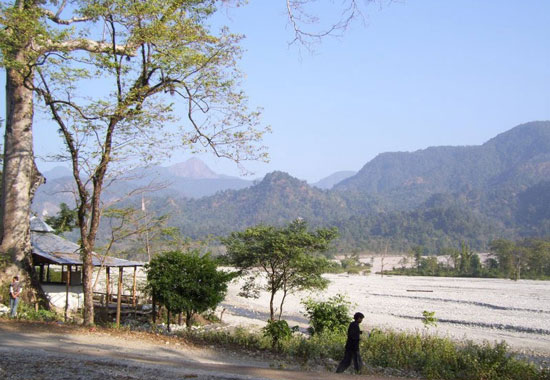
Alipurduar is a municipal city and the district headquarters of Alipurduar district in north Bengal in the Indian state of West Bengal. Situated on the east bank of Kaljani River on the foothills of the Himalayas, the town is a gateway to Bhutan and northeastern states of India.
Alipurduar town and the district is gaining prominence in tourism because of its advantageous location. The town itself does not have much to offer for the tourists. But the surrounding area offers excellent travel attractions within the district. A number of interesting choices are available within a short traveling distance. Dense forests and hills offering beautiful natural landscape surround the town.
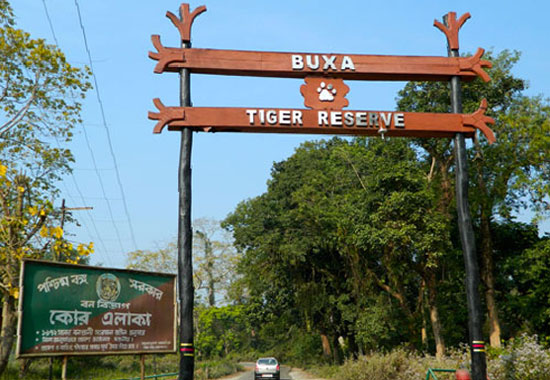
Nearby attractions: Buxa- The most important forest near Alipurduar is Buxa Tiger Reserve (BTR) , which attained much fame all over India for its enormous natural resources in terms of rare flora and fauna. The forest has got the status of a National Park and houses the maximum number of Royal Bengal Tiger Population in North Bengal. The entry point of BTR, at Rajabhatkhawa, is just 12 Kilometers from Alipurduar.
Within BTR, tourists have the option of visiting Jayanti or go to Buxa fort. If you are a little adventurous, you may go up to Lepchakha (A 4 km trek). There are also great trekking options in the area including trek to Sinchula and Rovers Point. The highest peak of Jalpaiguri the Chota Sinchula is located near Alipurduar. At an altitude of 1733m at about 12 km from Buxa the peak offers beautiful sights of the impermeable forest covers of Buxa hills and Bhutan valley.
Other interesting tourist destinations around Alipurduar include Hatipota, Raimatang and others. Chilapata forests are also not very far. Hasimara is about 35 kilometers from Alipurduar and Chilapata forests starts from Hasimara onwards.
Bhutanghat is another popular tourist destination within the Buxa Tiger reserve near Alipurduar. Situated deep inside the forest Bhutanghat is a popular picnic spot as well as good sight seeing option.
Trekking Around-
Alipurduar does not deprive the trek lovers. A day trek to Buxa hill through dense forest track reaches Buxa fort and further up to Rovers Point and then leads to Rupam Valley in Bhutan Hill (2 to 3 days).
Jayanti Mahakal trek is another popular route that leads to a stalactite cave near Bhutan boarder. This trek is also very popular among the pilgrims who visit the cave to offer prayer to their deity.
Best visit time: You can visit the place at any time of the year, except the rainy season as the forest remains close at this time.
Bagora (Kurseong- 60 km. from Siliguri)
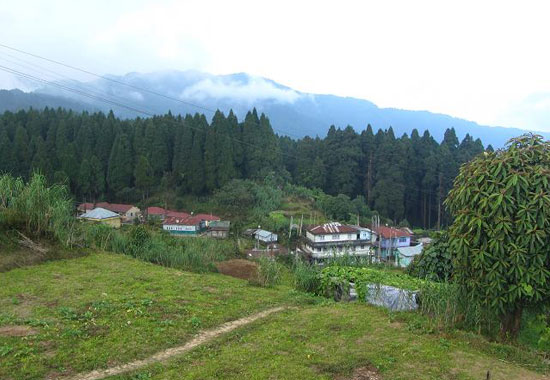
Bagora, a quaint village, located at a height of 7100 feet above sea level, in the Darjeeling district, is not yet explored and hence it still remains unexploited.
You can take a short stroll from Bagora to the Kurseong Air Force base alongside the Tea Gardens. The site offers a spectacular view of the vast stretch of River Teesta and breathtaking views of Mt. Kanchenjungha.
You can always enjoy a nature walk along the scenic landscape of the region. There is also a nice trekking trails from Bagora to Zero point. The place is also a heaven for the avid bird watchers, as Bagora is the home to a wide variety of birds. You can also walk down the shadowy forest trail to Tiger Hill, to watch the spectacular sunrise or plan for a trek of 12-km to Mongpu. If you are planning for more than a weekend in Bagora, enjoy a three-day forest trek from Kurseong to Kalijhora via Bagora, Namthing Pokhri and Latpanchar.

Nearby attractions: Kurseong is just 8 kms from Bagora and most of the sightseeing options of Kurseong like Eagle's Craig view point, Ambootia Temple, Bhangzang Salamander Lake and Giddapahar Seti Mata Temple are all located nearby
Best visit time: You can visit Bagora any time of the year. In March and April, you would find the Rhododendrons in full bloom in the surrounding forests.
Bara Mangwa (Kalimpong – 60 km. from Siliguri)

Perfect place for adventure seekers and nature lovers, the Bara Mangwa Farmhouse perched on a mountain slope amidst orange orchards facing the confluence of Teesta and Rangeet Rivers is the closest you can get to heaven. Located in the Darjeeling district, towards the western side of the Kalimpong hills, in the Teesta Valley, the Bara Mangwa village is home to few terraced farms, local huts and too many orange orchards. But, the real star of this little village is the farmhouse, which offers good accommodation facilities and clean organic food plucked from its own farms. The farmhouse also has its own poultry and a small goat and pig house. Bara Mangwa is a tiny village that gives you the opportunity of experiencing life in its simplest forms in a little and forgotten corner of the Himalayas.
You first have to get down at New Jalpaiguri Railway station and then take NH-31A straight to Teesta Bazaar. From here you need to take left after crossing the Teesta Bridge to reach Bara Mangwa village. From New Jalpaiguri railway station, you need to hire a car to cover your distance. The nearest airport is Bagdorgra Airport.
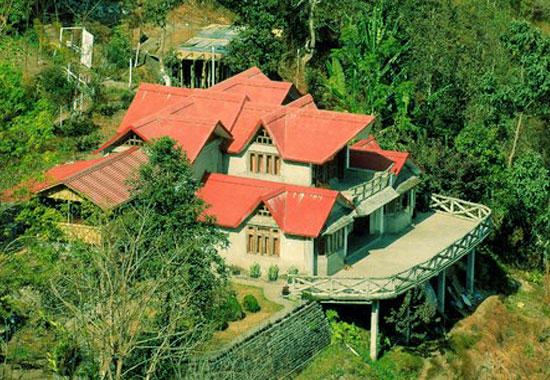
Nearby attractions:There are many places around Bara Mangwa village where guests can visit. Kalimpong is one such place which is located some 21 kilometers from Bara Mangwa. Then there is Lava, which is located some 46 kilometers and is famous for being the entry point to the Neora Valley National Park. Darjeeling, the Queen of the Himalayas is also located close to Bara Mangwa, some 40 kilometers. Other nearby places of attraction includes Chota Mangwa (1 km), Tinchuley Sunrise Point (9 kms), Peshok and Lopchu Tea Garden (15 kms), Tista and Rangit View Point (12 kms).
Best visit time: Winter is the best time to see the best of this beautiful, small village surrounded by hills.
Bees Gaon (Darjeeling – 90 km. from Siliguri)
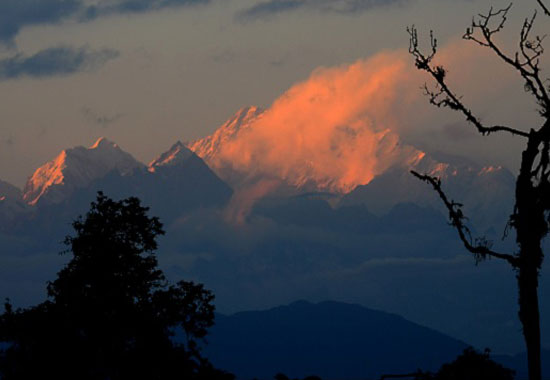
Located within a pine forest, this heritage wood bungalow in Bees Gaon is a hidden treasure just 28 kms from Darjeeling. A walk from the bungalow would take you to a nursery, tea gardens and some more British heritage bungalows. The sparkling weather at 5000 feet and the wilderness of the surrounding pine forest makes the stay in Bees Gaon bungalow a lifetime experience.
You can get shared cars from Darjeeling as well as Ghoom to Beesgaon. If you want "pick-up" services can also be arranged from NJP, Siliguri or Bagdogra.
If you are into bird watching and nature photography, then Bees Gaon will not disappoint you. You can trek through the forests of Beesgaon crossing some makeshift bamboo bridges to discover some rare species of butterflies and birds. If you are planning to do nothing and just sit-back and enjoy nature, then take your favourite novel with you to read while basking on the bungalow's lawn and sipping to fine Darjeeling tea.
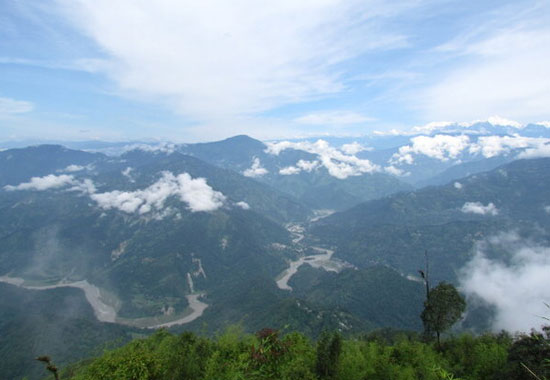
Nearby attractions: Bees Gaon falls on the outskirts of the British Cantonment area of Takdah. You can take a walk to the nearby nurseries and visit some of the British Heritage Bungalows here. The pine forest surrounding Bees Gaon is one its major attractions. You can also visit Peshoke Tea Gardens just 15 kms away or enjoy a days at the orange orchards of Bara Mangwa and Chota Mangwa around 13 kms away.
Best visit time: You can visit Bees Gaon anytime of the year.
Bunkulung (Mirik – 48 km. from Siliguri)

Bunkulung is a picture-perfect Himalayan village surrounded by hills and rivers. With miles of green millet and paddy fields spread over the slopes of the mountains, scores of ponds and water tanks for trout farming and the Murmah Khola and Balasun River crisscrossing the village, you need nothing more to pacify your tired soul. You can take long walks in the nearby tea gardens, enjoy a dip in the rivers and sit and watch the clouds and sun playing hide and seek over the lush green mountains all around. Bunkulung is one of the best examples of ecotourism in North Bengal.
You will never have a single dull moment, during your stay at this exquisite location. If you nurture an adventurous bent of mind, enjoy camping and picnics on the banks of River Balasun or take a dip in the chilly waters of this river. You can enjoy angling in the nearby rivers or indulge in horse riding through the paddy fields, mountains and tea gardens. Enjoy a nature walk along the picturesque landscape of Bunkulung.
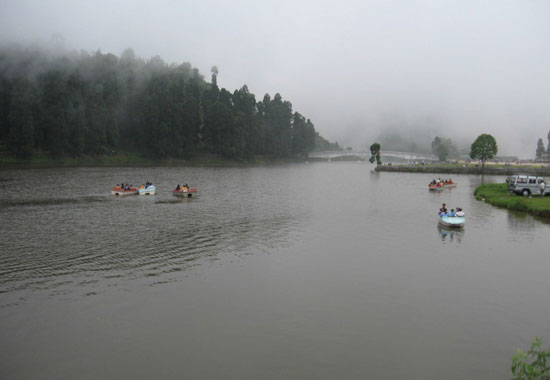
Nearby attractions:You can visit the nearby tea factory and tea gardens in Murmah and Gayabari. You can also visit the town of Mirik just 15 kms away and enjoy a boat ride in the famous Mirik Lake.
Best visit time: You can visit Bunkulung any time of the year.
Chapramari (Dooars – 72 km. from Siliguri)
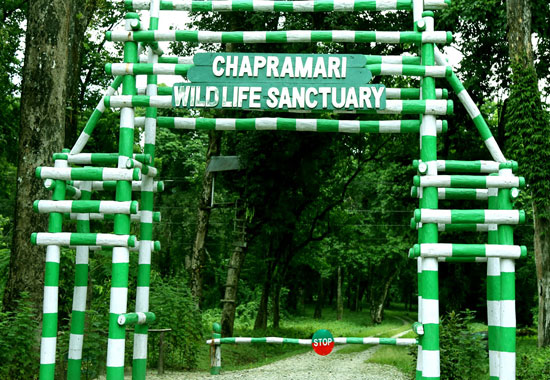
Chapramari Wildlife Sanctuary (formerly Chapramari Wildlife Reserve) is close to the Gorumara National Park. Chapramari is about 30 kilometres from Chalsa and Lataguri in northern West Bengal, India. The total coverage of the forest is 960 hectares.
A large variety of flora and fauna are found in the forests. Chapramari is known for its elephant population. Gaur (commonly known as Indian bison) are not uncommon in the Chapramari region. Deer, boars, and leopards are also found there. However like Gorumara Royal Bengal Tiger are not found here. The place is popular with bird watchers, with parrots, kingfishers, and green pigeons found in abundance.
If you love nature, then this is your place. As soon as you enter the forest, you will see a wide variety of trees like aamloki, rudrapalash, rubber trees, rupasi and others. Bird watching can be a really exciting activity here with plenty of birds frolicking in the trees. You can sit idle on the balcony of the Chapramari FRH with a cup of tea enjoying the forest and the distant hills spotting wildlife around the waterhole and salt lick. In the evenings, you can watch the tribal dance and when the night falls and the Chapramari forest is bathed in moonlight, you can see the Elephant herd munching away the forest foliage beside your bungalow.
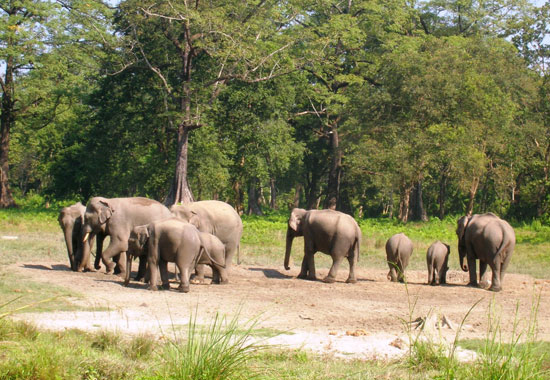
Nearby attractions: There are plenty of tourist attractions around and near Chapramari Wildlife Sanctuary like the Khunia watch-tower which is located within short distance of this sanctuary. Other places to see are the Gorumara National Park and Jaldapara National Forest. The Murti River and Jhalong can also be visited as nearby attractions.
Best visit time: You can visit the Chapramari Wildlife Sanctuary during any time of the year. However, the Forest stays closed to visitors during the monsoons.
Charkole (Lolegaon – 135 km. from Siliguri)

Situated at a distance of 150 km from Siliguri and 39km via - Kahmon 80Km from Lava, the small Lepcha village of Charkhol, popularly known as Lolegaon, is a paradise on earth in all true sense. The nature has abandoned all its wealth in this solitary land placed at the lap of the Himalayas at an altitude of 5000ft.(Approx).
As the first rays of the dawn kisses the crown of the Kangchenzonga, Charkhol Lolegaon unfolds its enthralling charm with the widest view of snow-capped range around. Situated amidst the deep, moist woods of towering pine, cypress, oak and rhododendrons, Charkhol Lolegaon can boast of its serene tranquility, which is, at time and again, pierced by the cheerful chirpings of innumerable known and unknown birds.
Numerous species of butterflies, a wide variety of flowers and orchids spread riot of colors in the surroundings of Lolegaon much to the joy and visual satisfaction of a beholder. The spectacle of scintillating sunrise or sensuous sunset from the nearby hilltop of Jhandi Dara is an experience of the lifetime. On clear days even the mighty Mt Everest is visible from the spot.
Lolegaon offers quite a few short trek routes and excursion points too. A trek to Samtahar ; excursions to Kafer (15Km), Lava (39Km), Rishyap (30Km), Pedong(50Km), Rishi (30Km from Pedong), Rikisom (53Km) and Gumba Dara (29Km) make holidays at Charkhol Lolegaon cherishable for lifetime.
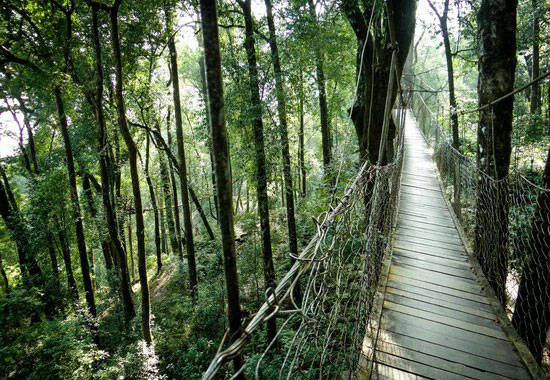
Nearby attractions: The most lucrative attraction at Lolegaon is however, the famous 'Canopy Walk' along the hanging wooden footbridge amidst the huge pines and oaks, which gives the enthralling feel of the surrounding beauty and widerness.
Best visit time:You can visit Charkole anytime of the year but the snow capped Himalayas are best viewed during the winters.
Chatakpur (Ghoom – 74 km. from Siliguri)

Located at an altitude of 7,887 feet, Chatakpur is a paradise for nature lovers as one can get a spectacular view of the imposing mountain range of Kanchenjunga and at the same time experience the overwhelming lush green forest in a quiet village setting with a population of only around 90 people and 18 village houses.
Tourists can climb rock faces or avail the trekking routes both downhill and uphill that lead to various destinations. They can also climb the watchtower to view the sunrise or take a panoramic view of Sandakphu. You can also spend time at the Pokhri (Pond). Bird lovers can spend their time watching birds and tourists can even enjoy the breathtaking view of Mt. Kanchenjunga from nearby or enjoy the folk dances performed by local people. Pick your vegetables from garden fresh organic orchards, feed and even milk the cattle. You can also enjoy the company of story tellers. A generation still exists to share the experience of myth, culture and traditional values.
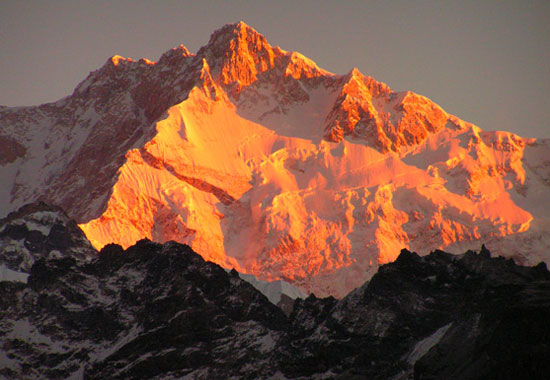
Nearby attractions: You can visit the Tiger Hill or other places that are situated nearby such as Jorebungalow, Ghoom and Sonada. Darjeeling is the nearest popular tourist destination of Chatakpur. You can enjoy a number of small treks to Tiger Hill, Rimbi village, Sixeen village, Labda. Most of the trekkinmg trails run through the wild life sanctuary and you would be accompanied by our expert guide.
Best visit time: You can visit Chatakpur year round except in the monsoon season (July to mid September) when it is not possible to explore the forest. The tourist eco village resort remains closed during this time. Winter time between November to February can be extremely cold. So bring adequate winter clothing during this time.
Chibo (Kalimpong – 65 km. from Siliguri)
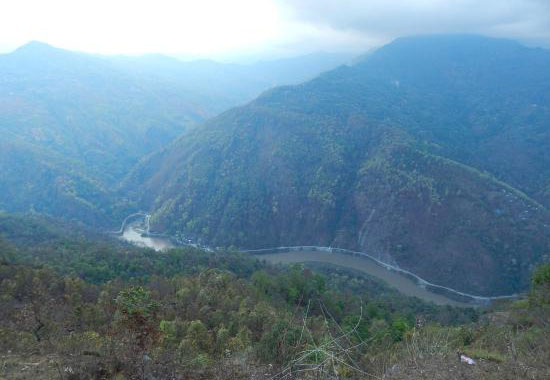
Chibo is a new tourist destination just 4 kms from Kalimpong. Mountains have always been a wonder for tourists. Chibo claims an average altitude of 4100 feet and is a pristine hill village in the Himalayas located on a ridge, offering spectacular views of the Mt. Kanchenjungha and the surrounding forests and foothills.
Nature always brings peace of mind. Relax, Drink coffee or tea enjoying the cool and sweet breeze. Let your children run about with full energy. Sink into the panoramic beauty of changing colours on Mt. Kanchenjungha during sunrise and enjoy a fascinating sunset too. Chibo is among the very few places from where you can enjoy sunrise and sunset.
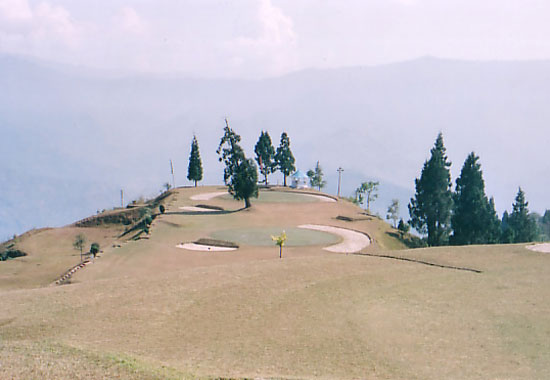
Nearby attractions: Forests and wild flowers all around make Chibo a small paradise tucked along the slopes of Himalayas. A cactus garden in front of a local village house is just lovely to look at. Chibo has wonderful greenery surrounded by the tall pine trees (locally known as Dhupi) and colourful flowers. The chirping birds and the fresh air of Chhibo makes it an ideal weekend destination to rest and bask in the morning sun.
Best visit time: Chibo welcomes tourist round the year. Winter is the best time for viewing Mt. Kanchenjungha.
Chilapata (Jalpaiguri – 20 km. from Alipurduar)

The Chilapata Forest is a dense forest near Jaldapara National Park in Dooars, Alipurduar district, West Bengal, India. It is about 20 km from Alipurduar, and just a few minutes away from Hasimara town. Until recently, the area was known for dacoity (banditry), but it is now safe for tourists.
West Bengal State Forest Development Agency (WBSFDA) runs an eco-tourism resort at Kodalbasti, providing basic accommodation.
One of the main attractions is the ruined "Nalraja Garh", or fort of the Nal kings, built in the Gupta period in the fifth century C.E., the Golden Age of India. Although poorly maintained, the site has considerable archaeological interest. Other activities include Tonga rides through Mathura tea garden, boating on the Bania river and angling on the confluence of the Kalchini, Bania and Buri Basra.
Chilipata is a Wildlife Sanctuary and a National Park. It is a hub of wild animals. Nature walks in nearby forest, bird watching.
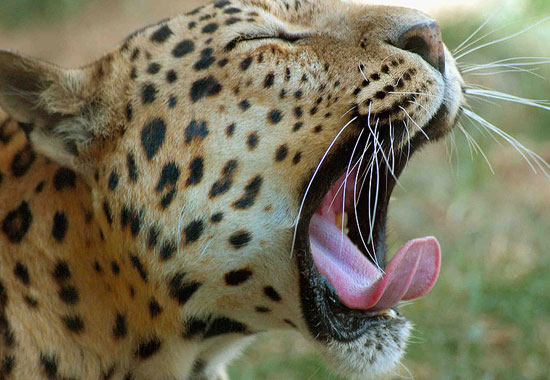
Nearby attractions: Chilapata offers you a drink to the pure pleasures of nature in its every artifice. The surroundings of Chilapata hold an irresistible attraction with tourists.
Best visit time: Many of North Bengal areas remains in beautiful atmospheric condition from the month of September to the month of February.
Chimney (kurseong – 58 km. from Siliguri)
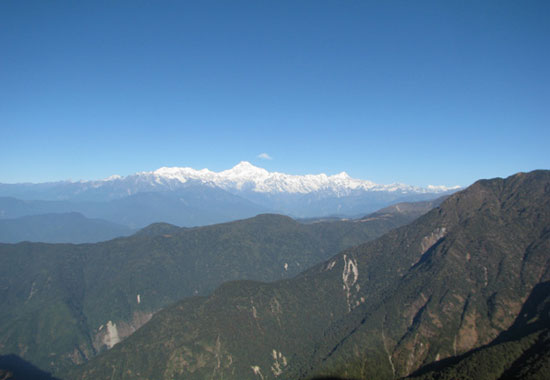
One of the best ways to explore the villages and local culture in Kurseong is to take a taxi and ask him to take you first to Bagora and then to the village Chimney. Bagora is a small village located at the highest altitude (7,150 ft) of Kurseong sub division. The taxi will take the Hill Cart Road and go towards Darjeeling for about 25 minutes and then take a right turn at Dilaram. An uphill narrow road leads up to Bagora in another 15 minutes or so. The total distance is about 17kms from Kurseong. The quaint village is well known for its variety of birds, forest of oak and pine and of course the rhododendrons. In winter, you can see oranges as well.
Explore the little village of Chimney and savor its natural beauty. You can take a nature walk along the scenic landscape of the region, the forests and tea estates. Chimney is also an ideal location for the trek enthusiasts. You can trek from Chimney to the Mahananda Waterfall. You can also arrange a picnic in any scenic spot on Chimney valley and enjoy your day.
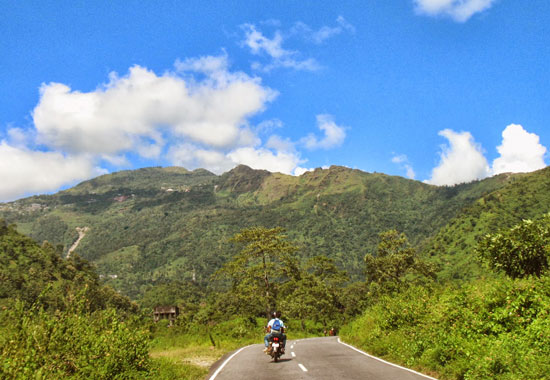
Nearby attractions: While touring Chimney, do not miss the greatest attraction of the place, which is a 100-year old 23-foot high brick chimney built by the British. It was probably built during World war I. The region adjoining the chimney offers a splendid view of the Nathu-la and Kalimpong and you can also savor a view of Mt. Kanchenjunga from here. The village of Chimeni is located on a valley and it is surrounded by pine and cedars.
Best visit time: Chimney welcomes tourists all through the year. However, it is better to avoid the rainy season.
Chota Mangwa (Kalimpong – 61 km. from Siliguri)

The idea of spending few days in Darjeeling was dropped, the broken roads, the overdose of tourists, shortage of water and most importantly the weather was not as usual. Everything was just not working right. It was truly not the Darjeeling I knew. It was humid and hot. Very unusual at this time of the year. Just no rains…although remained cloudy throughout the day. So I decided to disappear to an obscure exotic location in and around the hills of Darjeeling. Little confused as to where to go, I quickly called up a person I met in Facebook and since then we are friends. He is an ardent traveler and lover of nature and wilderness. He suggested I go to Chota Mangwa.
Chota Mangwa is one and half hours drive from Darjeeling and can also be reached via Teesta bazar from NJP/Bagdogra. From Darjeeling it took us about 40 minutes to cross Ghoom and then take a left turn from Jorebangla. Drive up to 6th-mile and then take a right turn to proceed down towards Takdah which is about 8kms from here.
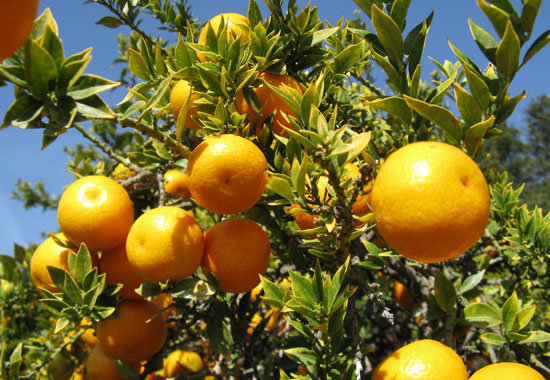
Nearby attractions: Take a stroll through the nearby Takling village. There is an old monastery here.
Take a nature walk through the mountain forests and many orange orchards. You are allowed to pick up the oranges that fall off to the ground and savor the natural juices.
Visit the wonderful Rungli Rungliot Tea Garden in Takdah.
Lopchu is another small village and located close by. You can visit the orange juice manufacturing unit here and see how the juice is produced.
Bara Mangwa, where the Darjeeling Blossom Ecotourism Complex has a few other cottages, is located about 12kms from Chota Mangwa.
Tinchuley and Kalimpong are also within short driving distances.
If you want to try out white water rafting, go down to Teesta or river Rangeet. There are several tour operators who organize such watersports. Talk to Mr. Pradhan and he will help you out.
Best visit time: If you want to see the orchards full with oranges, the best time to visit Chota Mangwa is between October and February. Even otherwise, it's always a great time to visit this lovely quiet village and enjoy the nature. Monsoon time is considered off season.
Dara Eco Village (Kalimpong – 58 km. from Siliguri)

Dara Eco Village is perched on a mountain slope amidst orange orchards facing Mt. Kanchenjungha and River Teesta. Located ahead of Teesta Bazar towards the western side of the Kalimpong hills, in the Teesta Valley, the Dara Eco Village is home to few terraced farms, forests and too many orange orchards. But, the real attraction of this little village is the 105 year old Heritage house. Completely made of wood, this century-old home still has the earliest wood foundations, door arches, staircases, wooden floors and khirkis intact.
You have a lot of opportunities for activities at Dara Eco Village. Trekking and bird watching are abundant and so is river rafting in the waters of Teesta. Angling can be enjoyed in Teesta just 08 kms away. You can always take a nature walk along the forest trails to the nearby Chortens on the hill top.

Nearby attractions: While staying at Dara Eco Village, you can visit Kalimpong just 24 kms away. The major attractions of Kalimpong include the Durpin Dara Monastery, Delo Park, the various Cactus gardens and off course its markets. If you want to tread the uncharted path, then the forests of Tinchuley and orange orchards of Chota Mangwa can be visited too.
Best visit time: In the winter season, the orange garden is full of oranges and in summers, the chill in the wind will give you the much awaited respite from the sun baked plains.
Darjeeling ( 80 kms from Siliguri)
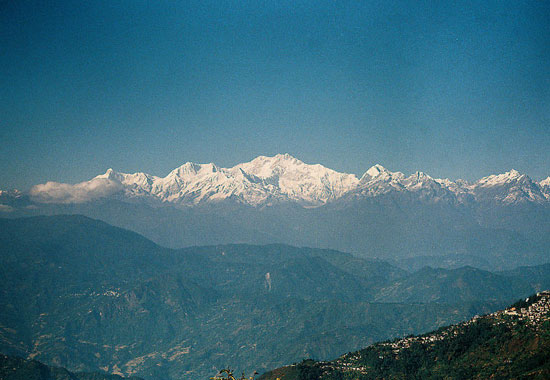
Darjeeling is a town and a municipality in the Indian state of West Bengal. It is located in the Lesser Himalaya at an elevation of 6,700 ft (2,042.2 m). It is noted for its tea industry, the spectacular views of Kangchenjunga, the world's third-highest mountain.
Darjeeling is an ideal site to eat, drink, shop, hike and trek. Here some options:
Tenzing Norgay Rock (Mountain Climbing): Visitors to the Tenzin Norgay Rock, located on the northern fringes of Darjeeling, are able to avail rock-climbing sessions for various durations of time. As mentioned previously, this facility is also available at the Himalayan Mountaineering Institute.
Toy Train Ride: Riding on the Darjeeling Himalyan Railway (also known as the "Toy Train"), is a wonderful experience for tourists interested in Darjeeling's colonial history. Powered by a steam engine, it retains the old-world charm and a certain old-fashioned appeal. Being situated at an altitude of almost 2,200 feet, visitors also witness the rare opportunity to go on a train ride at such a high elevation.
Mountain Biking: Nature lovers and adventurers will certainly enjoy the various mountain biking tracks available. Mountain biking offers visitors an excellent opportunity to interact and be one with nature, as well as get that much-needed adrenaline rush. It also gives visitors the chance to explore Darjeeling's natural beauty at their own pace and leisure.
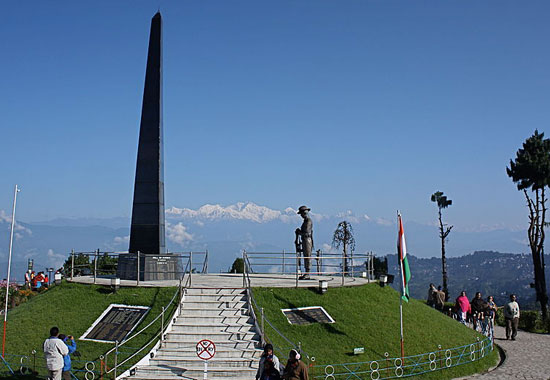
Nearby attractions: Tiger Hill, Batasia Loop, Observatory Hill, Happy Valley Tea Garden etc.
Best visit time: The most preferred time to visit Darjeeling is between mid-March to the end of May as well as during October and November.
Delo (Kalimpong – 68 km. from Siliguri)
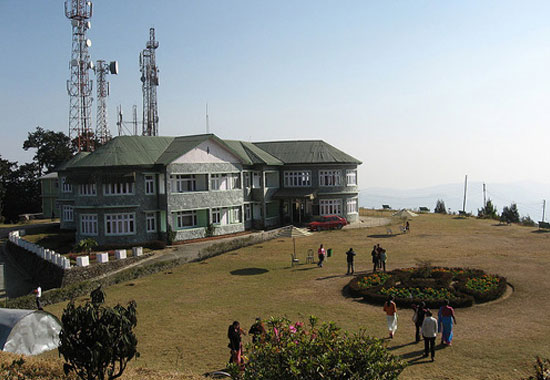
Delo or Deolo is located at an altitude of 5556 ft on the edge of a reef connecting Delo Hills and Durpin Hills. This beautiful nature park offers one of the best views of Mt. Kanchenjungha and River Teesta. Delo has been converted into a nature park by the Government and there are Government accommodation options within the park as well as luxurious private accommodation options outside the park. The main town of Kalimpong is only 6 kms from Delo Hill.
If you are longing to de-stress then enjoy the gardens, the mesmeric views, hot coffee at the bungalow and take short treks and nature walks around Deolo. It is the best place to unwind yourself. If you are adventure lover, then you have opportunities to paragliding from Delo.
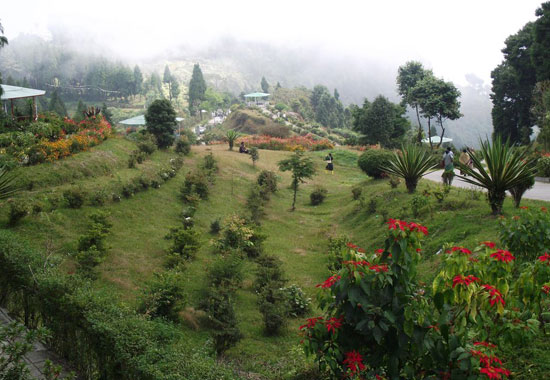
Nearby attractions: The most popular nearby attraction is Lava. Located some 30 km from Kalimpong, Lava is popular for its closeness to Neora Valley National Park. Then there is Pedong, some 20 km from Kalimpong which is a beautiful tiny settlement amidst pine trees, Lolaygaon, (54 km from Kalimpong) which offers some spectacular views of Mt. Kanchenjunga and off course Darjeeling just 56 km from Kalimpong, is often called 'Queen of Hills' and is the most popular tourist destination in northeastern India.
Best visit time: The best time to visit this place is from March to May and from September to January.
Dhupjhora (Dooars – 75 km. from Siliguri)
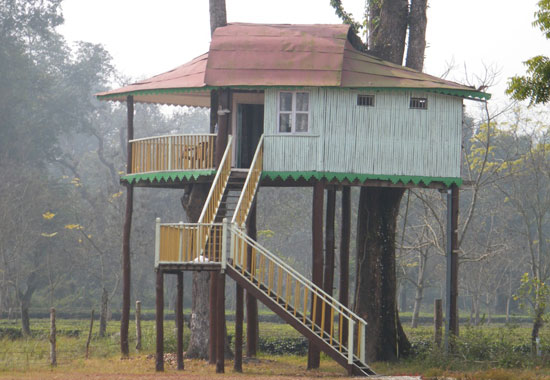
If you plan to watch Rhinos, wild elephants and Bisons face to face this weekend then a trip to Dhupjhora Elephant Camp in South Gorumara this weekend could be your choice. Dhupjhora Elephant Camp is a unique concept of eco tourism where the tourists get a chance to feed the Forest Department's elephants, give a bath to them in Murti River and ride on them to the deepest parts of the Gorumara jungle to catch a glimpse of the wildlife.
This is an Elephant Camp where the Forest Department's elephants are kept and cared for. These jumbos regularly check out the forest with their mahouts and forest guards for injured animals and miscreants. After completing their job they take the tourists staying at their camp for jungle safari. Tourists can enjoy elephant safari everyday either in the evening or morning. Crossing the Murti River on elephant back and entering the Gorumara Range is a unique experience.
The elephants are brought to the Murti River for their daily wash around 3:00 pm and tourists can join the mahouts to scrub and wash these gentle giants in Murti River. After their bath in the river, these elephants have their meal, where tourists also get a chance to feed them. Your entire stay in Dhupjhora Elephant Camp would involve close encounters with these gentle giants and the more you come to know about these huge animals the more fascinated you would become. Tourists can also visit a nearby carpet factory, roam around the adjacent tea garden or take a dip in the Murti River. A tribal cultural program is held every evening for the tourists within the Dhupjhora Elephant Camp.
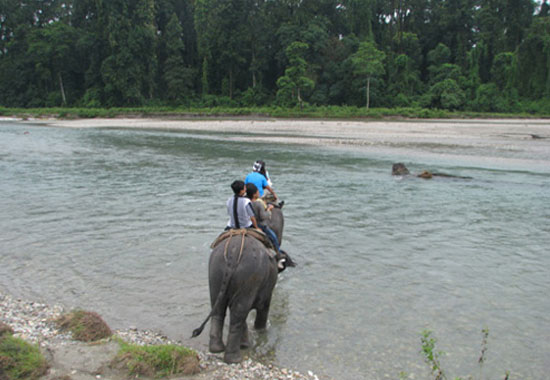
Nearby attractions: The entire Dooars range of jungles like Chapramari, Chalsa, Neora Valley, Chukchukia, Jaldapara and others are located nearby.
Best visit time: October to March is the best time to visit the Dhupjhora Elephant Camp. However, the camp stays open throughout the year and arranges elephant safaris to different parts of the jungle. In the rainy season, most parts of the jungle stays out of reach for the tourists so the safari is held in selected areas of the jungle.
Dilaram (Kurseong – 45 km. from Siliguri)

Guarded by a private forest on one side and lush green tea gardens on another, Dilaram is a little village tucked within nowhere in the Kurseong Hills. Here, you can take long nature walks, enjoy birdwatching, take a tea garden tour or visit a tea factory. But, the best thing to do in Dilaram is to do nothing but sit and watch the shadows of the clouds move across the deep valleys, slopes and tea gardens of Mirik, Sandakphu and the adjoining hills.
Take a walk in the lush forest of Magnolia, Chestnut and cardamom plantations surrounding Dilaram. Bird watching is another activity you can undertake. Dilaram is surrounded by tea gardens and you can take a tea garden tour and visit a local tea factory to see tea processing. You can also pluck a few handfuls of tea leaves if you want. A village walk around Dilaram to watch the daily chores of the villagers can also be rewarding. For the more adventurous, a full day trek can be organised to nearby Chatakpur View point.

Nearby attractions: You can also visit the famous Margaret's Hope tea estate, which produces some of the finest tea varieties in the world. Sitong – the orange village, the forests of Chatakpur, Balasun Tea Estate, Chimeny, Bagora and Kurseong are all located within 10 kms of Dilaram. You can also visit Mirik, Rangbang or Darjeeling in a day trip from Dilaram.
Best visit time: The winters bring lots of birds and butterflies to Dilaram. Treks and peak watching can be best enjoyed during winters.
Doban (Rorathang – 84 km. from Siliguri)
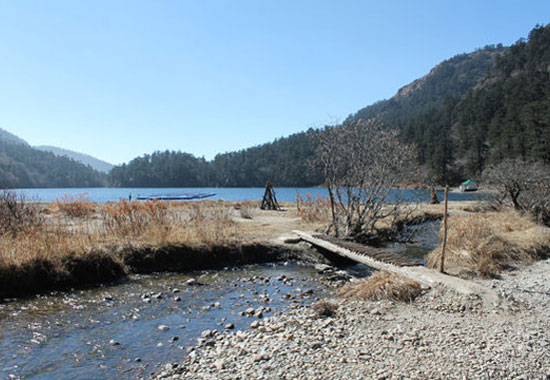
If you are waiting for a lovely destination in North Bengal to have a great weekend with your beloved ones – Doban can be your choice. In Nepali – "Do" means "two" and "Ban" means "to tie", so Doban refers to the tying of two rivers. This lovely new spot in the Kalimpong sub division is located at the confluence of two rivers, Rangpo River and Reshi River.
Doban is surrounded with dense forest and grasslands and is home to a huge population of migratory and residential birds. The golden gleam of sunrise is undoubtedly awesome. You will just appreciate the rivers in moonlit night under the starry sky. It looks like a silver necklace lying on a green patch of land. After a hearty breakfast you can go out for a short nature trek to the surrounding forests.
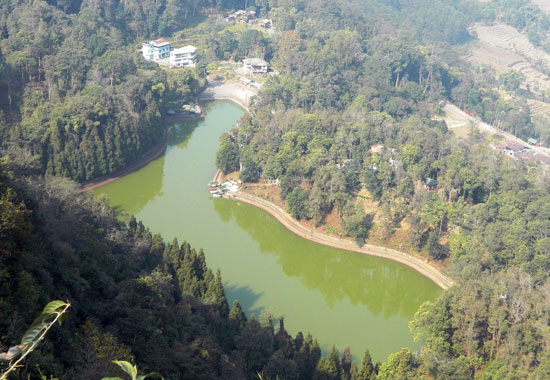
Nearby attractions: Tucked within lush forests, Doban is a grassland teeming with birds. The two rivers – Reshi and Rangpo meet here to create this picturesque landscape. You just need to cross a wooden bridge across Reshi River to reach Doban. Spending a day in Doban lazing around the grasslands and forests after your stint with the high-altitude passes and lakes in the Silk Route, would be a rejuvenating experience.
Aritar – another attraction of this route is just 18 kms from Doban. Aritar is famous for a number of reasons – among which the "boot-shaped" Lampokhari Lake and the British Bungalow built in 1896 steals the show. Also, do not forget to visit the monastery and a view point in Mankhim with a panoramic view of Mt. Kanchenjungha.
Best visit time: Doban remains closed during the rainy season from June to September when the river water rises. Rest of the year, Doban welcomes guests with all its beauty. The winters bring in the migratory birds and the spring brings some sparking weather.
Fagu Tea Bungalow (Gorubathan – 75 km. from Siliguri)
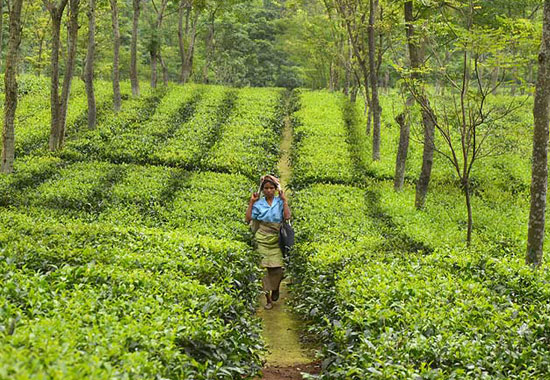
The majestic colonial Tea bungalow of Fagu is located about 20 kilometers from Malbazar near Gorumara National Park. Located atop a hill, the sloping bungalow is the perfect retreat for those who are looking for an experience of the old stately colonial period. The Bungalow reflects every bit of British dignity in its grand furnishing and exquisite savor. The bungalow is located beautifully in the middle of sprawling tea plantation that is surrounded with fertile forest vegetation with the splendid Himalayas in the background.
With so many activities lined up, you will never experience a single dull moment in Fagu. You can enjoy a riverside picnic if you want to spend some quality time with your family and friends. Bird watching is another popular activity in Fagu. Guided tours are also organized in the tea estate, which also includes a visit to the tea factory at Fagu, where you can watch tea plucking, tea processing and tea tasting. The place is also ideal for enjoying a nature walk or a trek to various nearby forests, waterfalls and mountain villages.
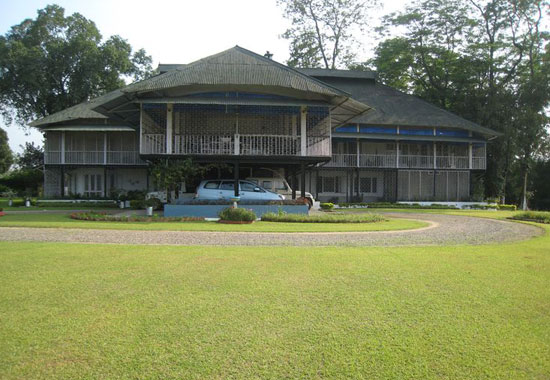
Nearby attractions: The prime attraction at Fagu is the Tea Plantation area built during the colonial period. The vicinity surrounding the tea estate is covered with beautiful forest area and gorgeous flower gardens. One can go for lovely long strolls along the estate routes to experience the freshness of the place. The prominent heritage building here is the British tea bungalow that is simply breath-taking with its gorgeous green lawns and flower gardens.
Apart from this, one can also visit other places of interest near fagu that includes the Gorumara National Park, Lava, Rishyap and Kalimpong. An ancient Buddhist Monastery, Suntaleykhola village, the Sevoke Coronation Bridge, River Teesta and the Rock-Garden are also some of the attraction located near Fagu.
Best visit time: The Fagu Tea Bungalow welcomes tourist all through the year.
Gahunbari (Dooars – 98 kms from Siliguri)
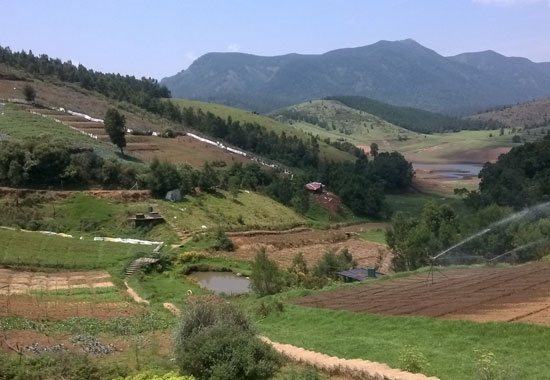
Gahunbari is a tourist destination nestled in Dooars in the Indian state of West Bengal. Gahunbari is locally known as Gaobari. It is situated close to the border of Bhutan and Sikkim near the Bindu - Jhalong area. This tourist destination is known for scenic beauty adorned with lush greenery. The main highlights of this place are Chapramari forest, Gorumara National Park, Jaldhaka River and glimpse of Mt Kanchenjunga.
You can take a tour on foot along the dam built across the Jaldhaka River. You can also explore the forest of Chapramari in-group. Take the fresh unpolluted air of the pristine location. You can also experience a chill breeze blowing directly from the direction of the ice-covered Tsomgo Lake in Sikkim. However, this is not a very common phenomenon.
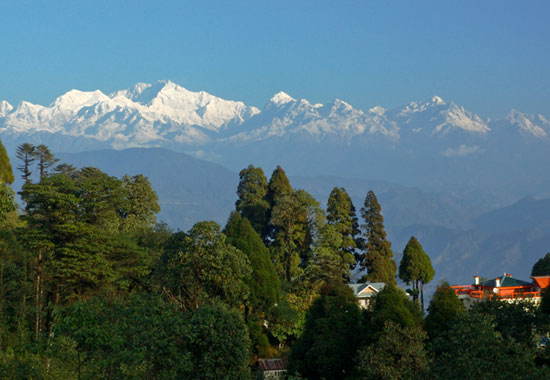
Nearby attractions: Known for virgin beauty, this place of North Bengal provides the tourists ample opportunities to enjoy their vacations in the lap of nature. This place and its neighboring areas are home to various tourist attraction sites. There are Chapramari forest and Gorumara National Park in the vicinity which are home to several wild animals. Tourists can also explore the forest of Chapramari in-group. Gorumara is especially known for housing Indian rhinoceros. These two are ideal places for the wildlife lovers. Then there is the pristine Murti River and few kilometers away there is the district of Jhalong, popular for providing camping facilities. Jhalong is also popular for housing Jaldhaka Hydro Electricity Project on the Jaldhaka River. People can take a tour on foot along the dam and enjoy a varied collection of hill birds hovering in the area.
Another well-known attraction site is Bindu, a border town nestled between Bhutan and India. Like Jhalong, this place is famous for housing the dam across the Jaldhaka River. In the vicinity there is a view point from where people can enjoy viewing the glimpses of wide stretch of dense forest and forested hills.
Apart from this, the tourists while heading towards Gahunbari from New Jalpaiguri can enjoy sightseeing. People can have a glimpse of the splendid Mt Kanchenjunga and the foothills of the Himalaya. While driving along the roadway, the lush green tea gardens on both sides of the road are also a treat to the eyes.
Best visit time: Gahunbari attracts tourists round the year.
Garuchira (Terai – 80 km. from Alipurduar)
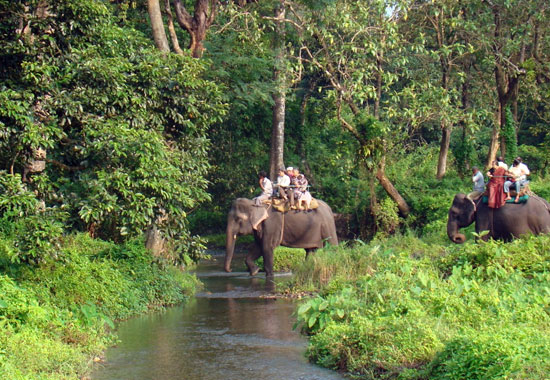
Garuchira village eco tourism is a brilliant initiative of the government to assist development in the hilly region of north Bengal. The government bungalow as part of the tourism is located in Bandapani Bil, Dalgaon Range of Jalpaiguri Forest Division. Garuchira is located at a distance of 80 kilometers from Jalpaiguri and is a beautiful place surrounded by rivers. The eco tourism spot is a lovely one with elephants making rounds of the place. Its position in the foothills of Bhutan gives it a special place in the heart of the tourists. The peaceful ambiance and the vast greenery attract tourists to this heavenly place.
You can take a tour of the jungle with your guide and stay in the forest bungalows. Wild elephants are the main attractions of Garuchira Forest.
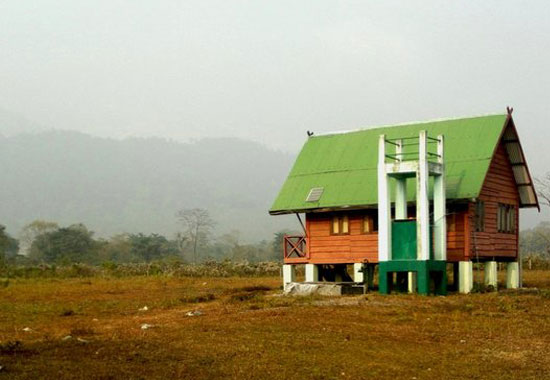
Nearby attractions:Garuchira eco spot lies between the holy Supti and Reti Rivers making the land fertile and adding to the charm of the region. Fresh air, lot of greenery and peaceful atmosphere works wonders on the mind and soul of the visitors. The forest is full of Saal and Teak trees which you can explore with the guide. There is a watchtower at the eco spot from where you can frequently spot elephants. Garuchira serves as the gateway to the elephants from the neighboring land of Nepal. During the rainy season the rivers overflow and it looks extremely beautiful.
There is also a children's park at Garuchira eco spot and also a man-made tank full of fish. You will find various species of colorful fish swimming inside the tank and holding your attention. For the adventure loving souls you can follow the trekking trail around 10 kilometers from the forest and reach Bhutan Hills. There is a monastery and a cement factory at Gomtu in Bhutan which is only 5 kilometers from Garuchira. Also visit the kali Temple in Makrapara close to Gomtu. Experience sheer bliss in these lands among the local village people and the wildlife free from your worries.
Best visit time: Avoid the rainy season.
Gour (Malda – 375 km. from Kolkata)
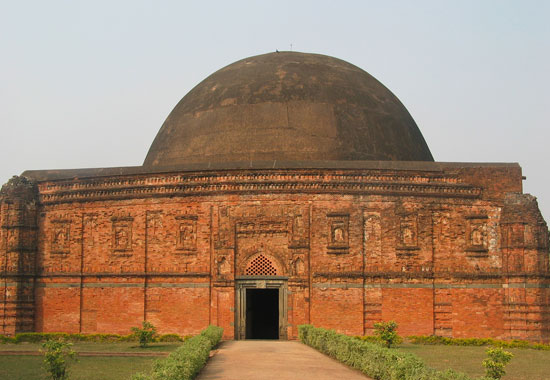
If you are historically inclined, then the city of Gour, drenched with history, is your ideal holiday destination. Nestled near the west bank of River Ganges, this historical city is situated around 40 km. downstream from Rajmahal, in the district of Malda of West Bengal.
Gour is directly accessible from Malda by both roadway and railways. Moreover, direct flights are also available from Kolkata to Malda.
Explore the city of Gaur admired with a number of significant historical places and archaeological sites. You can also enjoy a trail along the forest, encircling the entire region.
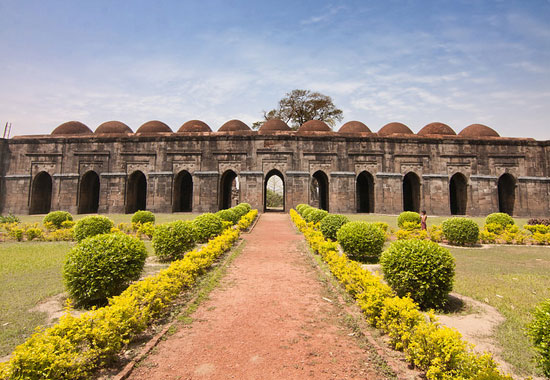
Nearby attractions:You can highly organize a tour to the old city of Malda, located at the converging of two rivers. Visit the Mala town located 4 km. away from the Old Malda. The major attractions of the Old Malda city are the Nimasari Tower and The Jami Masjid.
Best visit time: You can visit Gour any time of the year.
Holumba Haven (Kalimpong – 70 km. from Siliguri)
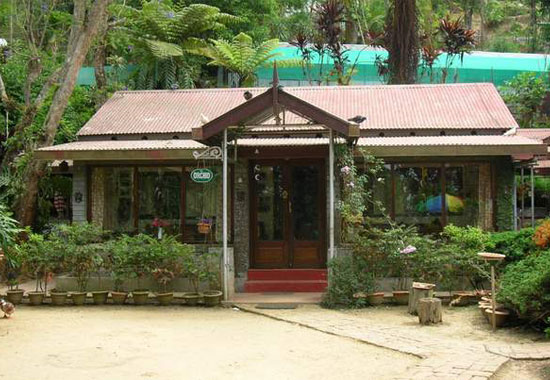
Holumba Haven is a botanical extravaganza with natural landscape. It sprawls over an area of two acres and faces Mt Kanchenjunga. The homestay resort itself is a small world of flora with more than one thousand species of plants and orchids.
Rafting is done on the Teista river. Trekking into the Neora Valley National park. Nature walks to nearby local villages like Gumba Dara, Gitdubling – Budhabare & Suruk – Shamthar. Sightseeing of Kalimpong and Delho viewpoint, Durpin view point. Holumba Haven organizes transport, trekking, tours, river rafting, cultural entertainment and cycling in or around Darjeeling, Kalimpong, Bhutan and Sikkim for its guests.
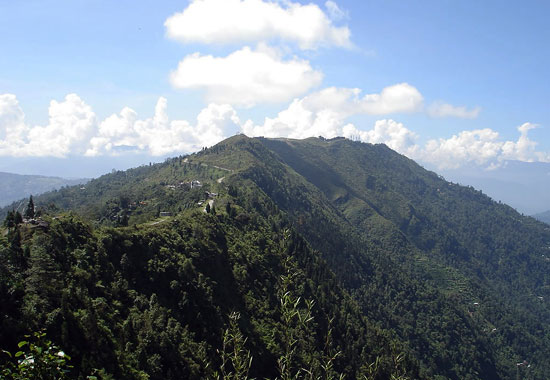
Nearby attractions: Sightseeing in and around Kalimpong town. Monasteries, Temples, Churches, Floricultural nurseries and Tibetan handicrafts shops. Gangtok and Darjeeling can be easily reached by car.
Best visit time: You can visit time September to March.
Icchey Gaon (Pedong – 84 km. from Siliguri)
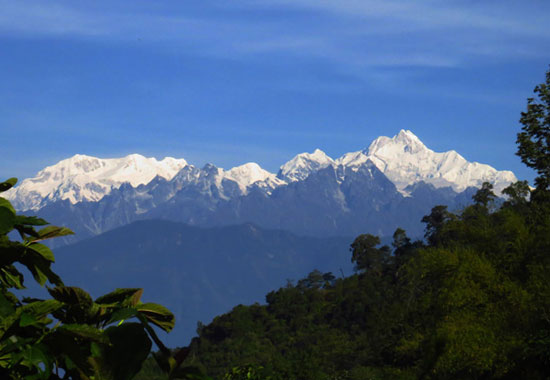
Icchey Gaon is a pristine Himalayan hamlet tucked within the pine forests of Kalimpong with a panoramic view of Mt. Kanchenjungha. Nestled at an altitude of 5800 feet, it is the perfect place for those nursing the soul of a nature lover. With numerous nature trails and short treks starting off from Icchey Gaon to viewpoints like Ramitey Dara, Tinchuley and Jalsa, it is one of the best-kept secrets of this region. The evenings at Icchey Gaon become very exciting when lights of Darjeeling, Ravangla and Namchi twinkle all along the slopes of the mighty Himalayas. Presently, there is only one modern homestay equipped with electricity and attached western bathrooms to accommodate guests. The homestay also arranges transport for sightseeing to Delo, Pedong, Sillery, Lava, Reshikhola and other destinations.

Nearby attractions: There is a beautiful hilltop called Tinchuley near Icchen Gaon, which offers a panoramic view of Mt. Kanchenjungha, the towns of Sikkim, Jeep La and Nathula. You can drive to this hilltop or trek to the spot. Another captivating sightseeing destination is Ramitey Dara, a renowned vantage point, which presents a wide view of the meandering River Teesta, featuring 14 turns along with the mighty Kanchenjungha range. A visit to the Damsang Fort is also must for all tourists. The fort resides 6 km away from the Icchey Gaon. Built in 1690, by the Lepchas, this fort was destroyed by the British, after the Anglo-Bhutan War of 1864. So, only the remnants of the fort exist now. The breathtaking beauty of the Silence Valley, small grassy woodland offers the ultimate tranquility. A trip to the famous Jalsa viewpoint, located 4 km away from Icchey Gaon is another celebrated spot within the Cinchona plantation and a British Bungalow. The site offers one of the widest view of the Teesta River and a gorgeous view of the Mt. Kanchenjungha range.
Destinations like Reshi, Pedong, Aritar, Mankhim and Sillery Gaon are all located near Icchey Gaon. One of the most celebrated tourist attractions of Icchey Gaon is the Sangchen Dorjee Monastery, located near Pedong. The ancient section of the monastery is adorned with some beautiful wall paintings, depicting Tantrik Buddhism. The major attraction of the new section is the mummified body of the most revered Bhutanese priest. A visit to the Cross Hill near Pedong, built by Fr. Augustine Desgodins in 1882 is also quite rewarding. It stands beautifully, overlooking Nathula and Jelep-La and is highly revered as a site of Pilgrimage for the local Christian Community. Do not forget the 'Shahid Park', located 2 km away from Pedong Bazar. There is a memorial stone in the park, which has been laid to pay honor to the memory of local young soldier of Indian army, Late Palender Raj who sacrificed his life at Thangdhar J & K sector (Kargil War). The park offers wonderful view of Sikkim on the opposite side.
You will fall under the spell of ecstasy of Kashyone village, located 8 km from Pedong Bazaar. The wonderful view of the union of Teesta River and Rongpo Khola, just behind the village is truly awe inspiring. Nature admirers can also visit nearby Ranibon that has been declared as a preserved forest. The place also houses a 300-year old Lepcha house, which is the only specimen, showcasing the delicate Lepcha craft works. Trips to Reshi Bridge and Reshi Khola from Icchey Gaon are also quite rewarding. Rishi and Mudum Khola join to form Rishi Khola. The natural beauty of the place is truly amazing. The Aritar Lake or Lampokhri is a beautiful eco tourism spot, located 16 km from Rishi Bridge in East Sikkim. The highest point of the location, popularly called Mankhim offers a mesmerizing view of Mt. Kanchenjungha on the southwest and Jelep La and Nathu La towards the northeast. Another celebrated viewpoint at Aritar is Love Dara. Regular day trips are also arranged from Icchey Gaon to Dello Hanuman Park, Loleygaon, Lava, Rishap and Sillery gaon.
Best visit time: Icchey Gaon attracts tourists round the year. In winter, you can savor an amazing view of the entire Mt. Kanchenjungha range and in monsoons the whole region is covered in lush greenery, wild flowers, gushing steams and waterfalls.
Jaldapara (Jaldapara Wildlife Sanctuary – 140 km. from Siliguri)
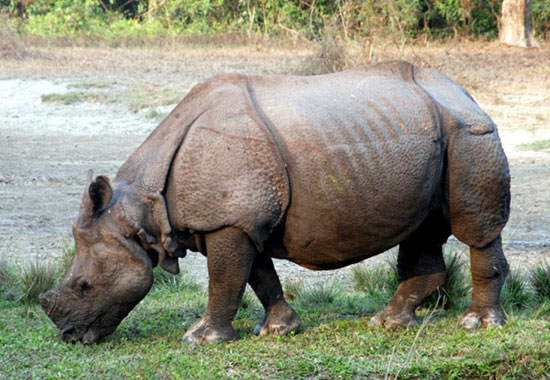
Jaldapara National Park (formerly Jaldapara Wildlife Sanctuary) is a national park situated at the foothills of the Eastern Himalayas in northern West Bengal and on the banks of the Torsa River. Jaldapara is situated at an altitude of 61 m and is spread across 216.51 km2 (83.59 sq mi) of vast grassland with patches of riverine forests. It was declared a sanctuary in 1941 for protection of its great variety flora and fauna. Today, it has the largest population of the Indian one horned rhinoceros in the state, an animal threatened with extinction, and is a Habitat management area (Category IV). The nearby Chilapata Forests is an elephant corridor between Jaldapara and the Buxa Tiger Reserve Near by is the Gorumara National Park, known for its population of Indian rhinoceros.
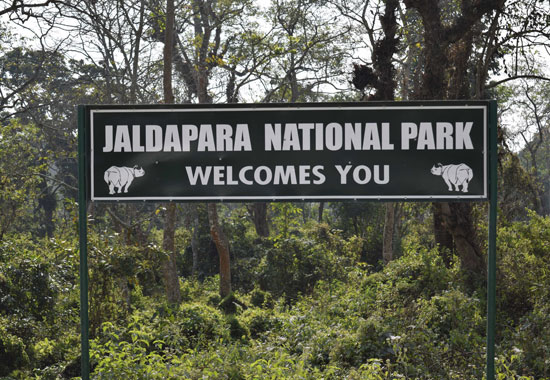
Nearby attractions:The Buxa Tiger Reserve located nearby is an important effort to save the Royal Bengal Tiger. This tiger reserve is also the ideal place to catch a glimpse of nearly 150 species of plants. Jayanti is another destination located at a distance of 75 km from Madarihat, on the banks of Jayanti River. It offers mesmerizing views of sunsets. Nearby Bhutan Ghat, which is a border town of India and Bhutan is located some 85 km from Madarihat. Some other places located nearby include Gorumara National Park and Chilapata Forest, where you can find the remnants of the fort of Nal King.
Best visit time: Jaldapara WLS stays closed during the monsoons (15th June to 15th September) every year.
Jayanti ( Dooars – 30 km. from Alipurduar)
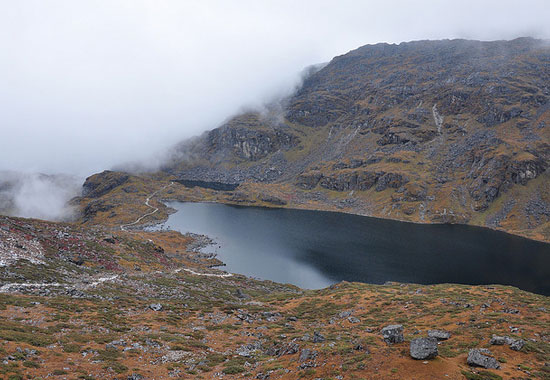
Jayanti is in the Jalpaiguri district of West Bengal in India. This forest village is about 30 Km from Alipurduar.
Located along the Jayanti River, which forms a natural border with the Bhutan hills, this beautiful place offers all the peace and tranquility that is so missing in a busy city life. A tour of Jayanti, away from the humdrum of city life is an ideal leisure holiday destination where time seems to have slowed down its fast pace. Music of the swift flowing Jayanti River, chirping of unknown birds, sweet fragrance of nature and refreshingly cool breeze at Jayanti will make you feel completely rejuvenated. Though the river remains dry for most of the year but its white beds with pebbles all around imparts an unmatched beauty to the place.
Way to Jayanti through the densely forested Buxa Tiger Reserve is a fascinating experience and another huge attraction of Jayanti tour. Meeting a herd of Elephant or Spotted Deer or plenty of Peacocks are most common sights on the way to Jayanti.
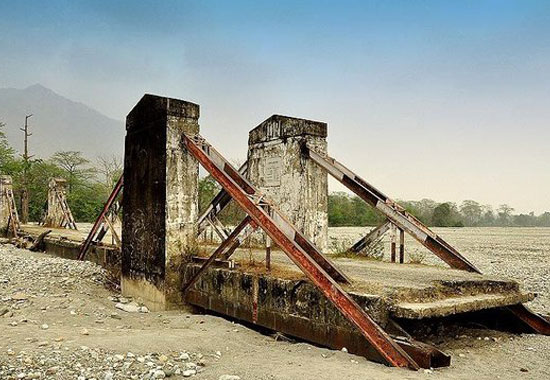
Nearby attractions: Apart from enjoying the beauty of nature and taking a bath in the Jayanti River there are quite a few spots nearby that are worth a visit.
Buxa Fort – This fort atop the Buxa Hill at a height of 2600 feet is of great historical importance. The fort was used as a prison by the British during its rule in India. Many freedom fighters were imprisoned here during the British rule. After independence, it served as a refugee camp for Tibetans and Bangladeshis.
To visit this place of historic importance one has to trek through the dense forested hills. The 5 Km long trek starts from Santhlabari (914 ft) and offers some panoramic and breathtaking views of the surrounding landscape.
Pokhri – This sacred and holy pond on the top of Pokhri hill at a distance of about 4 Km from Jayanti is a must-visit sightseeing destination of Jayanti. To reach Pokhri one has to trek the distance partly through forested hills and partly through previously used roads. The whole trek is quite a joyful experience and provides a scope to come so close to nature. People visiting Jayanti hardly misses a chance to visit the Pokhri pond. The beauty of the surroundings is certainly something which has a refreshing effect.
It is a place of religious worship for the Bhutanese and other local people. The pond is considered as extremely sacred and people even do not touches its water with feet. Large number of big-sized Magur and Turtle fish in the waters of the Pokhri is another attraction of the place.
Best visit time: You can visit Jayanti any time of the year but it is advisable to avoid the rainy season when the region might become quite inaccessible.
Jhandi ( Gorubathan – 87 km. from Siliguri)

Jhandi is a picturesque valley located in the Dooars region of West Bengal around 09 kilometres from Lava on the way to Gorubathan with a panoramic view of the Mahananda River valley and Mt. Kanchenjungha. It is an area of extensive tea plantations and forests.
With it's awesome and evergreen forest cover, and it's profusion of sub-Himalayan flora and fauna Jhandi provides the perfect place to go on long, organized or unorganized hikes through the forests, hills and tea plantations. The Kolakham area just below Lava boasts a lush and widespread cover of pine forests, which are excellent places for trekking. The evergreen forests of Jhandi are home to rare, Himalayan bird species like the Blue Whistling Thrush so bird watching can be in your itinerary.
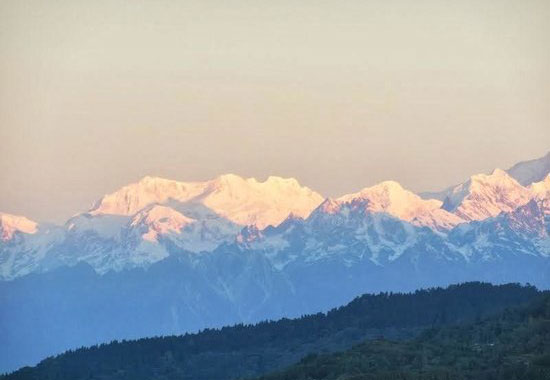
Nearby attractions: As Jhandi is situated near to Gorubathan, guests staying at Jhandi can easily travel to the lush, tropical evergreen forests of the western Dooars region like Gorumara and Chapramari. The Lava Buddhist Monastery just 09 kilometres away is perfect for those tourists who wish to spend a bit of quiet time from all the usual hustle and bustle of the travel, as well as for the spiritual who wish to reflect over things in a calm and peaceful environment. Among the major attractions are a 1000 armed Avalokiteshwara temple within the monastery premises, and various scriptures and figurines of important Buddhist religious figures.
The famous Changey Waterfalls with its peaceful, lush and green surroundings can be the perfect relaxation spot. The sight of the water cascading down into white foam can be an awesome sight to behold. Nearby Fafarkheti in Gorubathan area is a picture-perfect village and an ideal picnic spot with the meandering Chel River and surrounding jungles. You can also visit the ruins of Dalim Fort, located high above Gorubathan for the remains of a Bhutanese fortress, hemmed in on all sides by thick forest cover.
Best visit time: You can visit Jhandi anytime of the year.
Jorepokhri ( Darjeeling – 85 km. from Siliguri)
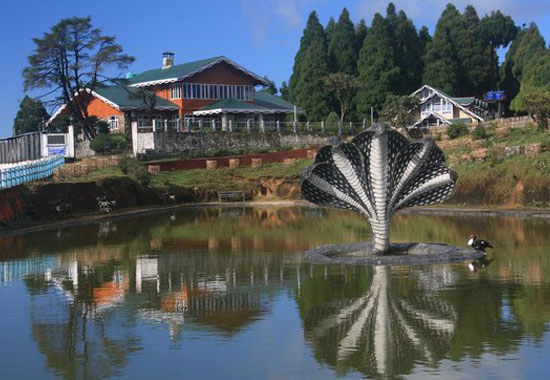
Jorpokhri is a tiny place on a hilltop and located in Darjeeling district. From Darjeeling town, it is about 19kms and can be reached from the road to Mirik. Located at an altitude of 7,400 ft, the main feature of Jorpokhi is its twin lakes after which the place has been named. 'Jor' means two and 'pokhri' stands for a lake or water tank. The boundary of natural lake has been concretized with seating arrangements so that the visitors can enjoy the water area. There is a huge model of a snake and a fountain in the middle of the tank.
You can often see large number of white swans swimming in the waters or strolling around in the nearby area. Jorpokhri, however is not only about the lakes. There is a lovely forest around full of dhupi and pines. Just walk around and feel the lovely Himalayan serenity. Jorpokhri is part of Senchal forest and is a nature reserve.
In the water tanks you might be able to see the rare Himalayan Salamanders that are small lizard like amphibians. Once they were considered totally extinct and wiped off from the face of the earth. They were found to be living here in Jorpokhri in 1964. During the rainy season, you have a better chance of spotting these small creatures.
One of the best offerings of Jorpokhri is its sweeping views of the Himalayan snow peaks and the Darjeeling landscape. On a clear day and from one side of the lake you can get breathtaking views of the majestic Kanchenjunga peaks. On the other side you can see Darjeeling and Kurseong town landscapes. You can spend hours watching the splendors. The best season to get such view is between October to March. From one side of the lake you a paved pathway leads to a stairway and on top there is a lovely shaded viewing area. This is the place to get the best views of the mountains, the beautiful landscaped gardens, the lake and the rows of pine trees.
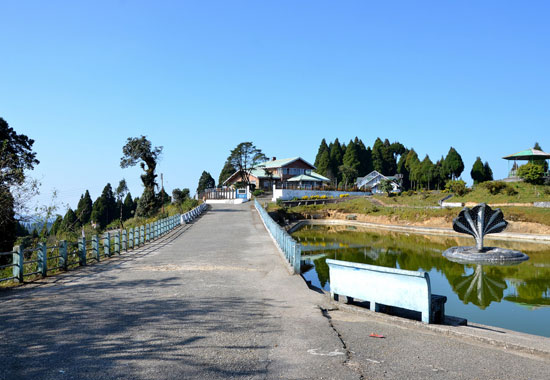
Nearby attractions: The famous Darjeeling, Mirik and Lepchajagat are nearby, easily accessible if you hire a car. Other attractions are Sukhiapokhri (for the Sandakphu Trek), Pashupati Nath Market (Nepal), Kurseong, Simana (India-Nepal border), Senchal Forest Area and the Tea Gardens all along.
Best visit time: October to March if you are seeking beautiful views of Mt. Kanchenjungha June – August (Rainy Season) if you want to share a glimpse of the Himalayan Salamanders.
Kaagey ( Pedong – 75 km. from Siliguri)

Kaagey in West Bengal offers the hilly landscape beauty with the panoramic-view of and the allied peaks of Mt. Kanchenjungha, a winding river down the valley, a jungle in the backyard, and a natural waterfall.
Kaagey makes the little unknown village of charming getaway just 21 kms from Kalimpong. Kaagey is near to popular tourist destinations like Kalimpong, Pedong, Reshi and Sillery but far from the tourist rush.
Kaagey is also known for its impressive bird population and its indigenous people and culture. Like other nearby destinations, enterprising individuals have developed home stays in Kaagey, which are clean, comfortable and very homely.
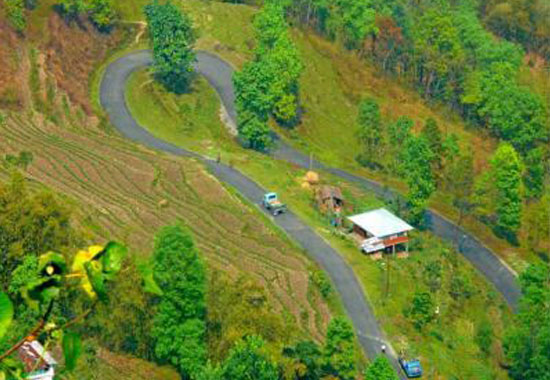
Nearby attractions: There are several places to visit in Kaagey. There is a 15 mins walk from Kaagey would take you to the 50 feet high Jhakri Falls where you can take your shower. There's a small church and a smaller village monastery around 3 kms away. These structures may not be big or historical but they are simple and fit the place where they belong. It's just like your childhood storybook villages, where a small church with a garden, a small school and lots of birds keep chirping all day long. There are a whole lot of opportunities at Kaagey for the nature lovers who like to trek and love bird watching.
The Ramitey Dara viewpoint, which falls on the way to the village school, has one of the longest views of Tista River meandering below in the gorges. The little-known Deorali Dara also offers great views of Eastern Sikkim and the snow capped mountains. You can also visit the nearby Lepcha village of Gerok to understand the traditional lifestyle of the Lepchas.
Best visit time: Winter is the best time for viewing Mt. Kanchenjungha and the other peaks from Kaagey and its adjacent areas. The monsoons fill up the rivers and waterfalls of Kaagey. The summers are cool in Kaagey and the winters are not that biting cold.
Kalimpong ( Darjeeling – 62 km. from Siliguri)
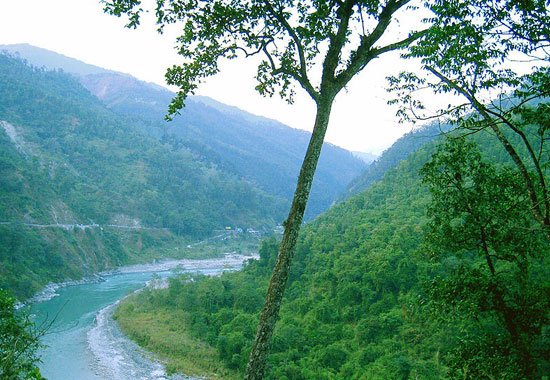
Kalimpong is a hill station in the Indian state of West Bengal. It is located at an average elevation of 1,250 metres (4,101 ft). The town is set to be the headquarters of the announced district of Kalimpong. The Indian Army's 27 Mountain Division is located on the outskirts of the town.
Kalimpong was once under that dynasty of the King of Bhutan. However they had to hand over the administration to the British in 1865. Since then the British flocked to this part of the country in numbers, built great schools with high standard of education (which Kalimpong is still well known for), created lovely housing architectures in traditional British style that will remind you of typical British countryside, built several charity institutions and of course many flowering gardens. While the British have long gone, you will still get an essence of all these in Kalimpong.
But by then Kalimpong had already become a melting pot of diverse cultures and traditions from Lepchas, Nepalese (also known as Gorkhas), British, Indians, Tibetans and even Sikkimese. And you will find all its reflections in the local food & beverages, house architectures, language, and many other cultural dimensions. Today Kalimpong is well known for its stunning mountain views, great hill walks, bird watching, and wonderful scenic drives.
The towering Delo Hills is located in the north of Kalimpong. The reservoir here is the main source of water supply to the town of Kalimpong. On the south is the Durpin dara hills and at the center of the town is the main Kalimpong Market Square (Bazaar).
The Rishi Road from the square goes north having numerous Bhutia & Tibetan shops and many restaurants & eateries on both sides. This is where the main taxi stand of Kalimpong is also located. You will get ample taxis for sightseeing & tours.
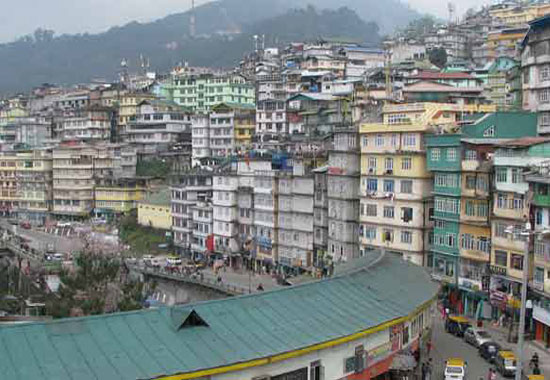
Nearby attractions: Numerous view points to get lovely sight of the Kanchenjunga snow peaks, monasteries, temples, tourist complexes, heritage buildings, parks, flower nurseries, heritage schools, charitable institutes and more.
Best visit time: Kalimpong weather is pleasant & comfortable almost all through the year although you will certainly feel the chill during the winter (December - February). During monsoon the landscape and the forests becomes lush green which is a sight by itself.
Kalipur ( Dooars – 77 km. from Siliguri)
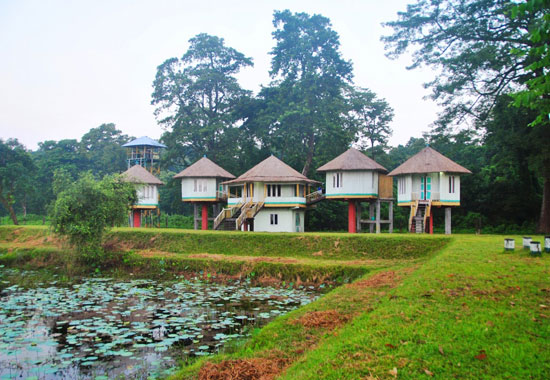
Staying in cottages built on stilts in the heart of a jungle filled with wild elephants, rhinos, leopards, tigers, bears and other wildlife – that's Kalipur. Here, you can enjoy elephant safari in the early mornings and tribal dances in the evenings. If you are an admirer of wildlife thriving amidst lush green forest, then Kalipur is your ideal destination. Kalipur is a part of the Gorumara National Park, nestled in the Indo Bhutan border in the Northern part of West Bengal.
The elephant safari in the Gorumara Forest is a great entertainment for the tourists visiting the destination. You can also enjoy feeding the elephants and the local tribal programs in the evenings.
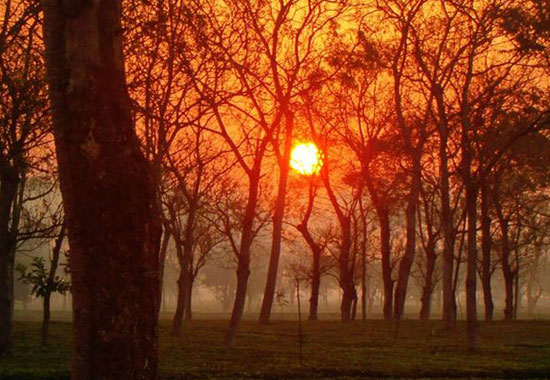
Nearby attractions: You can make tours to Siliguri or Jalpaiguri from the location.
Best visit time: The ideal time of visiting Kalipur starts from the mid of October and extends up to the mid of March.
Kolakham ( Neora Valley – 108 km. from Siliguri)
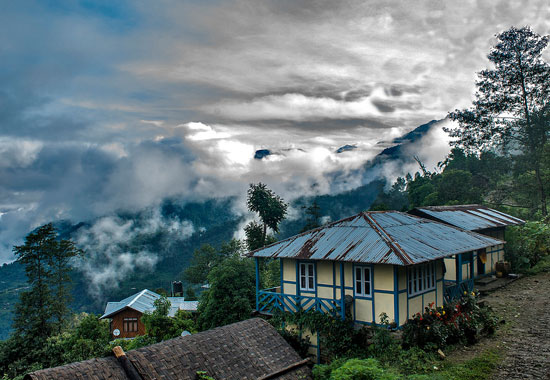
Neora Valley National Park is situated in the Kalimpong subdivision under Darjeeling District, West Bengal, India and was established in 1986. It spreads over an area of 88 km² and is one of the richest biological zones in the entire Northeast. It is the land of the elegant red panda in the pristine undisturbed natural habitat with rugged inaccessible hilly terrain and rich diverse flora and fauna making this park an important wilderness zone.
The park is spread over 159.89 km². The forest in Neora Valley has such luxurious growth that even sunlight finds it difficult to touch the ground. Much of the park is still inaccessible, making it an adventurous place for the nature lovers/trekkers who can take the challenge to explore the still-unknown terrain in the Kalimpong hills. Virgin natural forests, dense bamboo groves, colourful canopy of Rhododendron trees, lush green valley, meandering rivers and streams with snowcapped mountains in the backdrop form a picturesque landscape.
The park reaches up to an elevation of 10600 ft at Rachela Danda the highest point of Neora Valley National Park, which borders Sikkim and Bhutan. The Neora River is the major water source for Kalimpong town.
Kolakham offers an array of activities like rock climbing, trekking and rope traversing to make your stay more interesting. You can also enjoy village walks or nature trails along the picturesque landscape of the region.
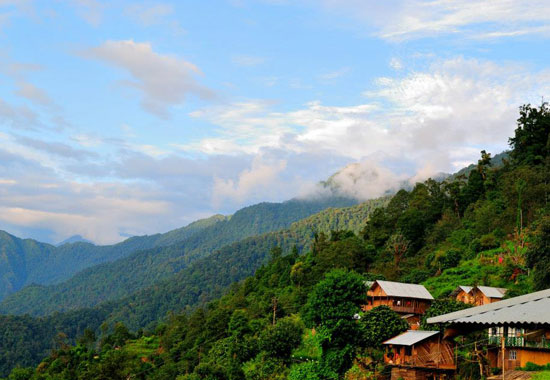
Nearby attractions: You can visit nearby Lava, Lolegaon and Rishop from Kolakham. These hill stations are not very far from Kolakham and boast their exotic natural surrounding, offering spectacular view of the Eastern Himalayan peaks. You can take a day trip to Lava Monastery, Changer Waterfalls, Charkol village, Tea gardens, Choudapheri or the Hanging Bridge at Loleygaon.
Best visit time: You can visit Kolakham any time of the year.
Kulik Bird Sanctuary ( Raiganj – 425 km. from Kolkata)
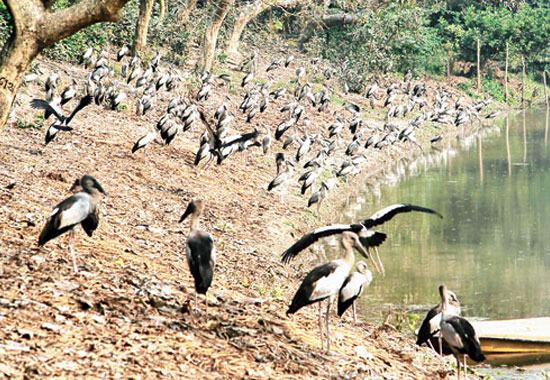
Raiganj Wildlife Sanctuary, popularly known as Kulik Bird sanctuary is no less than heaven to the bird watchers. This haven of a huge variety of birds is located near Raiganj in Uttar Dinajpur district of West Bengal. The sanctuary offers shelter to almost 164 species of birds and every year around 70,000 to 80,000 migratory birds visit the sanctuary. The sanctuary spanning an area of 1.30 sq km is often claimed as the second largest bird sanctuary across Asia.
Spend some leisure time at the bird sanctuary, while exploring the entire region through a well-laid brick pathway. Bird watching is the major activity at Kulik Bird Sanctuary.
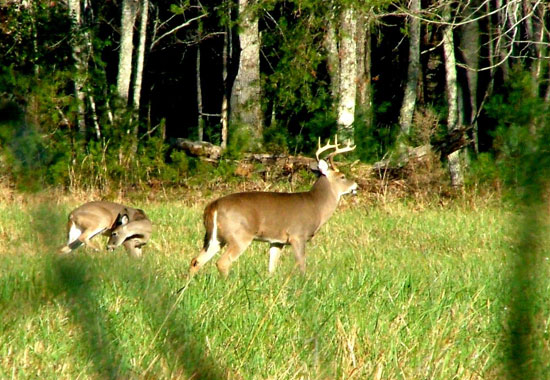
Nearby attractions: One of the major destinations near the Kulik Bird sanctuary is the Sap Nikla forest admired with a beautiful lake. This Mixed Deciduous natural forest offers a true visual treat to the tourists. You can also make a trip to the Temple of Goddess Bhairabi at Bindole, Temple of Goddess Kali of Baira, Mosque of Burhana Fakirs, Museum at Karnajora, Banabithi Resort at Barui, Park at Karnajora and Farm-House at Samaspur. The historical town of Gour famous for its mosques and temples is around 50 kms from Kulik on NH 34. Malda is 65 kms from Kulik. You can take day trips from Kulik to these destinations.
Best visit time: The ideal time to visit the sanctuary is between October and March.
Kurbia ( Kurseong – 38 km. from Siliguri)
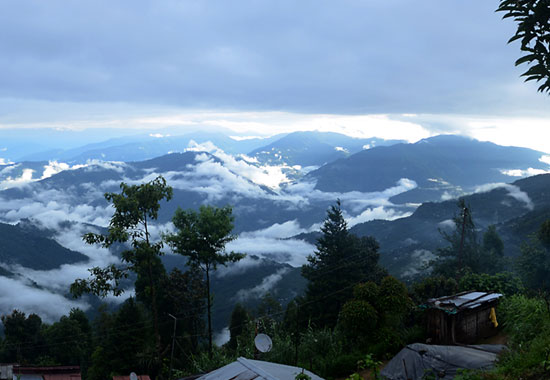
If you have dreamt of a cosy home within the lush tea gardens overlooking the snow capped peaks of Mt. Kanchenjungha – then its time you spend your weekend at Kurbia. Tucked within Darjeeling's legendary tea gardens – Castleton, Monteviot and Springside, Kurbia at an altitude of around 5000 feet is the place where you take long walks along the tea gardens and gaze at Mt. Kanchenjungha while sipping your coveted "first flush." If you are planning for some sightseeing, then Kurseong, Ghoom, Darjeeling and few other untouched nearby destinations can be on your cards. A tea factory tour is also recommended during your stay at Kurbia.
If tea gardens fascinate you, then Kurbia will not disappoint you. Some of the world's best tea gardens are located all around Kurbia. You can take long walks within these tea gardens and watch the local folks plucking tea in their colourful attires. Also, you can simply spend your time in the balcony basking in the morning sun and watching Mt. Kanchenjungha changing colours. A tea factory visit or a family picnic in a tea garden would remind you of Kurbia's colonia past. A short drive from Kurbia would take you to one of the stations of Darjeeling Himalayan Railway from where you can enjoy the heritage toy train ride of Darjeeling.
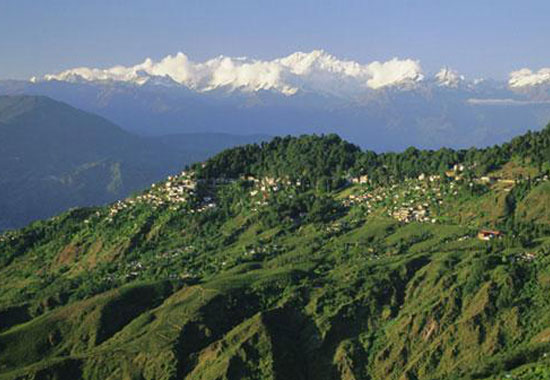
Nearby attractions: You can take a short trip to Darjeeling and spend your time at the famous Mall or tickle your tastebuds at the Keventers and Glenary's. Also, a visit to the Himalayan Mountaineering Institute and the famous Darjeeling Zoo can be made. Some nearby forest villages like Lepchajagat, Bagora and Chimeni can be covered in day trips too. The Ghoom Monastery, Batasia Loop of the Darjeeling Himalayan Railway, Pashupati Market in Nepal, Jorepokhri and the Sumendu Lake in Mirik are few of the sightseeing option to be covered in day trips.
Best visit time: Kurbia can be visited anytime of the year.Kurbia can be visited anytime of the year.
Kurseong ( Darjeeling – 51 km. from Siliguri)
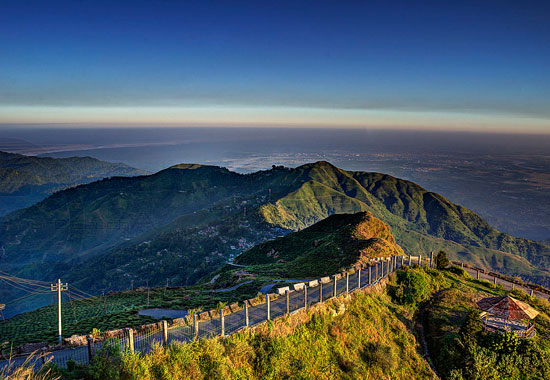
Kurseong is a hill station and sub-divisional town in the Darjeeling district of the Indian state of West Bengal.
Located at an altitude of 1,458 metres (4,783 ft), Kurseong is 32 kilometres (20 mi) from Darjeeling and has a pleasant climate throughout the year.
Kurseong is 47 kilometres (29 mi) from Siliguri and is connected to the city by road and the Darjeeling Himalayan Railway. The nearest airport is at Bagdogra and the nearest major railway station is New Jalpaiguri [NJP], which is about 53 kilometres (33 mi) from the town. The economy is based primarily on education and tourism.
Trekking is a popular activity of the tourists visiting Kurseong. A one day trek is organized by the Tourism department from Kurseong to Mirik via Namsu and Balasun River. You can also enjoy a nature walk along the scenic landscape of Kurseong. You can also take snaps of the surrounding beauty.
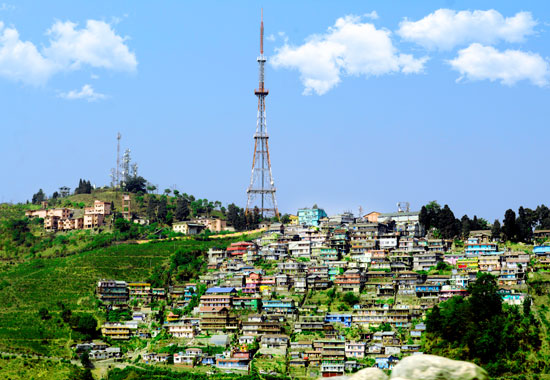
Nearby attractions: Kurseong has several great view points offering spectacular views of the landscapes, tea gardens and the snow peaks. There are some great heritage schools here which the British had established. You can visit some nice museums (including DHR Museum that showcases original railway archives & exhibits), tea estates & factories, temples and even interior villages to know the life and culture of the locals. Most taxi drivers will offer standard half and full day local sightseeing tours.
Best visit time: The very essence of Kurseong is its wonderful weather. So you can visit the place any time of the year. However, it is better to skip the rainy season.
Lamahatta ( North Bengal – 76 km. from Siliguri)
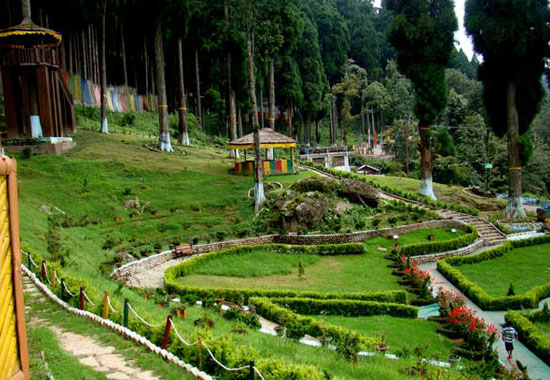
Surrounded by greenery and rivers amidst picturesque terraced farmland, LAMAHATTA is a small mountain village that now boasts of an upcoming eco tourism destination.
Located at an altitude of 1700 meter above sea level and around 23km from Darjeeling, this tourist spot is gaining momentum by leaps and bounds.
It has been developed as a honeymoon destination and is a paradise for honeymooners as it offers solitude, picturesque beauty and a feeling of being amidst nature, a perfect platform to get to know each other.
LAMAHATTA is very well connected to Darjeeling, Kamlimpong state highway. The beauty of the place is further enhanced by a new garden developed recently surrounded by prayer flags and wide variety of flowers and orchids to lure tourists.
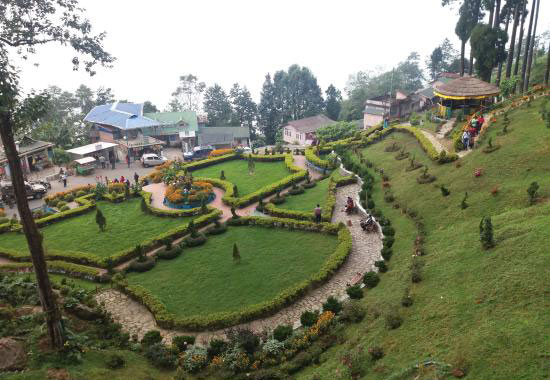
Nearby attractions: Darjeeling, located approximately 6700 feet above sea-level is just 23 kms from Lamahatta. The Darjeeling Himalayan Railway (which is a UNESCO heritage site), the Himalayan Zoo (housing several rare and endangered species of animals such as the Tibetan wolf and the Red Panda) and the Mall are some of the famous attractions of Darjeeling.
Best visit time: You can visit Lamahatta anytime of the year.
Latpanchar ( Darjeeling – 41 km. from Siliguri)
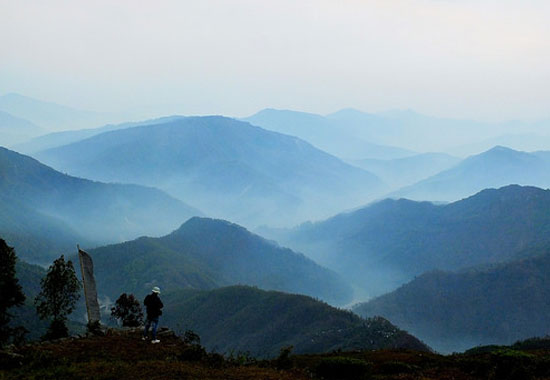
Latpanchar is a mesmerizing mirror of natural beauty covered with forests and Cinconha Plantation. It is the highest point in the Mahananda Wildlife Sanctuary with fabulous views of Teesta River, deep gorges and greenery all around. The place is not plagued by pollution and ravaged by human activities. The dark, deep forest adds to the mystery of the place.
A track through pine forests and Cinchona Plantation leads to a lake, Namthing Pokhri, which is the natural abode of Himalayan Salamanders. Guests can take an early morning car ride to this lake just 3 kms away and visit the view point to catch a mesmerizing sunrise and Mt. Kanchenjungha. Bird watching and jungle trekking is the most favourite activity at Latpanchar and nearby Mana Hills is a favorite haunt with bird lovers. The entire region teems with swallow, swift, thrush, sunbird and babbler. Mahaldiram Tea Estate is a fascination with adventure-loving tourists. As Latpanchar is within the Mahananda WLS, so wildlife is also abundant – squirrels, deer and even elephants can be viewed occasionally around Latpanchar.

Nearby attractions: At Mongpoo, you would find the famous house of Rabindranath Tagore just 35 kms via Sitong and 45 kms via Rambhi. Sitong is another nearby village of Latpanchar, which is famous for its orange orchards and natural extravaganza. You can continue further to Chatakpur near Sonada and further to Kurseong.
Best visit time: The suitable time to visit Latpanchor is between October and April. During this time, Latpanchar remains free from bad weather.
Lava ( Kalimpong – 103 kms from Siliguri)
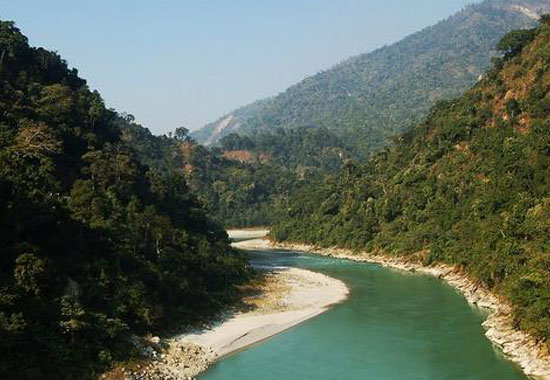
Lava is a small hamlet situated 34 kilometres (21 mi) east of the town of Kalimpong via Algarah in Darjeeling district of the state of West Bengal, India. Lava is situated at an altitude of 7,016 feet (2,138 m). It is one of the few places in West Bengal to receive snow in winter. It is the entry point to the Neora Valley National Park from Kalimpong. The route to Lava is scenic with the change in vegetation from tropical deciduous to the wet alpine trees of fir, pine and birch. The verdant forests are a popular spot for picnicking, trekking and bird-watching. Lava has now become a favorite tourist destination for people living on the coast of West Bengal, and tourism has become the source of living for the inhabitants.
You can enjoy a nature walk around the forest and along the picturesque landscape of Lava. Moreover, Lava is a perfect destination for hiking and trekking. You can trek 12 km. from Lava to Jelepla and Rachela Pass, located at the junction of Sikkim, Bhutan and Bengal. The location also offers a visual treat to the avid bird watchers.
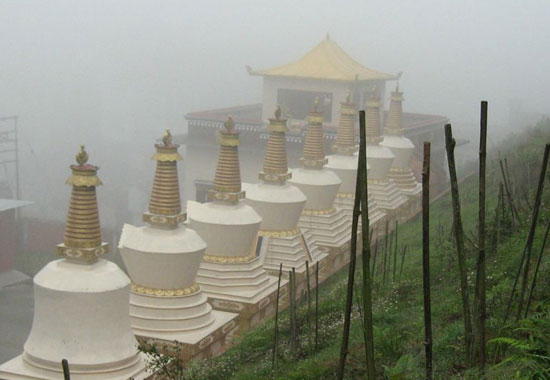
Nearby attractions: You can make your tour experience of Lava more enduring by making some exciting trips to nearby tourist spots. Rishap, located at a distance of 8 km. from Lava, is emerging as a popular tourist destination, attracting travelers to savor its scenic natural landscape. You can also make a trip to Chhangey Falls, situated 12 km. from Lava. Lolegaon is another major location of tourist interest, located 25 km. from Lava. You can also visit Kalimpong, which is 32 km. from Lava. The famous hill station of Darjeeling is also located at a close distance from Lava.
Best visit time: You can visit Lava any time of the year but it is better to avoid during the monsoon.
Lepchajagat ( Darjeeling – 68 km. from Siliguri)
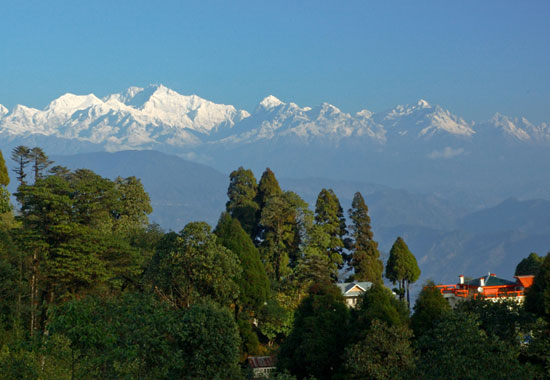
Lepchajagat, situated at an altitude of 6956 feet, is a small village 19 kilometres from Darjeeling, in North Bengal. It takes its name from "Lepcha" meaning the indigenous inhabitants of the region, and "Jagat" symbolizing "world" or "domain". As the name suggests, the village is a Lepcha stronghold, which has since been transformed into a forest reserve. Lepchajagat is ideal for those tourists visiting Darjeeling but planning to take a diversion from the hustle and bustle of the Darjeeling main town. Not only does it offer stunning greenery and mountain views, but birdwatchers will be thrilled with the amazing variety of birds that inhabit Lepchajagat. Visitors to Darjeeling also have the option of combining their tour of Darjeeling with Lepchajagat.
Lepcha jagat offers ample opportunities for those interested in bird watching, trekking or just plain walking. The fascinating birdlife is a star attraction of Lepchajagat, with several rare species including the Fire-Tailed Sunbird and the Rufous Sibia found here. Trekking to Himal Falls or Hawa Ghar is an exciting option to guests.

Nearby attractions: There are many places of interest around Lepchajagat for the interested visitors. These include Darjeeling, Mirik, Kurseong, Batasia, Jorepokhri and Ghoom. Among these, the most well-known is Darjeeling.
Best visit time: There is no fixed time at which to visit Lepchajagat, as it's beauty and tranquility can be enjoyed at any time of the year.
Loleygaon ( Darjeeling – 123 km. from Siliguri)
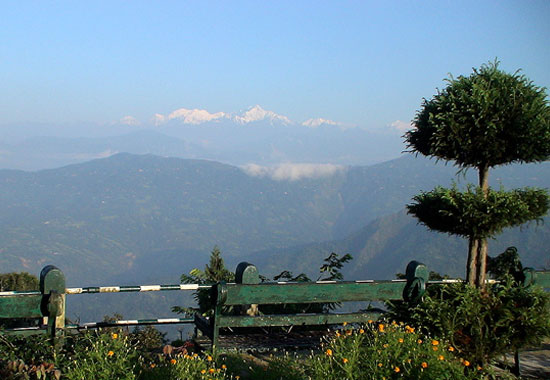
Loleygaon (also spelt Lolaegaon or Lolegaon) is a small Lepcha village with a population of about 5000. It is situated in an extreme end of a Himalayan Ridge & located at a distance of 24 km from Lava lying at an altitude of 1,675 meters. It comes under the Kalimpong I block in the Darjeeling District of West Bengal.
Kafer, about 1 kilometers from Loleygaon, offers a panoramic view of the Kanchenjunga. A spectacular sunrise can be viewed from Jhandi Dara.
Loleygaon can be reached from Siliguri with a 4-hour drive covering 124 km via Kalimpong and Lava. Kalimpong, the nearest town, is 55 km from Loleygaon. Notable sites include Canopy Walk, Jhandi Dhara Sunrise Point, and Lolegaon View Point.
Nature walking, enjoying the sunrise over Mt. Kanchenjunjha and visiting the nearby villages, forests, plantations and Buddhist monasteries. The Canopy Walk over the wooden hanging foot bridge is a special attraction.
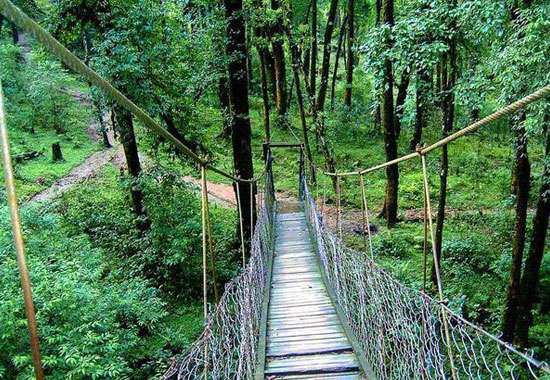
Nearby attractions: Lava, Kafer- the Lepcha village, Kalimpong, Samthahar and Jhandidara Sunrise Point are the places of interests around Loleygaon.
Best visit time: The best time to visit Lolegaon lasts throughout the year save the monsoon season from July to August.
Makaibari ( Kurseong – 54 km. from Siliguri)
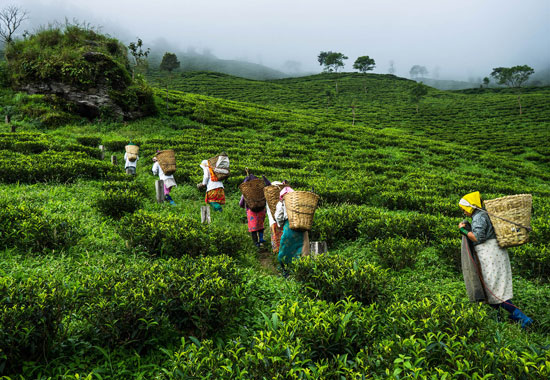
Founded in 1859, Makaibari tea estate is one of the oldest and most prestigious tea estates on India. Spreading over 1575 acres of the Himalayan slopes at an altitude of 4600 feet, the garden overlooks River Balasun, a dense forest cover and the picturesque town of Kurseong. Makaibari is still farmed by the original founding family (presently, the 4th generation) in one of the most eco-friendly methods producing organic tea of the highest quality. At Makaibari, you can stay in one of the 16 homestays managed by the villagers and plantation workers and discover the charm of living in a tea estate. You would enjoy traditional hospitality in these Makaibari homestays and savour some of the best home-cooked food. You can enjoy endless cups of Makaibari Tea, participate in tea tasting sessions, try your hands in tea plucking and visit the famous Makaibari tea factory to see the various stages of tea processing from here.
You can take nature walks along the tea gardens and take to the winding paths up and down the slopes skirting the tea bushes. You can try your hands in tea plucking with the some expert plucker or visit the tea factory to see tea processing. You can also take part in tea tasting sessions with tea tasters and start understanding why Darjeeling Tea is considered the world's best tea. You are sure to return as a "tea pundit" from Makaibari. However, when you are not drinking, plucking or tasting tea at Makaibari, you can enjoy birdwatching, village walks, jungle treks and picnicking beside a meandering stream flowing through the jungle crisscrossed by bamboo bridges.
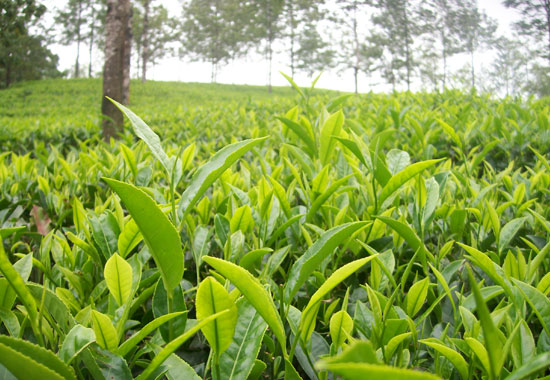
Nearby attractions: Makaibari is just 3 kms from Kurseong town and 33 kms from Darjeeling. All sightseeing destinations of these two towns can be covered from Makaibari in day trips. You can board the famous toytrain of Darjeeling Himalayan Railway from Kurseong, visit local villages perched on scenic destinations like Dilaram, Chimeni and Bagora and trek in the forests around Chatakpur, staying at Makaibari.
Best visit time: You can visit Makaibari any time of the year.
Malbazar ( Dooars – 65 km. from Siliguri)
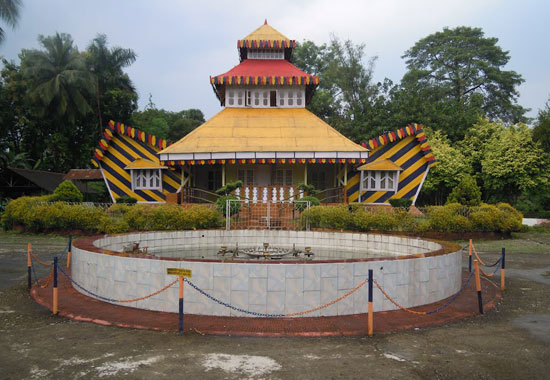
Malbazar is a sub-divisional town in Jalpaiguri district of West Bengal, India. It is also known as Mal. It is located in the Dooars area, just 55-kilometer distance from Siliguri and 65 kilometer distance from Jalpaiguri city. Mal or Malbazar itself neither an effective tourist spots nor have any historical background except a beautiful modern Park, known as Mal Park, but it has a significance role in the Dooars tourism due to its strategic location on the national highway and near by many famous tourist spots.
You actually have a lot to do in the Dooars. You can take a long walk along the river banks, take a dip or enjoy some fishing in the knee deep Murti River. You can also try your hands in tea plucking, enjoy a safari in the nearby forest or enjoy wildlife viewing from the forest watch towers like Chandrachur Tower, Jatraprasad, Chapramari Tower, Rhino Point and Chuk Chuki. You can visit the nearby villages and meet the local tribes like the Toto, the Bodo of Assam, Bhutanese, the Koch, Mundas, Limbus, the Rajbongshis in Bengal, Lepcha, Rabha and Oraons and know more about them.
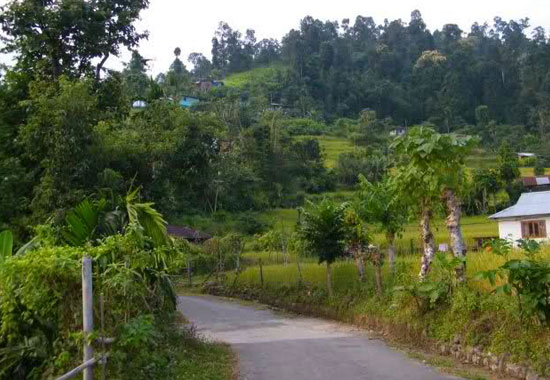
Nearby attractions: Malbazar itself is not a tourist destination, but there is a beautiful modern park, name Mal Park. And you can stay at Mal and enjoy all near by tourist spots beauty. There are many tea garden around Malbazar town. You may plan to visit there.
Gorumara National Park is famous to visitors for its natural population of one-horned Rhinoceros, situated on the bank of rivers Murti and Raidak. It is just 18 kilometers away from Malbazar.
Chapramari Wildlife Sanctuary is one of the oldest Sanctuary in India. Murti River flows by the western boundary of it and the Sanctuary is totally located on the plain land of the Doors. It is famous for Indian elephants and gour (Indian bison). Chalsa is a entry point to the sanctuary.
Bindu Dam built on the Jaldhaka River to operate water supply of Jaldhaka Hydel Project. However, one can cross the dam only by foot. From there you can take a rare view of the snow Peak Mountains in winters. Bindu also famous for various hill birds as well as some migratory waterfowl. It is situated just 55 kilometer from Malbazar.
Murti is situated on the bank of the River Murti besides the Chapramari Wildlife Sanctuary and Gorumara National Park. Murti itself is a very nice tourist spot. In the river Murti, you can find out Gharials. A total road distance between Malbazar and Murti about 18 kilometers.
Best visit time: The best time to visit Mallbazar is during the months of September to March, when the monsoon gets over.
Mangerjang ( Rangpo – 89 km. from Siliguri)
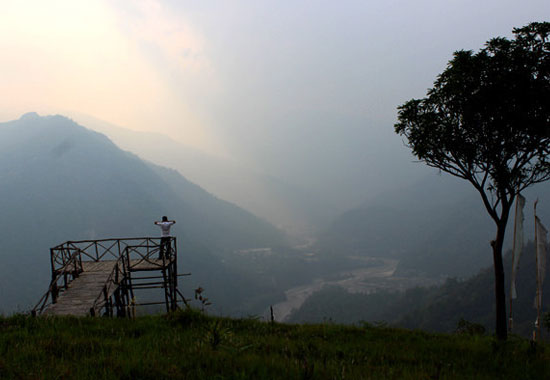
Mangerjang is a small village, surrounded by forests overlooking Mt. Kanchenjungha and River Teesta. Far from the tourist rush – it's a refuge for the soul searchers. Here, you wake up to bird calls and fall asleep to starry nights. You can take jungle walks and stay in a village still not marked on the tourist map. Located at an altitude of 3500 feet on a cliff, Mangerjang is very near to Munsong and just 11 kms from Rangpo.
You can either idle away your whole stay or enjoy some activities. You can trek through the forests or hire a car to go around the places. The place is also great for bird watching. However, the best thing to do is to climb up the Machan and gaze towards the mountains, rivers and forests. In the evenings you can arrange a small campfire.
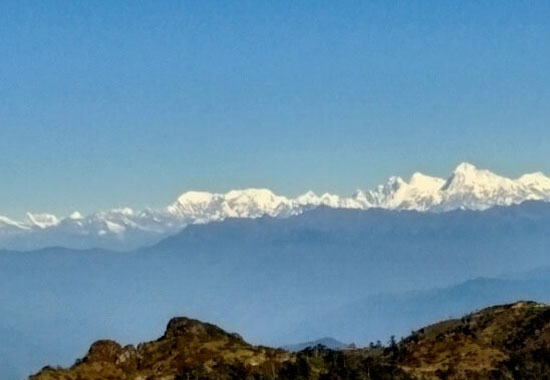
Nearby attractions: There is a small monastery in Mangerjang and the village is surrounded by forests. You can take a forest walk with your hosts or spend all the time at The Maachan hanging over the cliff and witnessing the changing colours of Mt. Kanchenjungha and River Teesta. From the Maachan, you can enjoy views of Sikkim on the distance and the winding highways along the river. This little village of Mangerjang is near to Pedong, Munsong and Rangpo.
Best visit time: Mangerjang welcomes tourist round the year. Winter is the best time for viewing Mt. Kanchenjungha.
Mekhliganj Tea Resort ( 86 km. from Siliguri)
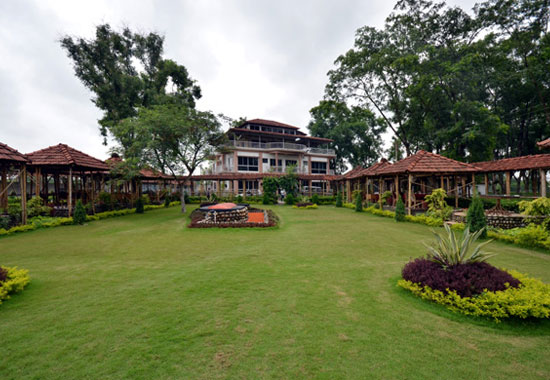
Mekhliganj is a luxury resort tucked within a lush tea estate beside a meandering river – that's Mekhliganj. You can enjoy a magnificient view of endless greenery of tea garden and farmland from this tea resort. On one side of Mekhliganj teasort lies the snaking Saniajaan River and on the other is the tea estate. The Tin Bigha Border Crossing is just a walk away from Mekhliganj Tea Resort where you can witness the ceremonial Border closing of India and Bangladesh every evening. You can also enjoy long walks along the tea estate, visit the lonely banks of River Saniajaan, visit a nearby tea-factory or just take a dip in the resort's swimming pool.
If you are planning to spend few days doing nothing, then Mekhliganj can be your ideal choice. You can take a nature walk along the bank of Saniajaan River or within the tea estate. You can see tea plucking and even try yourself to pluck a few leaves in the tea garden. A visit to some local villages or the mighty River Teesta can also be in your cards. Another major attraction is the Tin Bigha International Border Checkpost just a kilometer from the resort. You can witness the ceremonial Border closing at Tin Bigha Corridor between India and Bangladesh every evening.

Nearby attractions: Mekhliganj is quite far from any popular touristic destination. This makes Mekhliganj an ideal place to spend a few days in bliss within a tea estate far from the madding crowd. Moreover, Mekhliganj is becoming popular as a destination where tourists can wind up their hectic Dooars Itinerary and spend the last couple of days of their Dooars trip in nature's cradle enjoying all earthly comforts. Mekhliganj is around 55 kms from Gorumara National Forest, around 105 kms from Jaldapara National Forest, 90 kms from Gorubathan and 82 kms from Cooch Behar. If you are planning a trip to Dooars this year, then try to keep Mekhliganj Tea Resort in the last leg of your itinerary.
Best visit time: You can visit Mekhliganj anytime of the year.
Mirik ( Darjeeling – 55 km. from Siliguri)
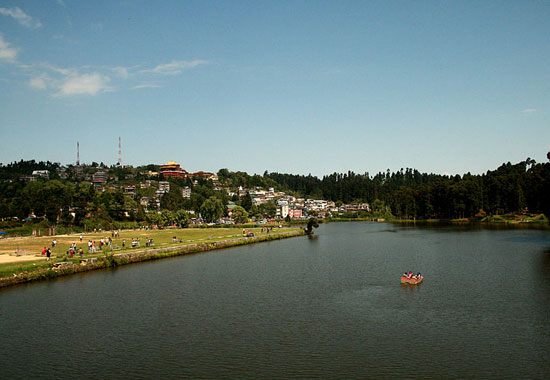
Mirik is a picturesque tourist spot nestled in the serene hills of Darjeeling district in West Bengal, India. The name Mirik comes from the Lepcha words Mir-Yok meaning "place burnt by fire".
Mirik has become a popular tourist destination for its climate, natural beauty and easy accessibility. The centre of all attraction is the Sumendu lake, surrounded by a garden on one side and pine trees on the other and linked together by an arching footbridge called Indreni Pull (Rainbow Bridge). A 3.5-km-long road encircles the lake and is used for walks with the view of Kangchenjunga on the far horizon. Boating on the quaint shikaras and pony riding are available.
Mirik is famous for all kinds of activities like boating, horse riding and nature trailing along the lakeside. You can also visit coffee and tea gardens, orange orchards and cardamom plantation. For trekking, you can definitely visit Phalut, which makes a favorable surrounding for trekkers.
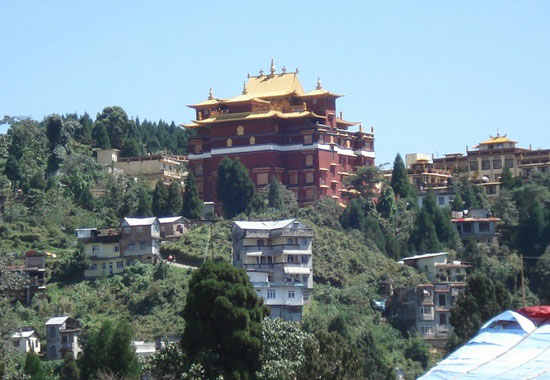
Nearby attractions: There are many sightseeing opportunities around Mirik. The Ramitay Dara is one such destination located few kilometers from the town. It is a viewpoint offering views of the mountains and the plain below. You can also visit the Sunrise Point that offer breathtaking sights of the sun rising in the east, miles of tea gardens, orange orchards, the Bokar Monastery located on the way to Rameetay Dara, Jayanti Nagar, Pashupati Nagar, the Mirik Church and the Swiss Cottage are some of the places of attractions located very close to the town. Nearby tourist towns like Kurseong and Darjeeling attracts tourists from all over the world.
Best visit time: Summer is the ideal time to visit hill stations.
Mongpong ( Darjeeling – 29 km. from Siliguri)
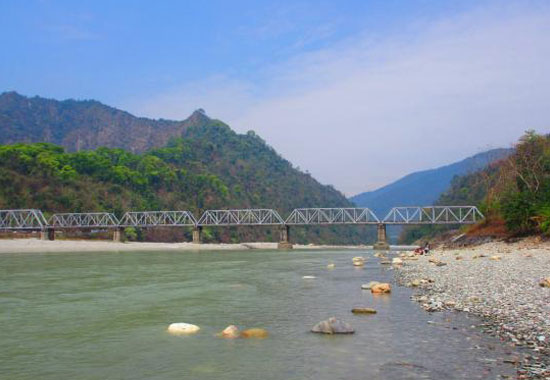
Mongpong is a small hill village located in the Darjeeling district of West Bengal, India. This village is located on the bank of Teesta river. The Teesta river breaks into several streams here. Mongpong is located on the fringe of Mahananda Wildlife Sanctuary and is home to several birds like brahminy duck, pintail duck, poachard, mallard and bar-headed goose that come here from Central Asia and Ladakh during winter. It is known for its beautiful landscape of the Teesta river, mountains and forests, which attract a lot of tourists. Accommodation is available at the Mongpong Forest Rest House managed by the West Bengal Forest Development Corporation (WBFDC).
The Mahananda Wild Life Sanctuary is a must see when you are in Mongpong. The sanctuary houses wide variety of bird life like the Pintail duck, Bar-headed goose, Poachard, Brahminy duck, Mallard and others. Plus, the Teesta valley offers some breathtaking views of nature that you had somehow missed in the chaos and confusion of the city. The historical Coronation Bridge at Sevoke is also a great piece of attraction.

Nearby attractions: The city of Siliguri is just 29 kilometers from Mongpong and the forests of Dooars are also nearby. So, you can definitely make a trip to these two places.
Best visit time: You can visit Monpong during anytime of the year.
Murti ( Dooars – 84 km. from Siliguri)
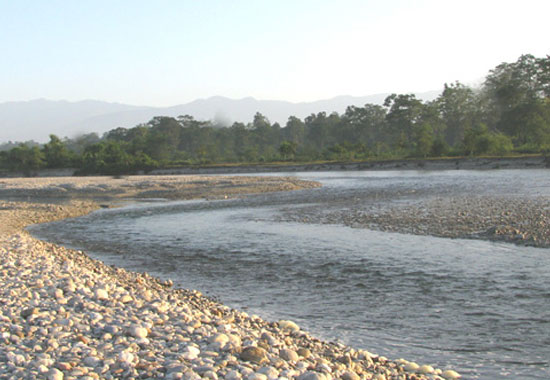
Murti is a picturesque tourist spot located on the banks of the Murti River in the Dooars region of Northern Bengal.
Murti village is located by the banks of Murti River and it is very close to Chapramari forest and Gorumara National Park. In fact, Murti River is one of the main rivers skirting right through the middle of Gorumara National Park.
Camping, angling and hiking are the two most popular activities in Murti. Plus, bird watchers will have a great time too. You can also enjoy jungle safari in Gorumara N.P and other nearby forests from Murti.

Nearby attractions: The entire Dooars range of forests can be reached from Murti. Forests like Gorumara, Chapramari, Chukchukia, Khunia and Chalsa are all nearby. You can also visit nearby hill destinations like Jhalong, Bindu and Paren. Samsing, Suntaleykhola
Best visit time: Murti can be visited any time of the year.
Mulkarkha Lake Trek ( North Bengal )
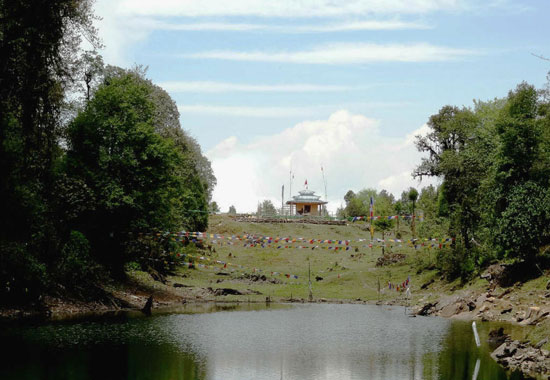
Mulkarkha Lake is a natural lake tucked in a remote corner of the forests of the Himalayan foothills of Northern Bengal. The most fascinating feature of this lake is the reflection of Mt. Kanchenjungha on its tranquil waters. The trek route to Mulkarkha Lake is one of the most exciting and untouched trails of the Himalayan foothills. You would come across 200 feet waterfalls, dense forests, enchanting views of Mt. Kanchenjungha, ageless Buddhist monasteries, remote villages, hundreds of species of birds, butterflies and flowers. The Mulkarkha Lake is considered sacred by the locals as Manokamana (Wishing) Lake.
The overall difficulty level of this trek is considered "Easy" and there are numerous options for completing this trek. Our Starting Point for the Mulkarkha Lake Trek is the small village of Lingzey in West Bengal. This little Himalayan village has the second largest temple in Darjeeling district. Throughout the year several Hindu festivals are held in the temple complex. The most important among them are the Sawan Bole Bhum, Shivaratri, Durga Puja, and Bala Chaturdasi. There is also a Sanskrit Vidyalaya in Lingzey which stocks rare and valuable books of Hinduism. Other than that, Lingzey also has a Hot Suphur Spring, few traditional Lepcha Houses and the Rang Bang River.
Munsong ( Darjeeling – 127 km. from Siliguri )
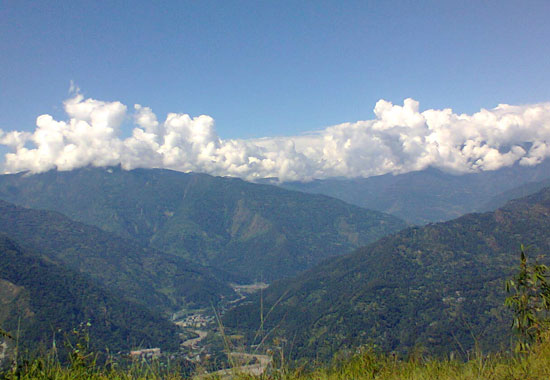
Munsong or Mungsong has the longest view of River Teesta and one of the majestic views of the entire Mt. Kanchenjungha range. It has also been a popular location for films like "Chalo -Let's Go" but has been left out from the tourist map. Located at an elevation of 5000 ft. near the Kalimpong – Sikkim border on top of a hill, Munsong is a peaceful village with limited staying options but some of the best views of the Eastern Himalayas.
While in Munsong, which is developing as a tourist location near a Cinconha Plantation, you can go to Burmaik Mahadev Dham just 3 km away. You can also go trekking in the Sillery goan, which is at a distance of 5 km. Deolo View point and Pedong are two other spots that you can visit from Mungsong. Mungsong has one of the widest views of Mt. Kanchenjungha and excellent views of the winding Teesta River. Sunrise from Munsong over crimson mountains look extraordinary.
The major thing you can do in Mungsong, is relax and take in the pleasures of nature with an excellent view of the entire Mt. Kanchenjungha range. You can go trekking at some points, or take a stroll around the Teesta River. You can also visit the cinchona plantation for which Munson is renowned. There is abundant flora and fauna in this place that you can go for watching.
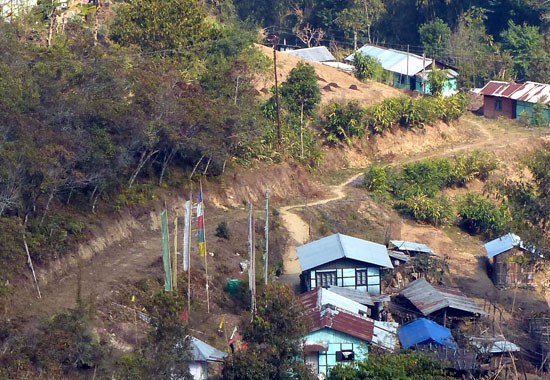
Nearby attractions: You can go to the town of Kalimpong that is some 22 km away. Making a day trip to the town of Siliguri, which is 85 km from Munsong is also a good way to spend a day. Sightseeing destinations include Lava, Loleygaon, Kolakham, Rishyap and other nearby destinations.
Best visit time: Summer is the ideal time to visit Munsong.
Paren ( Jaldhaka – 112 kms from Siliguri )
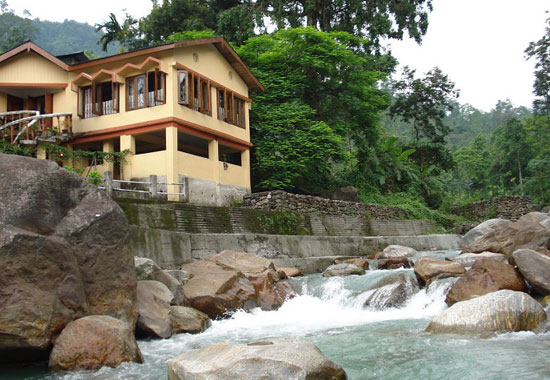
Paren in Dooars, admired with lush green forest areas, hilly terrain, meandering rivers and agricultural fields and clusters of picturesque village is an ideal destination for a weekend tour. You can spot the location on your way to Bindu, at the verge of the Indian border with Bhutan and is 10 km drive from Jaldhaka. The road leading to Bindu offers a visual splendor with its exotic natural surrounding.
While staying at Paren, you can take a nature walk to Garibos, Dalgaon and Rango, known for medicinal plants. Those who want to explore further afield, can enjoy trekking to Rechella Pass, to view the convergence of the Bengal, Sikkim and Bhutan borders.
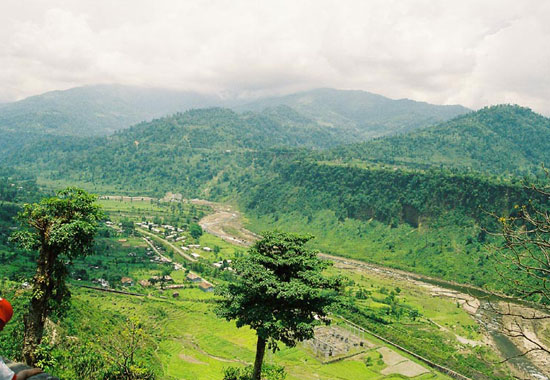
Nearby attractions: Trips can be made to a number of destinations from here. Jaldhaka, which is located at a 10 kms. driving distance from Paren, is famous for the Jaldhaka Hydel Power Station. Another popular destination is Todey, which is also a 10 km. drive from here. Tangta, 35 kms, is an uphill station, offering spectacular views of the surrounding hills and jungle. You can also visit Cardamom Curing Centre, located 14 km. away from Bindu and also the Gairibas Diascorrea Plantation, famous for nurturing the medicinal plants, especially Diascorrea.
Best visit time: Paren attracts tourists round the year.
Pedong ( Darjeeling – 85 kms from Siliguri )

Pedong 20 kms from Kalimpong, just off the road going to Lava is the small village of Pedong. From Algarah take a left turn and you will soon reach Pedong. The small picturesque hamlet situated on a ridge and surrounded by pine forests, it commands some magnificent views of the surrounding hills. The village used to be a major transit hub on the ancient silk route that connected Tibet with India through the Jelep La Pass. The village is spread North to South on a ridge and is the starting point of some interesting small hikes.
One such hike will take you to Damsangudi fort- a historically important site that witnessed a long ethnic war between Lepchas and Bhutias. There used to be a fort of the Lepchas at this spot which has now been destroyed.
Another short trek from Pedong will take you to Tinchuley (not to be confused with the other Tinchuley near Peshok road). The area is ideal for adventure tourism activities such as Para Gliding and Hang Gliding. Local enterprising people have set up mountain biking, rock climbing and archery infrastructure here for the lovers of soft adventure.
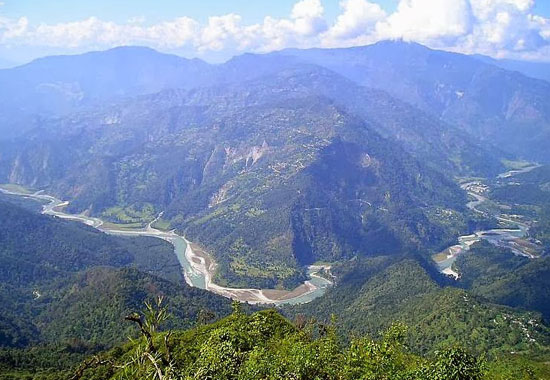
Nearby attractions: Rikisum or Reesoom is another scenic spot nearby. Situated on top of a dense forested hill close to Algarah, Rickisum provides a bird eye view of the surrounding mountains including mount Kanchenjunga. There used to be an old British Bungalow built in 1902. However the bungalow has been destroyed now. From here one can get panoramic view of entire Kanchenjunga range as well as view of the towns of Kalimpong, Darjeeling, Gangtok, Pedong and others.
Sillery Gaon: From Damsamguri, a 500 meters walk will take you to Sillery Gaon. The village has developed tourism infrastructure in the recent years and has been growing in popularity for its great views of the Kanchenjunga massif. Located amongst pine forests the village offers serene environment to the tourists. Wake up to the sounds of birds chirping and a Glorious Golden Sunrise. The view of the Mt. Kanchenjunga is simply breathtaking from here.
Rishi - 15 kms from Pedong through winding downhill road you will reach the Bengal Sikkim boarder of Rishi. Cross river Rishikhola and enter Sikkim through the checkpost here. The area has become popular with the effort of a local person Sebastian Pradhan. His contribution towards developing tourism in the area is legendary. You may stay at Rishi as well where a number of basic accommodation is available.
Damsang Fort: Damsung fort is located within a short walk from Pedong. During late 17th century, there were several wars being fought in the area between the Bhutanese and Lepcha people. The fort was built by the Lepcha to defend their territory. The fort was destroyed during British invasion of 1864. Even those who do not find much interest in history, a visit to the location would not be wasted as the views from the spot will mesmerize any tourist.
TinChuley View Point: A short 900m walk will take one to the Tin Chuley Hill. Any hill top where three ridges meet, tend to be referred to as Tinchuley by the locals. There is another more famous Tinchuley village near Peshok road closer to Darjeeling hills. The viewpoint offers lovely views of Kashyone village, thick wooded forests, and terraced fields brimming with green paddy. The Jelepla pass and Nathula pass can be viewed at a very close range, as well as the entire Mt. Kanchenjunga range, Sikkim and also a far as Gangtok town.
Sangchhen Gumpa: This is a Bhutanese monastery built in the year 1706. all the antique belonging to the Damsang Fort are kept in this monastery after the fort was destroyed. The Chaam dance is performed during the Raninavmi festival. People from Bhutan regularly visit the Gumpa even today.
Tourists visiting Pedong can also go to Lava or Rishyop which are withing 30 to 45 minutes drive away from here.
Best visit time: The best season to make a trip to Pedong is from October to March. This time the weather is pleasant.
Rajabhatkhawa ( Terai – 15 km. from Alipurduar )

Located just 15 kms from Alipurduar, Rajabhatkhawa is the gateway to the famous Buxa Tiger Reserve. Surrounded by emerald green forest and hills this scenic hamlet is an idyllic spot for experiencing green darkness. Serving as an entry point to nearby forests, this little town is bounded by rivers like Raidak and Jayanti. Numerous nature trails originate from Rajabhatkhawa and pass through dense forested areas in and around Buxa Tiger reserve. Bird watching, jungle safari, trekking and wildlife watching are the main activities here. Rajabhatkhawa and its surrounding areas are also home to various migratory birds.
Rajabhatkhawa is a great place for enjoying a relaxed vacation. The nearest sightseeing destination is the famous Buxa Tiger Reserve, which is famous for its ruined Fort, wild elephants, leopards, tigers, bisons and a host of wild animals. All required entry permits to this Buxa Tiger Reserve are issued from Rajabhatkhawa Nature Interpretation Centre. There are a number of trekking trails through the Buxa forest, which offer hikers the chance to savor a glimpse of animals in their natural habitat. Spanning an area of 759 sq km, the Buxa Tiger Reserve is admired with hilly landscape crisscrossed by several rivers and their tributaries. The Buxa Fort is located at an altitude of 867 meters on the Sinchula Range in the middle of the reserve forest.
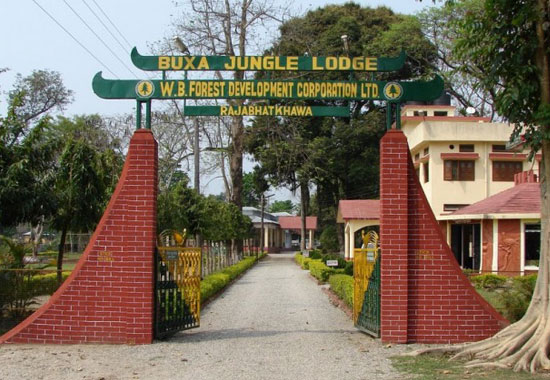
Nearby attractions: In order to reach Buxa Fort, you have to trek around 5 kms from Santrabari. The Buxa Fort located at an altitude of 2600 ft has a huge historical importance because it as used by the British to confine freedom fighters – even Netaji Subhas Chandra Bose is said to have spent some days here. The sacred temple of Mahakal is also located nearby. The riverbed of Jayanti and the dense forests of Chilapata is also located nearby. The beautiful forested area of Jayanti with the meandering Jayanti River and its endless white pebble laden banks is a grand site.
Best visit time: Winter is the most important time to travel to Rajabhatkhawa.
Ramdhura ( Algarah – 80 km. from Siliguri )
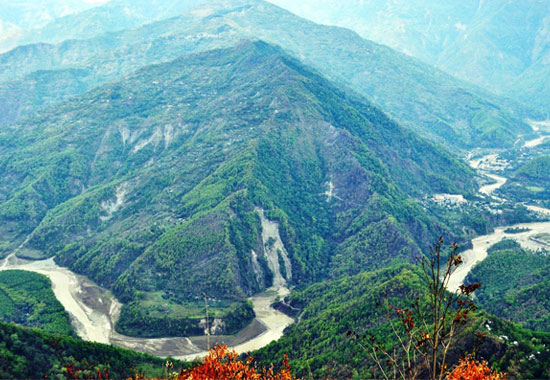
Located just seven kilometers from Delo, with great views of Mt. Kanchenjungha and the meandering River Teesta, Ramdhura is the new found gem of North Bengal. Surrounded by pine forests kissed by clouds and the view of flickering lights of Kalimpong in the night, make Ramdhura a great destination to spend a quiet weekend in the Himalayas. Delo is nearby and so are Pedong, Algarah, Icchey Gaon, Sillery Gaon, Kalimpong, Rellikhola, Lava and Loleygaon.
The rooms of the homestay offer spectacular views of Mt. Kanchenjungha and Kalimpong hills as well as a bird's eye view of the meandering Teesta River valley below. A pine forest surrounds Ramdhura, where you can take local short treks. You can also visit the beautiful British-built Jalsa Bungalow of 1930. A trek along the Cinchona plantation and a visit to the Cinchona Godown can be on your cards too. There is a beautifully located Mahadev Dham temple and Hanuman Tok (viewpoint) nearby from where you can catch panoramic views of the mountains and valleys.
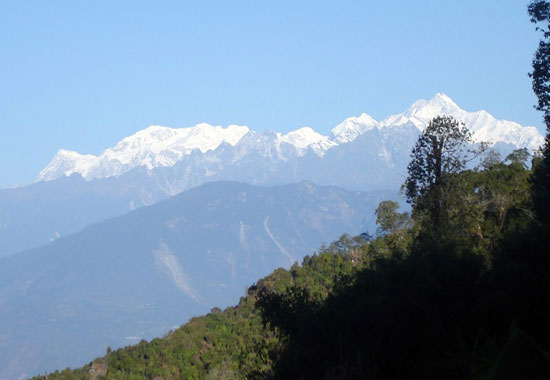
Nearby attractions: While staying at Ramdhura, you can make day trips to the Delo Nature Park, Algarah Bazar, Rikissum, Icchey Gaon, Sillery Gaon, Pedong, Lava, Loleygaon, Rishyap and Kalimpong. A sightseeing trip to Sillery and Icchey Gaon and its surroundings like Ramitey Dara (which has the longest view of River Teesta), Damsang Fort, Valley of Silence, Tinchuley view point would be very rewarding to the guests.
Best visit time: You can visit Ramdhura anytime of the year.
Rangaroon ( Darjeeling – 68 km. from Siliguri )

Rangaroon, Darjeeling, West BengalRangaroon is a beautiful serene tourist destination in Darjeeling in the Indian state of West Bengal. It is basically a small scenic tea garden nestled 6000 feet above sea level. The garden produces some of the world's best quality tea and is notable for its famous "Rangaroon" tea. Home to some of the rare birds and animal species, it is especially popular amongst the adventure seekers and nature admirers.
The name Rangaroon originated from Lepcha language. The literal meaning of this name is "The turning of the great river".
The origin of this tea estate goes back to Lord Adain Ashley, the Governor of Bengal, in 1776. During that time, Rangaroon gained prominence for its high quality tea. The tea was especially popular amongst the British colonists. Impressed by the quality of tea, they began to brew and produce newer and more improved varieties of it.
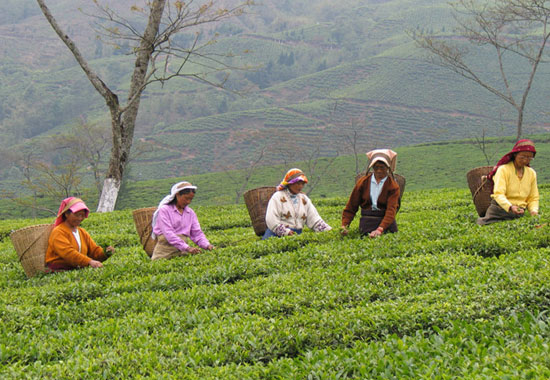
Nearby attractions:There are many attractions of Rangaroon that can be explored by the tourists. One can take a stroll through the garden and observe the tea leaves. From here, one can enjoy the stunning views of Rangaroon valley, Rungdong River, Tiger Hill, the Observatory Hill and Mt. Kanchenjunga range. In the vicinity, there is an eighteenth century tea factory that is still open to the public. This is an ideal place to understand the nuances of tea cultivation and production.
The other attractions of Rangaroon are Mata Singha Temple and Senchel Wildlife Sanctuary. The temple witnesses a large number of devotees on the day of the Baisakhi Purnima, who come here to offer prayers to the resident deity of the temple. The sanctuary is an ideal place for the animal lovers. It is home to some of the rarest animal and bird species in India.
Best visit time: The unique thing about Rangaroon is that it can be explored any time of the year. One can hire vehicle services from Darjeeling to reach Rangaroon. In terms of accommodation, one can avail guest houses or home-stay. These accommodation options are equipped with all the modern amenities.
Rangbang ( Darjeeling – 58 km. from Siliguri )
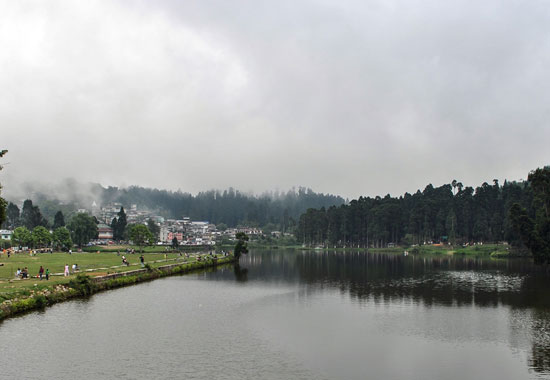
Dreaming of a quiet and cozy home tucked within orange orchards overlooking blue hills, white mountains and endless tea gardens? Your dreams would come true at Rangbang! This beautiful escapade is far from the hustle and bustle of city life yet near to one of the most popular tourist attractions of Darjeeling Hills – Mirik. The beautiful Rangbang homestay, the meandering village paths through tea gardens, pony trails, long nature walks, chirping of unknown birds, the frolicking rivulets and mighty Mt. Kanchenjungha make Rangbang a dream destination for nature lovers like you.
The joyful Rangbang River passes through the hills, tea gardens, orange orchards and villages at Rangbang. You can trek or take a pony ride from the Rangbang homestay and follow this beautiful river along its shores as long as you like. You can visit a naturally formed Rock Garden with some strange formations at Rangbang. A visit to Murmah Tea Garden would be a nice experience too.
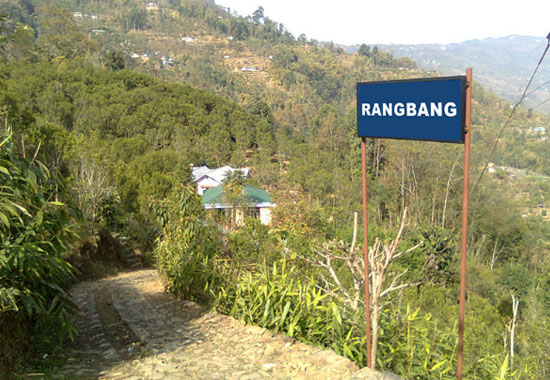
Nearby attractions:The beautiful Sumendu Lake (popularly known as Mirik Lake) surrounded by forests with views of Mt. Kanchenjungha is the most popular attraction of Rangbang. All the attractions in and around Mirik like the temple of Shri Mangal Dham, Devi Sthan and the view points like Rai Dhap are all located within 4 kms of Rangbhang.
Best visit time: You can esape the heat of the plains in summer and the winters are best for the oranges and beautiful sunrise.
Rasikbill ( Cooch Behar – 468 km. from Kolkata )
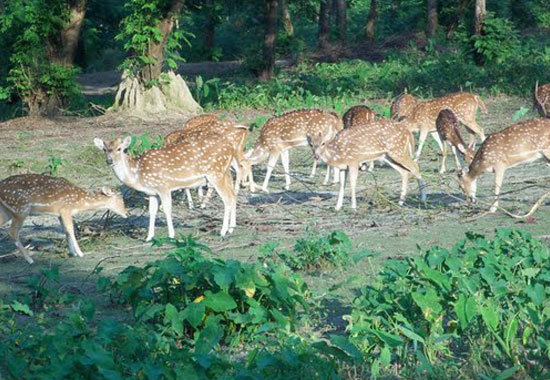
Rashikbill or Rasikbill is a huge lake located in the town of Tufangang in Cooch Behar district of West Bengal. It is a very popular bird watching spot famous for local and migratory birds. It falls on the way to Kamakshyaguri from Alipurduar by train. Rasikbeel is 74 kilometers from Alipurduar by high road. Rashikbill boasts about a jumble of wild flora and fauna. Located around a large lake spreading over 175 hectares area, Rashikbill Lake is surrounded by three dark and dense forests – Nagurhaat, Atasmochar and Bochamari.
The Lake located in the middle of the forest is a beauty spot in the body of Rashikbeel. The lake features sweet water fishes in abundance. The Kutiputti and the Borali that are two popular varieties of fish in North Bengal are found in this lake. Large Aquarium, Crocodile Rehabilitation and Dear Park are attractions in the heart of Rasikbeel. The Deer Park with above fifty deer is a suitable place to roam or relax. The park with movement of deer and the fluttering of birds on the bank of the lake is nice spot to make much of your leisure. There are also a python house, a leopard house and a Tortoise house to visit. Apart from all these Rasikbil is famous for bird watching activities. Numerous local and migratory birds make their nests at Rashikbeel during different times of the year.

Nearby attractions:Nearby attractions of Rashikbeel are no less attractive than attractions of Rashibeek itself. The Baneshwar temple and the Madan Mohan temple in the town of Cooch Behar are recommended for history lovers to visit. The Royal Palace is the focus of attraction with tourists to Rashikbeel.
Best visit time: The best time to visit Rashikbill is from March to June and from September to December as during these times the place is in good favor of weather.
Reshikhola ( Kalimpong – 105 km. from Siliguri )

Reshi or Rishi or Rishi Khola is located in the Kalimpong sub division on the West Bengal –Sikkim Border. Rishi Khola derives its name from the Reshi River (Khola in Nepali meaning a small stream) and has gained prominence as an upcoming offbeat tourist destination as recently a number of resorts have come up on the banks of the river, not surprisingly because of its unique location and scenic beauty.
Topographically, Reshi Khola divides the states of West Bengal and Sikkim.
It's a perfect stopover for tourists intending to visit 'The Silk Route' as it is a nice picnic and camping ground for tourists to have fun and chill out on the banks of the river rishi. It is also an idyllic spot for romancing the moonlight with a light barbecue and bonfire.
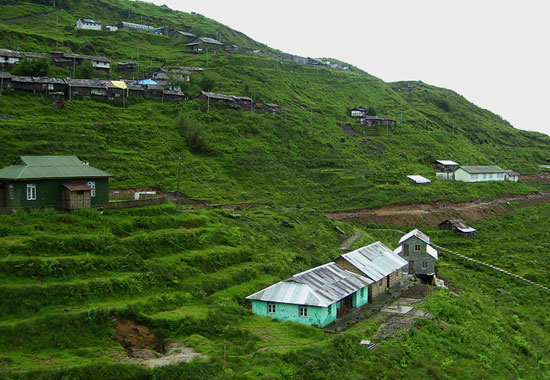
Nearby attractions: Reshi, one of the pristine hill stations nestled in the Darjeeling District is located at a distance of 37 km from Kalimpong. However, Reshi is also recognized as the stopover for your journey to Silk Route in India. From Reshi, you can organize trips to neighboring areas like Pedong, Kupup, Aritar and Zuluk. Adventure loving tourists can also experience a trek to Menmecho Lake.
Best visit time: Reshi Khola welcomes guests throughout the year. However, it is better to avoid the rainy season, as the roads do not stay in proper conditions.
Rikisum ( Pedong – 83 km. from Siliguri )

Rikisum is perched on the picturesquely located Pedong-Lava Road. Nestled atop a hill, with one of the longest views of Mt. Kanchenjungha this charming little hamlet will appear to you as a bit of paradise on earth. Rikisum is all about Mt. Kanchenjungha, an abandoned (some even say haunted) half – burnt British Bungalow, Elaichi farms and nameless villages. Pedong is located nearby and so is the Ramitey View point which is famous for views of Teesta River. Located 6000 feet above sea level, Rikisum offers some of the best sunset and sunrise experiences on the Eastern Himalayas. The view of distant mountains covered with thick virgin forest, the low-lying valleys and deep slopes will offer you an out-of-world experience.
Rikkisum is packed with impressive attractions. A trek to the Rikisum View Point and abandoned Forest bungalow along the thick pine forest is truly rewarding. A spectacular view of the sunrise with a distant sight of a part of Sikkim, Nepal and the snow covered Mt. Kanchenjungha offer a visual delight. Atop the View Point, you will find the remnants of an old lofty bungalow, which was built by the British in 1902. It is popularly known as the Rikkisum Forest Bungalow offering an extensive panoramic view. The dwellers of this village are a happy smiling lot. Round the day, they are engaged in farming of ginger and elaichi. Animal husbandry is another occupation of the villagers. The villagers also share a trading relation with nearby Algarah market.
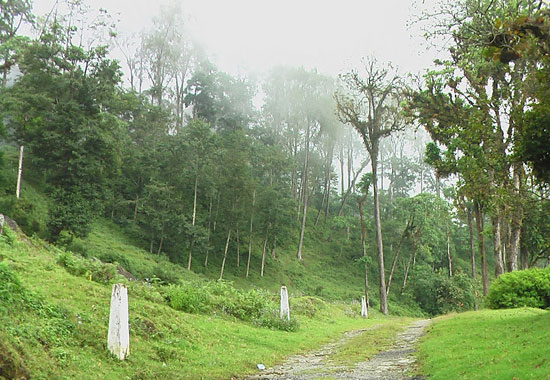
Nearby attractions: Rikisum is very near to Pedong, which is admired by some amazing sunrise and sunset points. One very popular nearby sunrise point is Tinchuley. However, you need to hike for around 45 minutes to reach Tinchuley to savor the sunrise along with a splendid early morning view. As for sunset, nearby Crosshill is another ideal place for the tourists.
Best visit time: Rikisum welcomes tourists round the year. However, visit the place in March and April, to view the Rhododendrons in full bloom. The peak tourist season starts from October to February, when the Mt. Kanchenjungha is visible best.
Rishop ( Darjeeling – 108 km. from Siliguri )
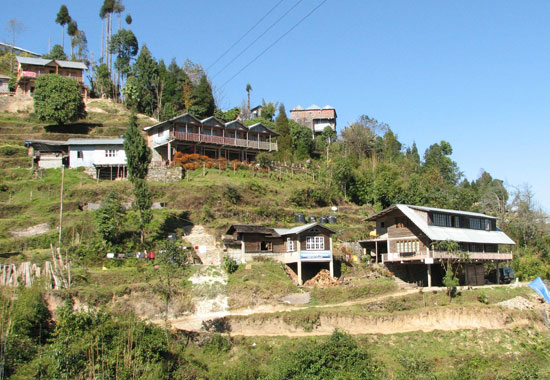
Rishyap is a tranquil, small rural settlement of the Lepcha community in the mountainous landscape at an altitude of 8,500ft. It is only about 28kms to the east of Kalimpong in Darjeeling district. If you are visiting Lava, there is a motorable road of 11kms and also a trekking trail of 4kms from Lava to reach Rishyap.
Rishyap actually forms an integral part of the well known Neora Valley at the foothills of Tiffindara. Although it's a relatively new tourist destination compared to several others in the vicinity, it is still a virgin spot clothed in forests of pine, birch, fir, colorful rhododendrons and orchids with a wonderful view of the vast range of Kanchenjunga and many other Himalayan snow peaks. And this is exactly what the name 'Rishyap' stands for - 'Mountain Peaks and Forests'. And at night look below, an you get amazing sights of the sparkling lights of Gangtok and the small town of Pedong.
And that is all what you can expect to get there. You won't get any city or town life. Which means no restaurants, drinks, food stores or shopping. It's only the nature.
So if nature is all what you get in Rishyap, let's try to take an account of that. As I had mentioned earlier, from most places in Rishyap you get wonderful views of the Himalayan mountains, and there are some spots that offer you sweeping views of the snow peaks over a vast stretch of snow. And from one such spot like Tiffindara if you look around, you will get to see (from left to right) Mt. Kharg, Kokthang, Rathung, Kabru, Talung, Pandim, Kanchenjunga, Simvo, Narsingh and Mt. Siniolchu.
You will also be able to see some parts of the famous Nathula and Jelepla passes. And you will be among the dense concentration of pines, birch, fir and orchids. So if you are a nature lover, then Rishyap is one place which you should keep in your agenda.
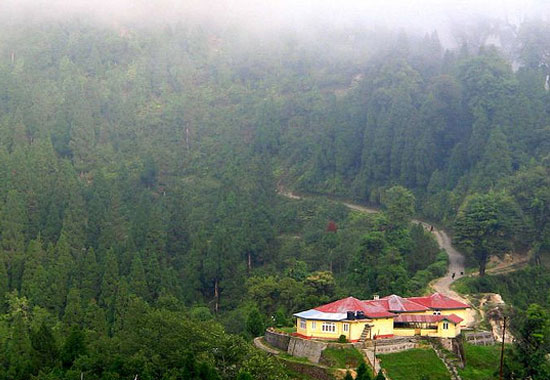
Nearby attractions: Rishyap is admired with a number of nearby attractions. You can also visit Lava just 7 kms from Rishyap, offering clear view of the majestic Himalayas. Another nearby spot is Lolegaon, a charming village in the subdivision of Kalimpong. This small hamlet of Lolegaon is referred by the locals as Kaffer. The Lava-Lolegaon circuit is a major bird watching destination. Some rare species of birds are found in the region. Pedong, located 20 km from the region of Kalimpong also lies close to Rishyap.
You can also make a trip to Jhanidi Dara, located 5 km from Lolegaon. The place mostly covered with thick forest, offers spectacular view of sunrise. The forest in this region has been deemed as a Heritage Forest Site by the forest department, as the area houses some century old Oak and Cypress trees. Another upcoming spot is Kolakham located within the Neora Valley Forest with majestic views of Mt. Kanchenjungha.
Best visit time: You can visit Rishop any time of the year but to get the best views of the Himalayan peaks, one should visit Rishop during winter.
Rongbull ( Ghoom – 52 km. from Siliguri )

Rongbull is located in the hilly tracts of West Bengal. This place is located just before Ghum, another hill station in West Bengal, on the way to Darjeeling.
One would come across Rongbull, which is a non-descriptive village market place in the hilly areas of Bengal. This is the famous place where one can see the famous tea gardens, valleys, waterfalls and endless stretches of Blue Mountains in the Lesser Himalayan foothills of Rongbull village. This is the famous place for having a weekend holiday.
Rongbull is the hill station, where one can find a village resort within a tea estate, overlooking the valleys, forests and tea gardens. While staying here, one can visit the Darjeeling which is just 15 kilometres away from Rongbull. One can easily access a day trip and take local sightseeing trips to Ghoom Monastery, Batasia Loop and Kurseong.
Rongbull provides the trek to the nearby Indrani Waterfalls. Indrani Waterfall provides the thin forest and also it attracts as a bird watching spot to the tourists. Angling is also another option in the Balasun River, which is located in Rongbull.
Tiger Hill is just 10 kilometres from Rongbull. Here one can take a short trip in the early morning from Rongbull Village to witness the golden hue over Kanchenjungha during sunrise and sunset.
The tea estate near Rongbull provides the wonderful panorama of nature to the visitors, who are interested in enjoying the beauty of nature. Visitors can take a long walk through the rows of tea bushes, and enjoy magnificent views of the valley.
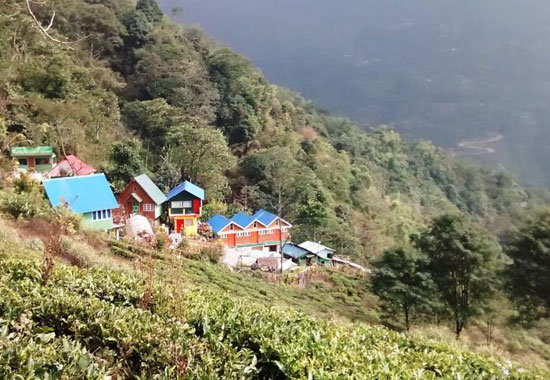
Nearby attractions: The visitors will also be able to take pleasure the unique views of the Himalayan mountain ranges from here, as well as walk down the road for a leisurely stroll. The Himalayan Mountaineering Institute founded by Tenzin Norgay and Sir Edmund Hillary houses records of the expedition that had ever been undertaken to Mount Everest, the highest peak in the world. Rongbull also provides basic mountaineering training to interested tourists.
Another fascinating sightseeing in Rongbull is the Padmaja Naidu Zoological Garden, which is popularly known Darjeeling Zoo, which houses some of the rarest animals found in the Himalayan region, such as the Red Panda, the Snow Leopard, the Tibetian Wolf and the Himalayan Pheasant. A toy train trip in Darjeeling can also be a pleasure trip.
Best visit time: One can visit Rongbull anytime of the year. The monsoon brings new leaves to tea bushes and forests and gives a heavenly lush to Rongbull and its surrounding areas. The winters are known for hygienic and fresh weather.
Samsing ( Dooars – 82 km. from Siliguri )
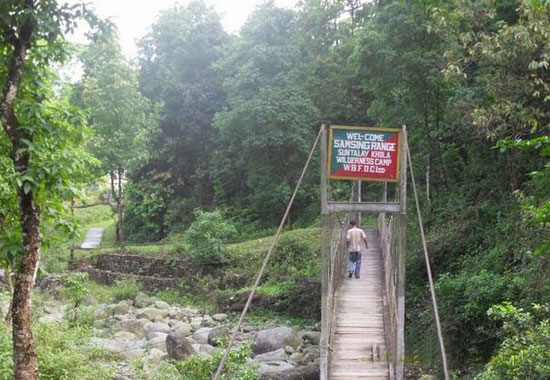
Situated at an elevation of 3000ft, Samsing is a nice cool shady place, ideal for nature lovers. The journey to Samsing is a memorable one, as you slowly ride uphill through the most picturesque Dooars tea garden on the rolling hill slopes.
At a distance of 82 km from Siliguri, it takes about 3 hours to reach Samsing from Siliguri through the most picturesque landscape. As you enter Dooars through the National Highway 31, you will cross Malbazar to reach Chalsa. From Chalsa take a left turn and drive on for 15 kms via Meteli to reach Samsing. The last few kilometres drive is a feast for the eyes as you pass through some of the most picturesque tea gardens of Dooars including the Chalsa Tea Garden, Zurantee Tea Garden and Samsing Tea Garden. The road is relatively narrow but there are few vehicles traveling through this route as the road ends at Samsing.
As you enter Samsing, the first village you reach is Tea Garden labour line. Not much accommodation options are available here. About 4 kms ahead at Suntalekhola there is WBFDC (Forest Department) tourist cottages which are arguably the best place to stay around here. Near Suntalekhola, in and around faribasti village there are several homestays that have come up which provide basic but decent accommodation. On the banks of River Murti, at Rocky Island, there are a few small eco-resorts and home stays. These places also offer basic amenities but are advantageous especially for groups interested in light adventure activities. There are rock sites available nearby as well as River Murti which is an ideal spot for soft adventure activities. For further information about accommodation at Samsing, as well as booking the accommodations, you may contact our helpdesk by submitting the query form here.
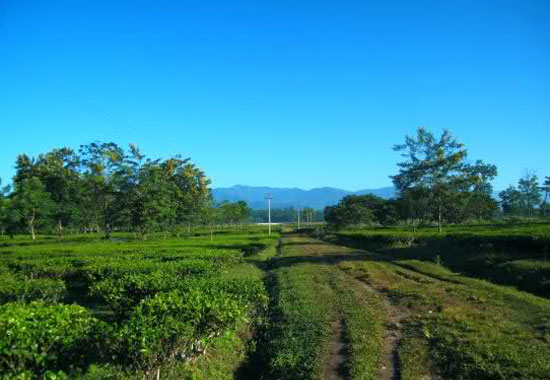
Nearby attractions: Suntalekhola is where many tourists stay overnight. The place is about four kilometers further up the road from Samsing. The road ends here close to a small stream named Suntale Khola (`Suntaley` = Orange and `Khola` = Stream). There are WBFDC cottages and a bicameral bungalow. You have to walk over a small hanging bridge to reach the WBFDC forest resort here.
Faribasti
Next to Suntalekhola is the small picturesque village of Faribasti. The village has about 50 households and is very well maintained. Flower gardens are common in almost all households. Some of the households have started homestay for tourists with active support from naturebeyond. You can walk through the village and its paddy land.
Rocky Island
Another attractive tourist spot is the `Rocky island nature resort` on the banks of river Murti. This is about 2 km from Samsing. The view of the river and surrounding forests are excellent from Rocky Island but tourist amenities are basic. Accommodation is arranged in small Tents for overnight visitors. The owners of this small resort are true nature lovers and have so far resisted any attempt to commercialise this unique place. naturebeyond is in regular touch with them and actively support their endeavour.
River Murti
It is one of the most beautiful rivers of Dooars. The small river flows down from Neora Valley National Park and passes through Samsing and eventually meets Jaldhaka river near Gorumara National Park. The river is small enough to crossed on foot during most of the year except the Monsoon months. At Samsing you can approach River Murti either at Rocky Island or near the old forest Bungalow.
Another fascinating sightseeing in Rongbull is the Padmaja Naidu Zoological Garden, which is popularly known Darjeeling Zoo, which houses some of the rarest animals found in the Himalayan region, such as the Red Panda, the Snow Leopard, the Tibetian Wolf and the Himalayan Pheasant. A toy train trip in Darjeeling can also be a pleasure trip.
Best visit time: Samsing welcomes tourists throughout the year.
Selim Hill ( Kurseong – 35 km. from Siliguri )
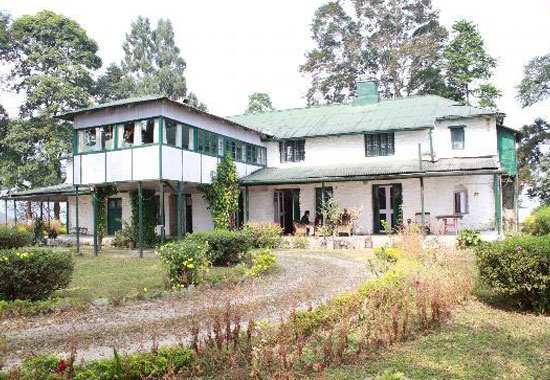
Selim Hill Tea Estate is just 35 kms from Siliguri located at an altitude of 4,500 feet overlooking the lush Mahananda Wildlife Sanctuary on one side and the magnificent Mt. Kanchenjungha on the other. The 150 year old Tea Bungalow is tucked into one of the oldest and finest tea estates of Darjeeling, decked with period furniture and the old world charm of a tea planter's life. Selim Hill Tea Estate was set up by the British planter Mr. Henry in 1800. It is located off the Hill Cart Road towards Darjeeling.
The Selim Hill Tea Estate is a bio-dynamic tea garden divided into upper and lower segments across the slopes. You can savor the spectacular views of River Mahananda and Balasun River Valleys and on a clear morning catch a glimpse of Mt. Kanchenjungha over Kurseong town in the distance. You can roam around this beautiful lush tea estate all day accompanied by the distant hoots of the Darjeeling Himalayan Railway passing through the Mahananda Forest.
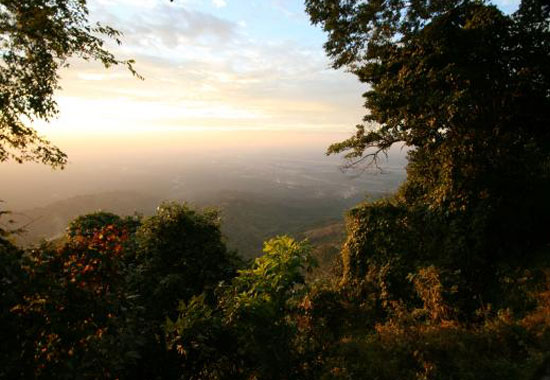
Nearby attractions: Within a walk of few minutes, there is the renowned Agony Point of 20th Mile Loop of the Darjeeling Himalayan Railways locally called 'Smritivan Park.' You can also visit the nearby orphanage of Mother Teresa – 'Santha Bhawan.' The nearest railway station of Gayabari of the Darjeeling Himalayan Railway which is a world heritage site is also located nearby.
Best visit time: You can visit Selim Hill anytime of the year. The winters are addictive, the monsoons are lush and the summers are cool here.
Serrani Tea Bungalow ( Lankapara – 130 km. from Siliguri )
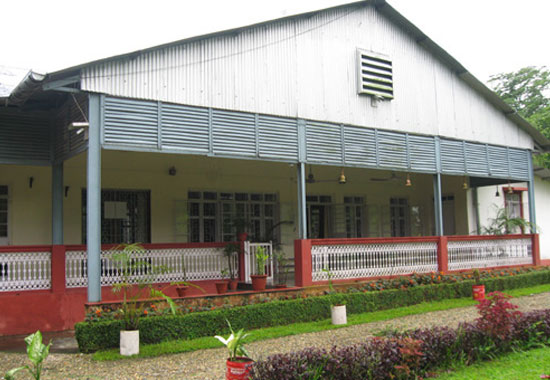
Sometimes our heart yearns for a relaxing break in the lap of nature enveloped with tranquility, away from the bustling city life. The Serrani Tea Bungalow, nestled in one of the most admirable backyards of Duncan's tea estates with Jaldapara Wildlife Sanctuary on one side and the hills of Bhutan on the other is a picture perfect destination offering a serene retreat. The spectacular view of the sprawling acres of tea gardens on the foothills of the Himalayas is truly enthralling.
Nestled in the Dooars region, Serrani Tea Estate is a perfect destination for savoring the forests, wildlife and the hills. A stay of few days at Serrani will let you discover all about the life in a tea estate from dawn to dusk. A visit to the nearby tea factory of the estate is also a lasting experience.
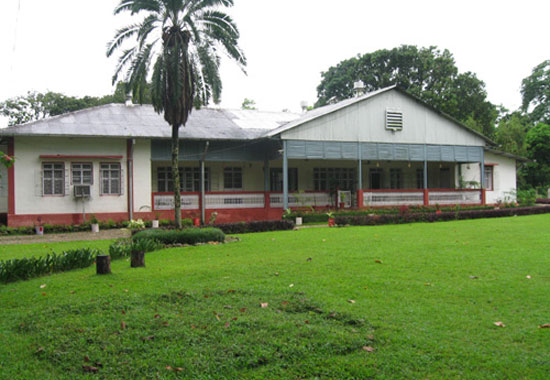
Nearby attractions: The entry checkpost of Jaldapara Wildlife Sanctuary is just an hours drive from the Serrani Tea Bungalow. This rain forest sanctuary is enriched with lush vegetation and an exotic variety of wildlife. The view of the swift flowing Torsha River is breathtaking. The only way to explore the forest is by riding elephants or taking a jeep safari. Jaldapara comes second in boasting the maximum number of rhinos population in India after Kaziranga National Park in Assam.
Close to the sanctuary, Totopara is another major spot of tourist interest, especially for the travelers who are inclined to ethnic tourism. It is an exclusive experience to observe the livelihood and the traditional culture of the Toto tribe – one of the rarest ethnic communities across the world.
You can also visit the remnants of a thousand years ancient fort of Nal King, located deep inside the Chilapata Forest.
Best visit time: The Serrani Tea Estate invites tourists all round the year.
Sillery Gaon ( Pedong – 92 km. from Siliguri )
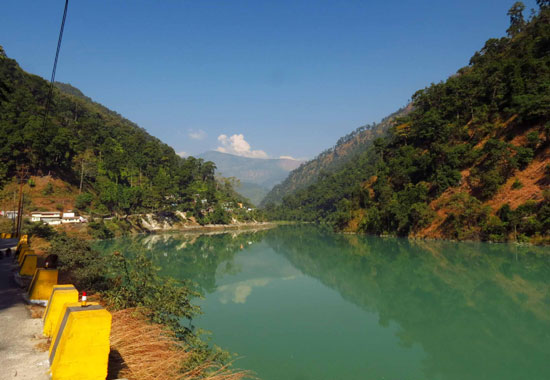
Enveloped with tranquility, Sillery Gaon is a picture-perfect Himalayan hamlet, which nestles at a height of around 6000 feet. Sillery is located 96 kms from New Jalpaiguri via Kalimpong. The scenic beauty of the place is undoubtedly eye appealing. Gorgeous view of the mighty Mt. Kanchenjungha can be savored from Sillery Gaon. The music of wilderness, the chirping of the birds and the fragrance of nature of this pristine hamlet will soothe your senses and refresh your mind. This intimate village adorned with pine trees is nowadays lovingly called New Darjeeling. This charming village is the haven of varieties of exotic bird species, which makes it an ideal place for passionate bird watchers. Enjoy a nature trail, while enjoying the beauty of the picturesque landscape of the destination.
You can enjoy boating at the Aritar Lake (Lampokhri) or step down the Reshi Bridge to join the adventure camping site, where fishing and camping is arranged for the tourists. You can also enjoy short treks to various sightseeing points around Sillery Gaon like Tinchuley, Ramitey and Damsang Fort. The place is also a heaven for avid bird watchers. You can also enjoy nature walk around the picturesque landscape of the village. However, the best thing to do is to sit idle and watch the mighty mt. Kanchenjungha changing colours.
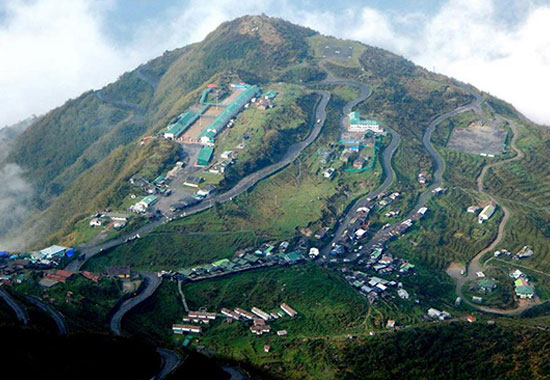
Nearby attractions: An excellent and outstanding tourism spot, Sillery Gaon boasts immense travel potential. There is a fascinating hilltop near Sillery Gaon, famously known as Tin Chuley. You can enjoy a 360-degree view of the mighty Himalayas from this site, along with the town of Sikkim, Jeep La and Nathu La. This place can be reached by car or you can also trek to Tin Chuley. Another amazing site near Sillery Gaon is Ramitey Dara, a famous vantage point, which offers a panoramic view of the winding River Teesta, with around 14 turns along the legendary Himalayas. A visit to the Damsang Fort, located 4 km away from Sillery Gaon is also worth a visit. The fort was constructed in 1690 by the Lepchas. However, only the ruins of the fort exist now, since it was destroyed by the British, post Anglo-Bhutan War of 1864. Wind up your day by appreciating the breathtaking beauty of the Silence Valley, a small stretch of forest with grassy land, shrouded with ultimate serenity.
Sillery Gaon is encircled by Pedong, Rishi and Aritar. The village is the home to the highly revered Sanghen Dorjee Monastery, located near Pedong. The origin of the monastery can be traced back 300 years ago, during the rule of Bhutanese in Pedong. The old section of the monastery is decked with some beautiful wall paintings, depicting Tantrik Buddhism. The center of attraction of the monastery is the mummified body of a holy Bhutanese priest.
If you are visiting the place in April-May, do not miss the "Chyam" dance held at this place. Tourists also visit Cross Hill near Pedong, built by Fr. Augustine Desgodins in 1882. It is highly revered as a site of Pilgrimage for the local Christian community. Shahid Park is another "must visit" location of the destination, located 2 km from Pedong bazaar. A memorial stone has been laid at the park, to honor the memory of a local young soldier of Indian army, Late Palender Raj, who sacrificed his life at Thangdhar Jammu & Kashmir sector (Kargil War). Panoramic view of Sikkim can be viewed from this park.
There is a wonderful viewpoint called Rikisum, on the way from Algarah to Lava, which is worth visiting. The scenic beauty of Kashyone village, located 8 km from Pedong Bazar truly offers visual splendor. The splendid view of the union of Tista River and Rongpo Khola, makes an incredible sight behind this village. This pristine village is dotted with Cinchona plantation. Explore a little further to visit the beautiful Ranibon that has been declared as a preserved forest. The place houses a 300-year old Lepcha house, which is the only specimen of the exquisite Lepcha craft works.
Trips can also be made to Reshi Bridge and Reshi Khola, nestled 15 km from Pedong Bazaar. Reshi Khola is a wonderful romantic escape. The Aritar Lake or Lampokhri is a remarkable eco tourism spot, located 16 km from Reshi Bridge in East Sikkim. The highest point here is famously called Mankhim, which offers a striking view of the majestic Mt. Kanchenjungha on the southwest and Jelep La and Nathu La towards the northeast. Another celebrated viewpoint at Aritar is Love Dara.
Best visit time: Sillery Gaon welcomes tourists all through the year. However, it is advised to avoid the rainy season. Winter is the most preferred season, since clear view of the range of Mt Kanchenjungha can be seen during this time.
Singell ( Kurseong – 40 km. from Siliguri )
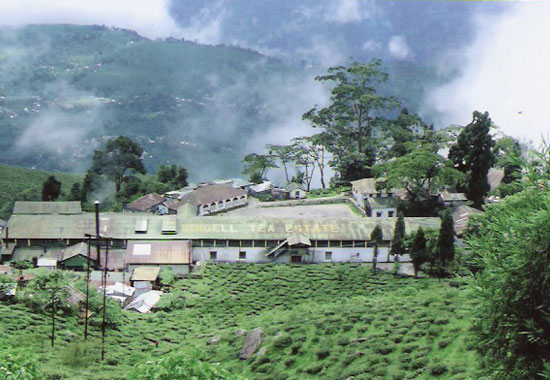
Situated at an elevation of five thousand feet above sea level, and located very close to both Kurseong Town and Darjeeling, Singell is a beautiful but lesser known destination. It is surrounded on all side by alpine villages and tea-estates. It is perfect for those who wish to enjoy several days of perfect calm and solitude, since Singell, given its location and nature, is never crowded and is free of the usual hustle and bustle of city life.
During the British era, Singell and nearby Kurseong was a town for resting and convalescence, especially for wounded soldiers. Owing to its remoteness and solitude, it provided the perfect place for the same. With several British built bungalows and villas spread all over the landscape, lush tea gardens, colonial churches and pine forests Singell will never disappoint you with all its charm.
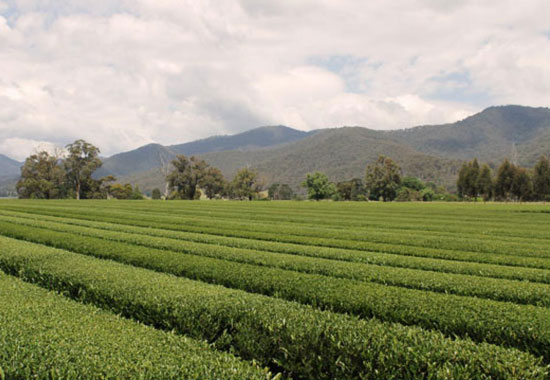
Nearby attractions: Tea Gardens – There are several tea gardens of both historical and commercial significance in Singell. These include Castleton, Makaibare, Singell, Goomtee and Ambotia. Visitors to any of these gardens will be able to get a glimpse of the manufacturing process of the finest Darjeeling tea in the world, and will be enriched for the experience.
Deer Park – Located on Dow Hill, this is a deer sanctuary which once held a large and thriving population of the animal; however deforestation has resulted in loss of large numbers. Visitors may still get to catch a glimpse of the animals, but entry into the forested area is strictly prohibited.
Forest Museum – The Forest Museum is situated on Dow Hill. It gives visitors a firsthand look into the animals that were, and are present in Singell. It is a must for naturalists who wish to get a glimpse of Singell's natural history and the animals that may now have become extinct from the mountains.
Giddapahar – This site provides a breath-taking view of the mountains, and is excellent for photography. It also houses the Giddapahar Seti Mata Temple, a rock temple which is dedicated to Goddess Durga. It can serve as an excellent tourist spot for both devotees and visitors alike.
Best visit time: Singell may be visited any time of the year.
Sitong ( Kurseong – 55 km. from Siliguri )
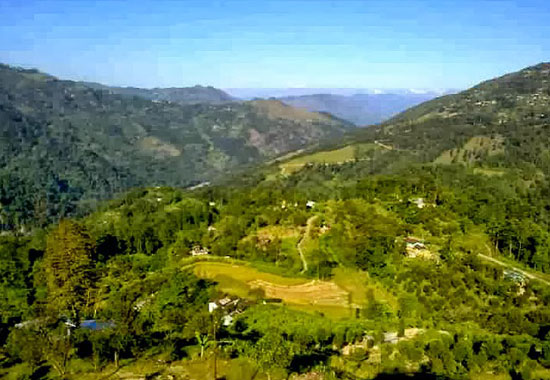
Sitong is a picturesque hill hamlet situated in the foothills of Darjeeling Himalayas. During the months of October to December, this village transforms into an 'orange village'. The hamlet of Sitong is mostly inhabited by the Lepchas. A number of trekking routes start from Sitong. You can visit Mongpu Bungalow by car. The houses on terraced slopes and orange orchards make Sitong an ideal place to spend time with nature. You may also visit the church on the hill top.
You can visit the local church. Previously, there used to be a 100-year old Bamboo church here but now a new building has come up. There is a Bamboo Bridge, which you would love to see wobbling when someone crosses. But when you are in Sitong, there is one thing you cannot miss doing – "Enjoying Oranges."
When the oranges bloom, the whole village is covered in a hue of orange. You can also spend time walking all around the village along the farms or sit idle on the banks of Riyang river and watch the Lepcha kids returning home. In Sitong, you would love doing "nothing."
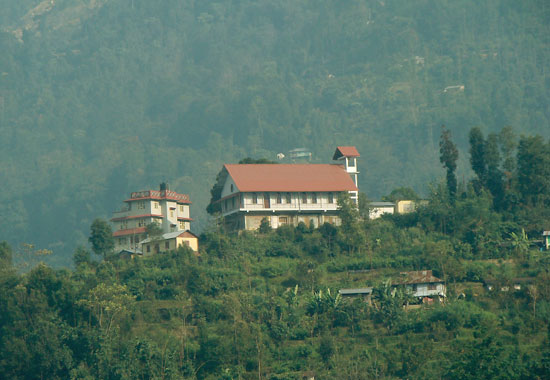
Nearby attractions: The house of Rabindranath Tagore at Mongpoo is just 20 kms away and Latpanchar – the highest point in Mahananda Wildlife Sanctuary is 13 kms. from Sitong. Latpanchar is also known for being the home to the Himalayan Salamander and numerous species of birds and butterflies. Other touristic destinations like Kurseong, Dilaram, Bagora are all within 20 kms of Sitong.
Best visit time: November, December and January is the best time to see oranges is Sitong.
Takdah ( Darjeeling – 90 km. from Siliguri )
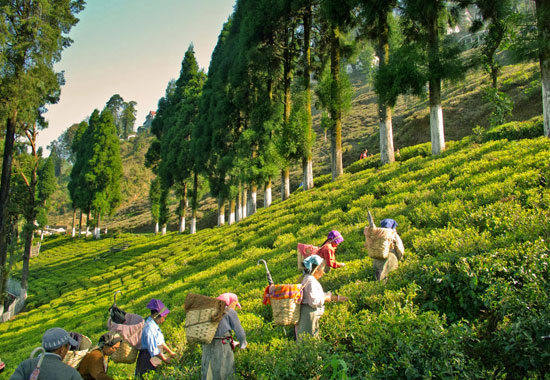
Takdah Cantonment is a settlement located in Darjeeling district, West Bengal, India. It is one of the upcoming tourist centres of the Darjeeling hills. It is called Takdah, which literary means always covered, in one of the local folk-lore, as you would know when you visit the fog: you will never miss.
There is a religious monastery or gumpha, (Dechhen Pema Tshoiling Monastery) centrally located in Takdah, just beside the caves of Mata Durga. This monastery and the caves were looked after by Rev. Lama Karma Gyaltchen (Bal Me Me) till 1st May 2007. Other than these, there are the British Bungalows (locally known as Kothis) built mostly between 1905 and 1915. The most famous Colonial Bungalows of Takdah are the clubhouse, forest bungalow, Shikharini, Rani Kothi (presently a church), Att Number Kothi and the famous Sonpur Palace now in ruins. Some of the colonial bungalows have also been taken up by local schools like Green Shields and Griffith High School. There are around 12 colonial bungalows in Takdah. Drenched in colonial charm, Takdah is surrounded by larges stretches of pine forests and tea gardens like Runglee Rungliot, Takdah Tea Estate, Gielle, Teesta Valley and Namring. The Orchid Centre, Dokan Dara (local market) and the Durpin View Point are some other destinations where you can visit during your stay. Another interesting nearby place to visit is the 100 year old suspension bridge called Barbatey bridge."
Doing nothing is what you should do when you are in Takdah. Going for sightseeing, taking a nature walk around the local villages and pine forests and enjoying a picnic in the lawns of the colonial bungalows are few other things you may like doing in Takdah. For tourists who have never seen a weekly village market, they will get to see this on Thursdays, when locals from nearby villages turn up to shop at Dokan Dara in Takdah.
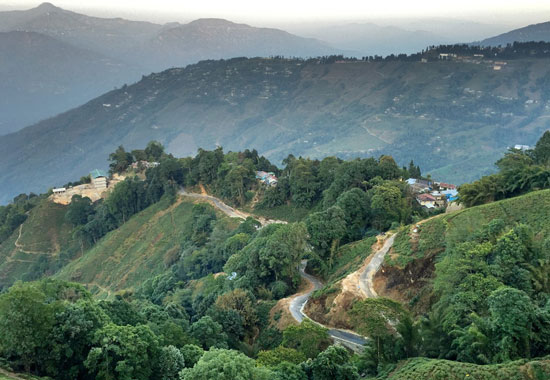
Nearby attractions: The little village of Tinchuley, which enjoys some of the most beautiful views of Mt. Kanchenjungha is only 4 kms from the heart of Takdah. The famous orange orchards of Bara Mangwa and Chota Mangwa are around 12 kms away and the mesmeric views from Peshoke Tea Garden view point is 14 kms away. You can visit the nearby destinations of Kalimpong (40 km) and Darjeeling around 27 kms away.
Best visit time: Takdah can be visited anytime of the year.
Tinchuley ( Darjeeling – 80 km. from Siliguri )
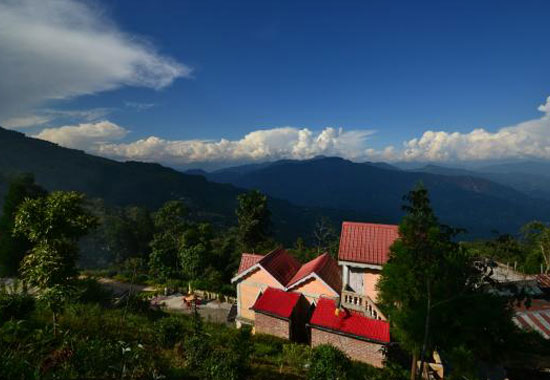
Tinchuley is a small mountain village (rather a hamlet) in Darjeeling district and located at an altitude of 5,800ft, and just 3kms above Takdah. The word Tinchuley means Three Ovens (i.e. Tin Chullahs). And such name to the village has been given because of the three prominent hill tops that surround the place and which from far look like ovens or chullahs. Tinchuley faces the Kalimpong hills.
It's a developing tourism place. In fact the organization WWF (World Wide Federation) has been actively assisting some 17 families here to develop a model organic village and promote village tourism. Some of the village homes have been extended and converted into guesthouses or homestays for tourists. The villagers with support from WWF have adapted modern farming methods and developed floriculture, vermiculture, and other organic projects.
So why should you plan a trip & stay in Tinchuley? Simple. If you love nature, the lovely views of the Himalayan range, like to see the meandering Teesta flow through the mountain landscapes, enjoy tea gardens, orange orchards, walking along village trails, watching birds, local culture, people and food, then this is the right place for you. On top of it, you are away from the typical crowd of typical hill towns. Tinchuley is a calm and quiet village offering the tranquility and nature which most city dwellers long for. And there are several great attractions, beautiful places and spots nearby.
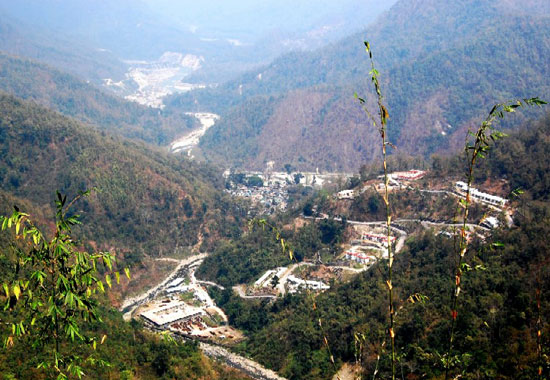
Nearby attractions: A magnificent sight of Kalimpong in the distance. The winding way of the Tista River. The towering peak of Mt. Kanchenjunga and numerous walks through winding paths across villages and forests. You can also visit a local monastery. Darjeeling is nearby and so are the numerous Tea Estates like Runglee Rungliot and others.
Best visit time: The best time to visit Tinchuley ranges from the month of September to the month of April.
Tiya Bon ( Dooars – 68 km. from Siliguri )
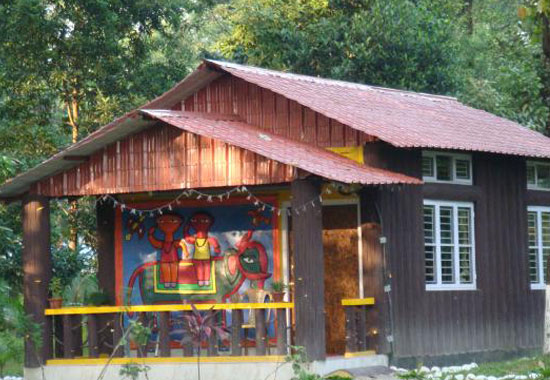
Tiya Bon is located near the Khariar Bander Forest, at a distance of 63 kilometers from Siliguri. Situated amidst tea gardens and forests, it is an interesting place for both adventure and nature loving tourists. The Tiya Bon Resort spans an area of 2.33 acres and offers views of the surrounding forests and gorgeous hills. With the wild Dooars at your doorstep and the Gorumara Forest your backyard, you'd surely love the experience of Tiya Bon. Other than the Gorumara National Park, Tiya Bon also shares close proximity to Chapramari, Khunia, Gajol Doba, Sakham and hill stations like Samsing, Suntaleykhola, Jhalong and Bindu.
The Gorumara National Park is located near to Tiya Bon in the Dooars region, in the district of Jalpaiguri. In 1949, this small forest area was declared a wildlife sanctuary and in 1994, it was proclaimed a National Park. The National Park spans an area of 79.99 square kilometers and houses a variety of flora and fauna. It is also famous for being the home to the Great Indian one-horned rhinoceros and the Indian Bison.

Nearby attractions: The other famous forests that can be visited from Tiya Bon are Chapramari forest and Jaldapara Sanctuary. The Chapramari forest is situated near National Highway 31 and can be easily reached by crossing the river Teesta and following the route that leads to Dooars. The Jaldapara Sanctuary is also situated near National Highway 31 and is at a distance of 80 kilometers from Tiya Bon. The other forested areas located nearby are Khunia and Sakham.
Best visit time: Though the resort can be visited throughout the year, it is better to avoid the rainy season if you want to visit the forests.
Tumling ( Darjeeling – 92 km. from Siliguri )

Tumling is a small hamlet in Jogmai VDC, Ilam District of Nepal. A tourist attraction in Eastern Himalayas at an altitude of 2970m(10,000 ft), its population is composed mostly of Gurung families, with the total population being a mere 15 in number. It is roughly 35 minutes' walk from Meghma and not far from Darjeeling. Only vehicle going to Tumling is the old Landrover from Manebhanjan. Lodging in this hamlet consists of mainly the Mountain Lodge, which has a spectacular view of the Kanchenzunga seen from its room.
It is roughly 10.5 km uphill from the town of Manebhanjan and is a favorite stop for the trekkers going up to Sandakphu. From Manebhanjan where the trek or the Jeep safari starts, Tumling is at a distance of about 10.5 km. As you approach Tumling, you will notice small cottages and huts from a distance. There are probably only 10 to 12 Nepali families who live here. There are also few private lodges and huts that have come up here to cater to tourists & trekkers heading towards Sandakphu. Tumling actually is part of Nepal although there is no restriction for Indians or foreigners with Indian visa. In fact the border between India and Nepal in this part is quite blurred and there is a free way for all. One is able to see the beautiful Kangchenjunga Range from here and going forward for about 15 minutes one can notice the Mount Everest.
Tumling offers magnificent view of the distant Mount Kanchenjunga. On a clear night, Tumling offers views of beautifully-lit places like Kurseong, Siliguri, Darjeeling, Pasupati and other settlements. A trek to Dhotrey can also be availed from Tumling and the length of the trek route is some 6 kilometers. The trek is availed through the forests of blooming rhododendron flowers.

Nearby attractions: From Tumling, you can avail a trek to the Singalila National Park, the route of which passes through the Indo-Nepal border. Apart from a wide variety of flora, the place is renowned for being home to various kinds of animals like Red Pandas and birds.
You can opt for a trek to Meghma. Meghma can be reached by crossing Chitre, the Buddhist settlement. At Meghma, the trail bifurcates and the left-side trail passes through Nepal and the right-side trail leads to Tumling or Tonglu in India. Tonglu is situated at an elevation of 3070m and has a few trekker huts. At Tumling, in Nepal, the trails meet again.
Best visit time: The best time to visit Tumling is during the summer season, when tourists can enjoy the majestic sights of the place in a comfortable weather.
Zurrantee ( Dooars – 96 km. from Siliguri )
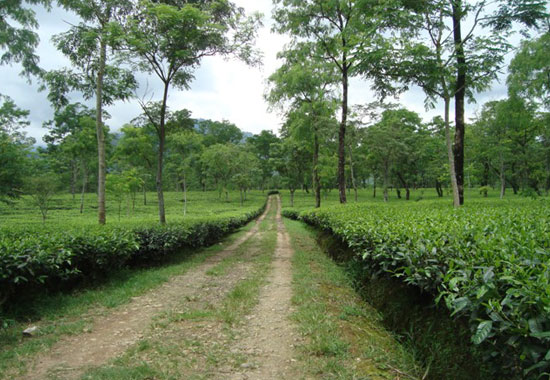
Zurrantee or Juranti is a 119-year old British Bungalow set amidst lush green tea gardens surrounded by mountains in the distance. This teasort is located at the foothills of the Eastern Himalayas, on one of Dooar's highest points and lies between Murti and Neora rivers. Zurrantee offers a variety of flora, sprawling tea gardens and the long lost feel of the colonial days.
Zurrantee is one of the four tea estates located in the region. The sprawling tea gardens, the tea factory, the heritage bungalow and the Zurrantee River are the main attractions of this place. You can only admire the beauty of the place and rejuvenate your senses amidst its tranquil environment.
You can take a nature walk through the tea gardens and enjoy the beautiful surroundings or can opt for fishing in the Zurrantee River. You can also arrange a picnic in nearby Samsing or Suntaleykhola or play Golf and tennis at the nearby Chalsa Club.
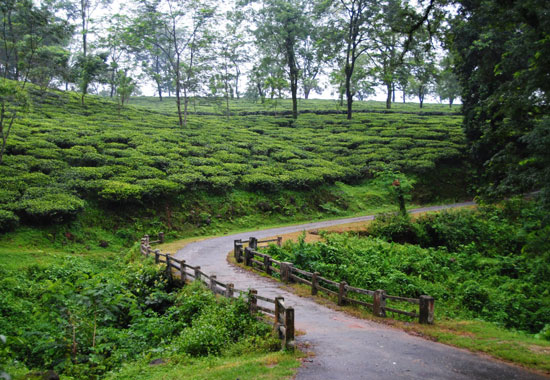
Nearby attractions: The Neora Valley Reserve Forest is at a distance of 45 minutes from Zurrantee and the Gorumara National Park is located at a distance of 35 minutes. You can also visit the famous tourist attraction of Suntaleykhola and Samsing located nearby or enjoy special trips to Lava, Loleygaon or Kalimpong.
Best visit time: Zurrantee can be visited throughout the year but if you want to visit the forest, it is better to avoid the monsoon season.
Cooch Behar ( North-East )
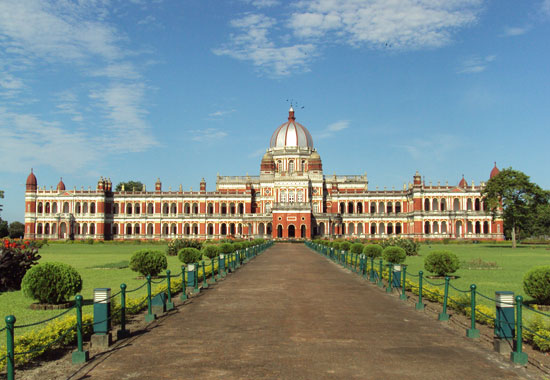
Cooch Behar is the district headquarters of the Cooch Behar District in the Indian state of West Bengal. It is in the foothills of the Eastern Himalayas at 26°22′N 89°29′E. Cooch Behar is the only planned town in North Bengal region with remnants of royal heritage. One of the main tourist destinations in West Bengal, it is the location of the Cooch Behar Palace and Madan Mohan Temple and has been declared a heritage town. It is the maternal home of Maharani Gayatri Devi.
During the British Raj, Cooch Behar was the seat of the princely state of Koch Bihar, ruled by the Koch dynasty. After 20 August 1949, Cooch Behar District was transformed from a princely state to its present status, with the town of Cooch Behar as its headquarters.
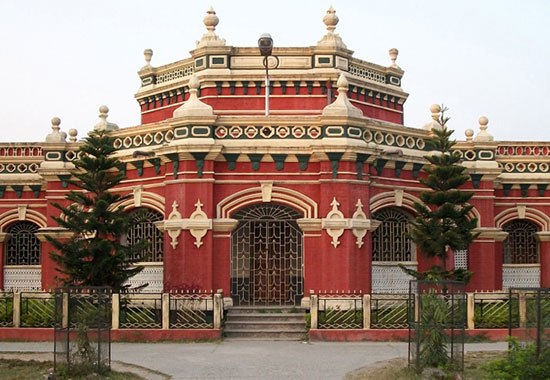
Nearby attractions: Among the tourist attractions in Cooch Behar, what strikes first in our mind is the Rajbari or the palace of the Kings and the adjoining royal buildings as well as the endless royal facts & stories. In fact, being the place of the Raj (monarchy), the district captures the bygone glorious past in the moods of local people even today. The peace loving people of Cooch Behar even boast of this beautiful city where the Maharajas (kings) used to stay and never tires, if not laments in excitement, narrating the Raj stories.
It is obvious that anyone who has visited Cooch Behar city cannot keep sound in not appreciating this beautiful planned city with infrastructure quite similar to any modern planned city. Moreover, the place is so quiet & calm, void of the hassle-n-bustle of busy cities. And above that the climate here like the rest of North-Bengal is just fine to let you feel the freshness & beauty of nature all around.
Best visit time: Cooch Behar is known for having a pleasant weather throughout the year. It can be visited any time throughout the year. Some visitors prefer visiting the town during the festive season as the enthusiasm, excitement and unity of the town is worth seeing then. Not only does festive time gives you the opportunity to know a region culturally more, it also gives you the chance to become a part of it rather instantly. You can visit Cooch Behar during Rath yatra in June- July, Rass Mela, just after Durga Pujo and even during Hujur Saheb Mela during February and March.
Dalkhola ( North-East )
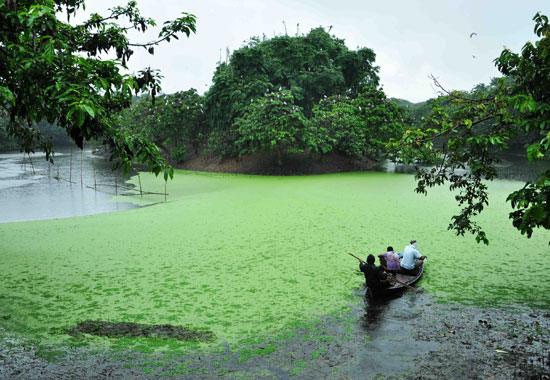
Dalkhola is a town and municipality located in the Uttar Dinajpur district of the state of West Bengal, India. It is the second most important commercial city in North Bengal.
Dalkhola is the largest exporter of Maize in West Bengal. In Dalkhola, a national level Power Grid was established in 1973, which expanded the availability of electricity to the Municipality. Other developments include a Flour Mill, and maize processing company which use the crops produced by local farmers.
A tourist motel is under construction near buri Mahananda river. Planned road projects in Dalkhola include a bypass road and bridge overpass to reduce traffic congestion in main market area of Dalkhola.
The new foothpath with kones and tiles are connected on the one side of NH 34.
And the Dalkhola municipality planned a big market-like shopping mall on Dak Bungalow Road.
Jalpaiguri ( North-East )
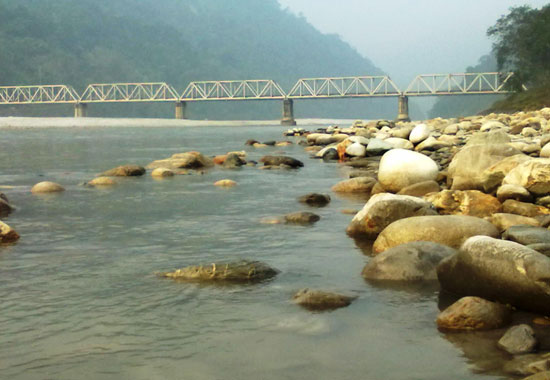
Jalpaiguri is a city in the Indian state of West Bengal. It is the largest city and the headquarters of the Jalpaiguri district, and the divisional headquarters of the region. The city is located on the banks of the Teesta River which is the second largest river in West Bengal on the foothills of the Himalayas. As of the 2011 cansus, the city had a population of 107,351. and the metropolitan area 169,002 The city has become an important trade center of West Bengal. It is a principal commercial, tourism, transportation, and educational center of the North Bengal region. It lies 42 kilometers away from Siliguri which is its twin city.
The name "Jalpaiguri" comes from the Bhutanese term je-le-pe-go-ri, meaning a place where warm clothes are traded, suggesting a trading centre. Another suggestion is that it is from the word "Jalpai" meaning olive, and "Guri" meaning a place. The city of Jalpaiguri once had many olive trees.
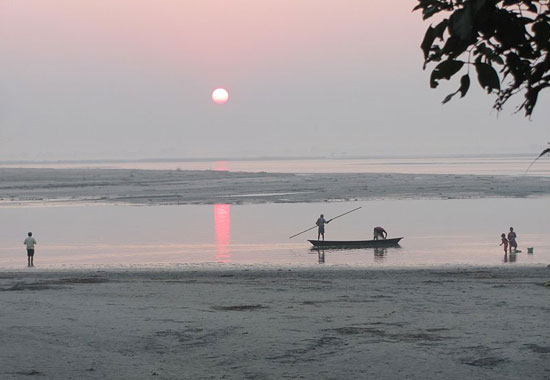
Nearby attractions: Jalpaiguri Palace, Raikatpara Palace Gate, Bay of the River Teesta, Rajbari Dighi, Jalpaiguri, Jogomaya Kali Temple, Temple Street, Chapramari Wildlife Sanctuary, Bay of the River Teesta, Raipur Tea Estate, Rangdhamali etc.
Best visit time: Jalpaiguri can be visited any time through the year, however the best time is October to March. Some visitors prefer visiting the town during the festive season, as the enthusiasm, excitement and unity of the ton is worth seeing then. During November and December, exclusive tourism festival called Teesta Tea and Tourism fest are celebrated, it is a great time to visit the city as these festivals are real fun to be a part of, there are multiple activities, water sports, cultural events happening, it is like the whole of Kolkata has come together at one place to extend a warm welcome to its tourists. In the months of February and March, the town celebrates Jalpesh Mela on the occasion of Shivratri with grand festivity.
Malda ( North-East )
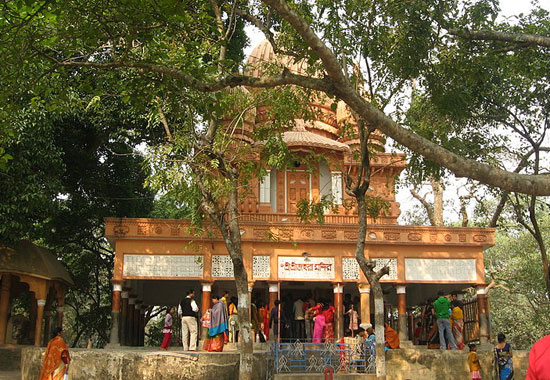
Malda district (also spelled as Maldah or Maldaha) is a district in West Bengal, India. It lies 347 km (215 miles) north of Kolkata, the state capital. Mango, jute and silk are the most notable products of this district. The special variety of mango produced in this region, popularly known by the name of the district, is exported across the world and is acclaimed internationally. The folk culture of gombhira is a feature of the district, being a unique way of representation of joy and sorrow of daily life of the common people, as well as the unique medium of presentation on national and international matters. According to the National Investigation Agency Malda is believed to be a hub of a fake currency racket. It is reported that 90 per cent of the fake currency that enters India from Pakistan via Bangladesh comes in from Malda which borders the neighbouring country.
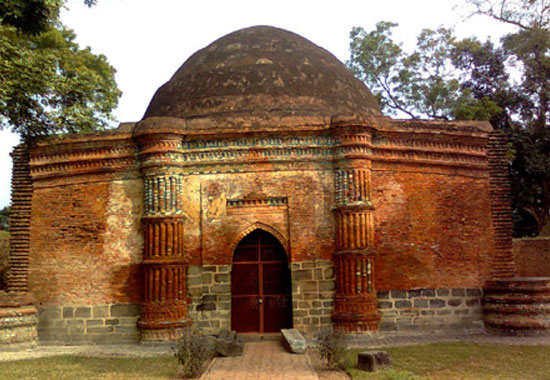
Nearby attractions: Adina Mosque, Gol ghar, Eklakhi mosque, Adina deer park, Jami Masjid, Pandua Shrine, Chanchal palace, Nimai Sarai Tower etc.
Best visit time: October, November and March are the best months to visit Malda. Malda experiences a very hot summer and overflowing monsoons. Though summer time doesn't have any issues, the heat may get overwhelming. Monsoon showers are very frequent and often disruptive. Hence, the early winter and early spring season is the idol time, owing to the comfortable climate and picturesque backdrop. Winters might also serve as a good time to visit, but only if you're a winter climate lover.
Dooars ( North-East )
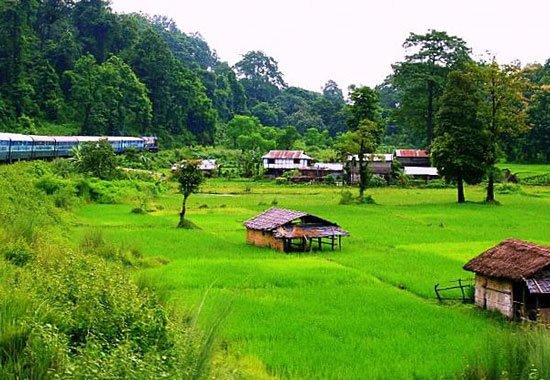
The Dooars or Duars are the floodplains and foothills of the eastern Himalayas in North-East India around Bhutan. Duar means 'door' in Assamese, Bengali, Nepali, Maithili, Bhojpuri, Magahi and Telugu languages, and the region forms the gateway to Bhutan from India. There are 18 passages or gateways through which the Bhutanese people can communicate with the people living in the plains. This region is divided by the Sankosh river into the Eastern and the Western Dooars, consisting of an area of 8,800 km² (3,400 sq mi). The Western Dooars is known as the Bengal Dooars and the Eastern Dooars as the Assam Dooars. Dooars is synonymous with the term Terai used in Nepal and northern India.
The Dooars region politically constitutes the plains of the Darjeeling District, the whole of Jalpaiguri District and the upper region of Cooch Behar District in West Bengal and the districts of Dhubri, Kokrajhar, Barpeta, Goalpara and Bongaigaon in the state of Assam.
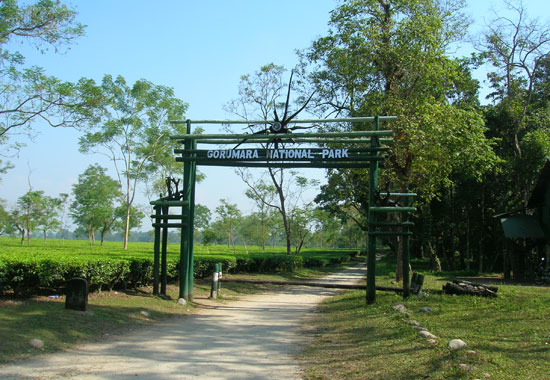
Nearby attractions: Dooars tourism offers multitude options to visitors like trekking, adventure sports and nature trails.The Gorumara National Park at Dooars (Duars) was declared the "Best National Park" in 2010.
Best visit time:Throughout the year.
Dooars is known for having a pleasant weather throughout the year. It can be visited any time through the year. Some visitors prefer visiting the town during the festive season, as the enthusiasm, excitement and unity of the ton is worth seeing then. Not only does festive time gives you the opportunity to know a region culturally more and closely, it also gives you the chance to become a part of a region rather instantly. During November and December, exclusive tourism festival called Teesta Tea and Tourism fest are celebrated, it is a great time to visit the city as these festivals are real fun to be a part of, there are multiple activities, water sports, cultural events happening, it is like the whole of Kolkata has come together at one place to extend a warm welcome to its tourists. During this time, the West Bengal government in collaboration with the Indian Railway run special trains connecting Dooars to Cooch Behar and Siliguri.
Arunachal Pradesh ( North-East )
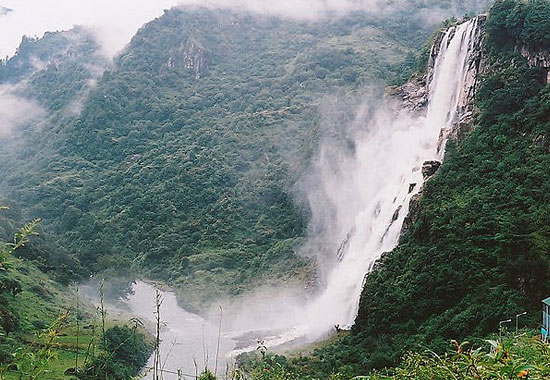
Arunachal Pradesh is one of the twenty-nine states of the Republic of India. Located in northeast India, it holds the most north-eastern position among the states in the north-east region of India.
Arunachal Pradesh, the very first state to see the sun rising up in the sky, offers a healthy list of things to do due to its rich and varied culture. Visit Bomdila and Tawang for ancient monasteries and a beautiful landscape. Wildlife lovers will have an adventurous time at the Namdapha wildlife sanctuary. Shop for handicraft items which are available at all tourist spots. Arunachal Pradesh has many options for outdoor activities with angling, boating, trekking and white water rafting to choose from. Savour the festivities of Arunachal Pradesh in some prominent dance festivals of the state.

Nearby attractions: If the mountains beckon you, you must head for a sightseeing tour to Bomdila and Tawang. At an altitude of 8500 ft, the Himalayan landscape of Bomdila is snowclad for most of the year. The apple orchards and the Buddhist "Gompas" are an added attraction. It is possible to charter a plane from Lilabari to Bomdila as there is a small airstrip there. Or one could use the road route. Be sure to carry carry woollens. From Bomdila, take the mountainous road up to Tawang at 12000 ft. On the way, you'll drive past the Sela Pass, the second highest pass in the world.
Tawang has a 400-year-old Buddhist monastery, which has an 8ft statue of the Buddha and ancient Buddhists scriptures inscribed in gold. Itanagar, the capital city of Arunachal Pradesh, is famous for the excavated ruins of the historical Ita Fort and the Ganga Sekhi Lake. One of the places to see in Arunachal Pradesh is the Ita fort which was made of bricks and parts of it still stand. The Ganga Sekhi Lake, 6km from Itanagar, is a picturesque picnic spot at the base of a red clay hill accessible by a curious bamboo bridge spanning a small culvert.
The wildlife sanctuary at Namdapha is renowned for the four cats - snow leopard, clouded leopard, tiger and the leopard. Home to the rare "hoolok gibbon", it is spread over an amazing range of altitude from 200m to 4500m. It is accessible by road from Tezpur (Assam) and the best time to visit is between October and April.
Best visit time: Arunachal Pradesh has good weather between October and April.
Assam ( North-East )
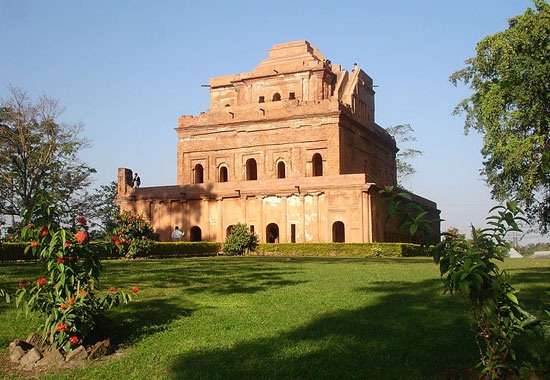
Assam (English pronunciation: About this sound listen (help·info); Assamese: About this sound listen (help·info); Bodo: Bengali: Âshám is a state in northeastern India.
Tourism in Assam is essentially nature-centric and a traveller has many interesting things to do in this beautiful state of North India. For sightseeing, one can go to the temples and wildlife sanctuaries of Assam. Pay your visits to the Kamakhya Temple and the Navagrah Temple in Guwahati. Come and explore the Pabitora Wildlife Sanctuary, the Kaziranga Game Sanctuary, and the Manas National Park, where the call of the wild could not get any wilder!
Shop for Assam silk saris and decorative items made of bamboo canes. Assam offers a wide range of adventurous outdoor activities. One can go for angling, golfing, hang-gliding and para-sailing, rock climbing, trekking, and white water rafting. The three Bihus form the major festivals of Assam, where one can rejoice dancing to the beat of the drums.
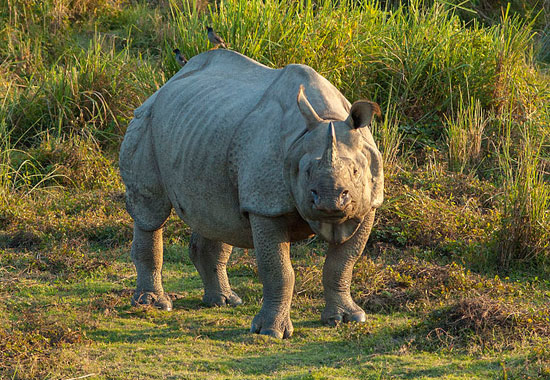
Nearby attractions: Pabitora Wildlife Sanctuary is located 65km from Guwahati. The wildlife plethora includes the one-horned rhinoceros, leopards, tigers and varieties of migratory and non-migratory birds. Accommodation available is forest bungalows – contact the Range Forest Officer, Pabitora, Assam. Driving here from Guwahati is the best option – it is close by and the roads are good.
Assam is best known for the Kaziranga Game Sanctuary covering an area of 430 km. Home to the highly endangered one-horned rhino, one can also spot elephants, sloth bears, tigers, leopard cats, jungle cats, hog badgers, capped langurs, hoolock gibbons, pigs, jackals, porcupines, pythons, buffaloes, Indian bisons, swamp deer, sambhars and hog deer from very close quarters.
Best visit time: The best time to visit Assam would be November to May when cool winds from the Himalayan foothills temper the heat and humidity. March to May is when the orchids are in bloom; the people are joyous and festive and the Bihu (harvest festival) drums resonate in the valley. Assam is best avoided during the rains (June to September) when heavy downpours cause the Brahmaputra River to flood its banks all across the state.
Manipur ( North-East )
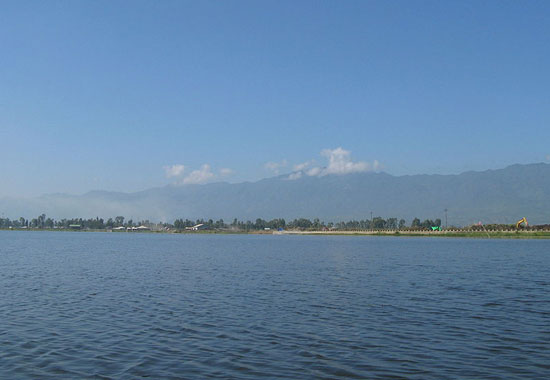
Manipur is a state in northeastern India, with the city of Imphal as its capital. Manipur is sometimes called alternative names such as Kangleipak or Sanaleibak. It is bounded by Nagaland to the north, Mizoram to the south, and Assam to the west; Burma lies to its east. The state covers an area of 22,327 square kilometres (8,621 sq mi). Its people include the Meetei, Kuki, Naga, and Pangal peoples, who speak Sino-Tibetan languages. Manipur has been at the crossroads of Asian economic and cultural exchange for more than 2,500 years. It has long connected the Indian subcontinent to Southeast Asia, enabling migration of people, cultures and religions.
The lush green state of Manipur provides a tourist with a lot of interesting things to do. Visit the capital city, Imphal and take a sightseeing tour to the Manipur State Museum, the Khwairamband market, and the well maintained British War Cemetery. Take a trip to the beautiful town of Langthabal near Imphal, the Andro village for its cultural heritage, and Khongjom town for its historical importance.
Nature lovers can visit the Loktak Lake, the Keibul Lemjao National Park, the Manipur Zoological Garden, and the Khongkhampat Orchidarium, which are some of the best places to see in Manipur.
Shopaholics will have a great time shopping at the Khwairamband market, which is popular for its eye-catching fabrics and household items. One can also collect mementoes from the outskirts of the market, and handicrafts from GM Hall and Paona Bazaar.
Adventure activities in Manipur include boating, camping, and trekking. Lai-Haraoba, Dol Yatra, Rath Yatra, and Durga Puja form the major festivals of Manipur.
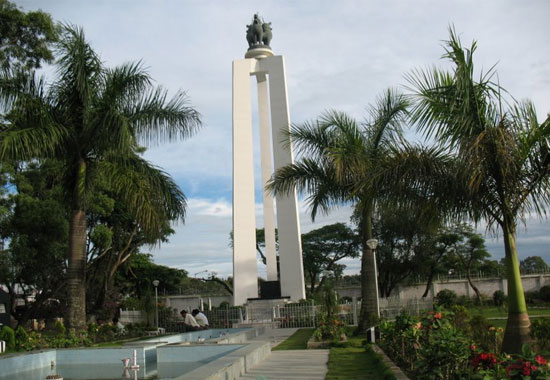
Nearby attractions: There are plenty of sightseeing places in Manipur and all of it may not be possible to cover in one visit. It makes a good deal of sense to base your excursions in Imphal, the capital, which is well connected to the rest of the state.
At the centre of Imphal is the fascinating market of Khwairamband run by more than 3000 tribal women that is in two sections – one sells shawls, textiles and fabrics including the traditional dress of the "Meithei" tribe of Manipur called "phanek" and the other sells basic household provisions. On the outskirts of the market are smaller ones that sell cane and wicker products. Bargaining is common though language may prove to be a barrier. There are several fixed price shops that sell handloom and handicrafts at GM Hall and Paona Bazaar. Imphal's Polo Ground is said to have given birth to the sport. The Manipur State Museum is a good place to visit in Manipur and focuses on ethnological, geological and archaeological exhibits. Of special interest are the displays of tribal jewellery, costumes and weapons.
Manipur's prominent temple is Shree Govindjee, that has a nice atmosphere but is not architecturally pleasing to the eye. If you want to be a part of the traditional "puja" or worship, visit the temple early in the morning. The British War Cemetery is beautifully maintained by the Commonwealth War Graves Commission and commemorates the lives of British and Indian soldiers who were killed during the Burma War. Most of these soldiers were in the age group of 18 to 21 years.
8 km from Imphal is Langthabal, a small hill town replete with relics from the past, well planned temples and ceremonial hoses amidst pine and jackfruit trees planted symmetrically.
Andro is an ancient village where scheduled castes live, 27 km east of Imphal. It has a Cultural Complex displaying the pottery of northeast India. There is also a 'Doll-House' where dolls of 29 recognised tribes of Manipur are on display.
Keibul Lamjao National Park, 53km from Imphal, on the fringes of Loktak Lake, is the last natural habitat of the marsh-dwelling brow-antlered deer called "Sangai". A large number of migratory birds, like waterfowl, are also attracted to this Park. 48km south of Imphal is another good sightseeing place, the Loktak Lake, fed by many rivers and dotted with many islands. It is home to an unusual community of fishermen who live on large rafts made of reeds.
A large part of this lake is taken up by the Keibul Lamjao National Park. If you want to view the Lake from a vantage point try the Sendra Island. On the western shore of Loktak Lake is the small town of Moirang with a historical past. It was here that Netaji Subhas Chandra Bose, an Indian freedom fighter, hoisted the first flag of independent India in 1943. Bose fought alongside the Japanese army to oust the British from India. A memorial and a museum with interesting photographs and Japanese currency is worth a visit.
On National Highway 39, 12km north of Imphal, is the Khongkhampat Orchidarium with hundreds of varieties of orchids that bloom in April and May.
Khongjom is a 36 km drive away from Imphal and is situated on the Indo Burma Road. It is historically important because one of its generals, Paona Brajabashi, fought against the British and refused to suttender. A war memorial on the top of this scenic hill adds charm to the heroic reminders of this site. Khongjom day is celebrated as a State Holiday on every year on April 23.
The Manipur Zoological Garden is a sylvan picnic spot at the foot of pine-growing hillocks 6km west of Imphal, on the Imphal Kangchup Road. You will also spot the rare "sangai" deer here.
Best visit time: The best time to visit Manipur is between October and March when state experiences a mild and pleasant winter full of sunshine.
Meghalaya ( North-East )
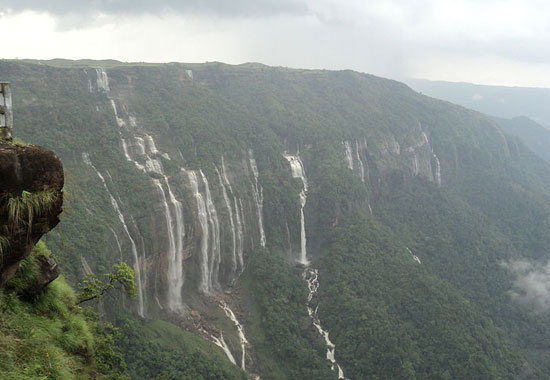
Meghalaya is a state in north-east India. The name means "the abode of clouds" in Sanskrit. The population of Meghalaya as of 2014 is estimated to be 3,211,474. Meghalaya covers an area of approximately 22,430 square kilometers, with a length to breadth ratio of about 3:1.
The North-Eastern state of Meghalaya, renowned for its nature and scenic beauty offers a traveller with several options on what to do in Meghalaya. One can take a trip to the picturesque city of Shillong and visit the lakes, waterfalls, churches, and parks. The Barapani Lake and the enchanting caves of Siju are worth a visit.
Shopping in Meghalaya is all about buying orange honey, and handmade shawls. Adventure enthusiasts will have a wonderful time in Meghalaya, as there are many things to do like angling, boating, caving, golfing, trekking, and various water sports.
Festivals in Meghalaya are a significant occasion to celebrate and make merry. The Nongkrem Dance, Wangala Dance, and Behdienkhlam are major festivals celebrated by the Khasi, Garo, and Jaintia tribes, respectively.
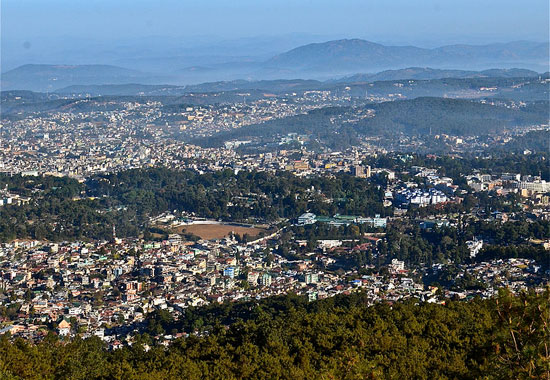
Nearby attractions: The beautiful Meghalaya is full of sightseeing options and you should seriously consider the capital, Shillong (1500 m), as your next holiday destination. Set amidst gently rolling hills surrounded by pines, and reminiscent of the Scottish moors, this was a favorite holiday resort during the days of the British.
Despite the inevitable expansion in recent years, Shillong retains much of its former charm - boating in the lake, pleasant walks, golf and a peaceful ambiance. The drive up winding mountain roads from Guwahati to Shillong made it even more picturesque by the Barapani Lake (Umiam) which is now being developed as a water sports center.
While in Shillong city you can see the Ward's Lake that is surrounded with pine groves. Other places to visit in Shillong are the Lady Hydari Park and a miniature zoo. Other than this the city has cathedral, waterfalls and mountain peaks which are all worth paying a visit.
Siju in the Garo hills (near Bangladesh in the west), is where you will find Meghalaya's most spectacular limestone caves. Indeed, there are over 150 caves spread across the state, some stretching to several kms in length! On the way to the limestone caves near Mawsynram you would pass a group of megaliths near a stream. This is one of the many megalithic sites across the state, and of great interest to historians and anthropologists.
Best visit time: Visit Meghalaya any time of the year except the rainy season, which is June to September.
Mizoram ( North-East )
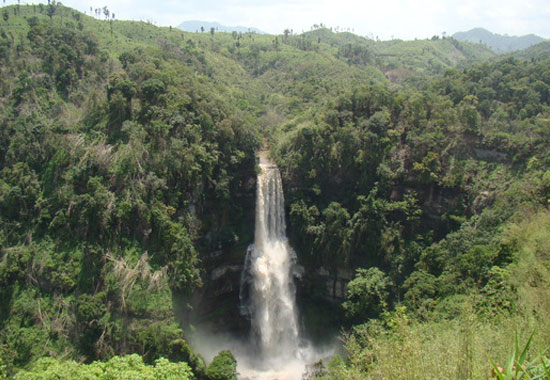
Mizoram is one of the states of Northeast India, with Aizawl as its capital city. The name is derived from Mi (people), Zo (Belonging to the people of Mizoram/Lushai Hills) and Ram (land), and thus Mizoram implies "land of the hill people". In the northeast, it is the southern most landlocked state sharing borders with three of the Seven, now with the addition of (Sikkim,) Eight sister states, namely Tripura, Assam, Manipur. The state also shares a 722 kilometer border with the neighbouring countries of Bangladesh and Myanmar.
The picturesque beauty and various tourist attractions in Mizoram provide a traveller with several options on what things to do here. Visit Aizawl, the capital city, for its beautiful churches and shopping areas; Durtlang Hills, Tamdil Lake, Champai, and Ruantlang for their scenic beauty. Take a trip to Dampa wildlife sanctuary which houses East Himalayan wild animals.
Go shopping to the Bada Bazaar in Aizawl, for exclusive handicrafts, handloom items and a variety of souvenirs. Outdoor activities in Mizoram range from angling and boating to camping, caving, trekking and mountaineering. The major festivals of Mizoram centre on agriculture and have many dances associated with them. The three Kut Festivals are the most significant festivals of the state.
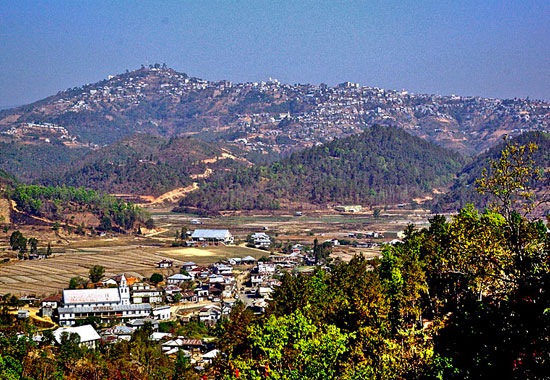
Nearby attractions: The opportunities for sightseeing and places to see in Mizoram are many.
The capital city, Aizawl, stands like a citadel watching over the valleys of Mizoram. White churches dot the landscape of this small city. If you are shopping for souvenirs, a visit to the Bara Bazaar and the Luangmual Handicrafts Centre will get you the most beautiful bamboo hats and shawls. The Mizoram State Museum is located in the centre of the town and the displays are scanty but give you an idea of Mizoram's culture and history. This is closed on Saturdays and Sundays.
For breathtaking views of blue hazed hills and vales, head to Phawangpui, also known as the Blue Mountain. It is the highest peak in Mizoram at an altitude of 7100 feet above sea level. The Durtlang Hills, south of Aizawl, are high ridges punctuated by small villages and Christian convents. This area is ideal for day-hikes from Aizawl. The beauty of the hills is punctuated by silver cascades as waterfalls crash their way down green clad, mist covered hills.
Another place to visit in Mizoram is the Tamdil Lake, which is 60km away from Aizawl and will take you three hours by road. It is a scenic and peaceful picnic spot that also has fish farms. Champai, 192km from Aizawl, is picturesque with rhododendrons crowding the surrounding hills. 5km away is Ruantlang, a village where the traditional Mizo way of life has been preserved.
Dampa is a huge wildlife sanctuary easily accessible from Aizawl by hired 4WDs. Sprawling over 572 sq. km., it is home to East Himalayan wild animals like tigers, bears, bisons and bears. It is a favourite destination of butterfly and bird enthusiasts.
Best visit time: November to March is the best time to visit Mizoram with the mercury dropping to a comfortable range between 11º and 29°C. The sky is a brilliant blue and the morning mists envelope the valleys between the hills presenting a visual treat. This is lovely time to go trekking in the hills and also see nature at it's very best.
The rains come in May to Mizoram and continue till September making the region very wet and humid. So it may be best to avoid travel here at this time of the year.
The Mizos celebrate an agarian festival called 'Kut' and it is celebrated thrice a year - March, September and then again in November. The festivities are connected with the planting, ploughing, and harvesting of the crops. Christmas is also celbrated with fervour all over Mizoram.
Nagaland ( North-East )
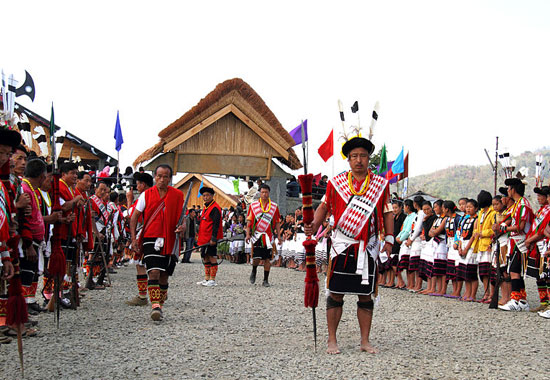
Nagaland is a state in Northeast India. It borders the state of Assam to the west, Arunachal Pradesh and part of Assam to the north, Burma to the east and Manipur to the south. The state capital is Kohima, and the largest city is Dimapur. It has an area of 16,579 square kilometres (6,401 sq mi) with a population of 1,980,602 per the 2011 Census of India, making it one of the smallest states of India.
Nagaland being well-known for its natural beauty provides a tourist with many interesting things to do. Take a trip to Kohima and visit the Commonwealth War Cemetery for its well maintained garden and memorial, Khonoma Village, Japfu Peak, Dzukou Valley, and Phek for picturesque landscapes. Come down to the city of Dimapur for its appealing stone megaliths. Visit the Intaki Wildlife Sanctuary which is a dwelling place for some of the rare wild animals.
Go shopping for vibrant Naga shawls, handicrafts, and many other artefacts that make attractive souvenirs. Nagaland has some interesting outdoor activities to offer like, angling, camping, and trekking. The Dzukou Valley, along with the rivers flowing in the state, is an ideal site for these activities. Sekrenyie, Tuluni, Tsungrem Mong, and Tokhu Emong are major festivals celebrated by the Angami Nagas, Sema Nagas, Ao Nagas, and Lotha Nagas, respectively.

Nearby attractions: Nagaland has quite a few interesting sightseeing options, with plenty of places to visit and see.
The Commonwealth War Cemetery in Kohima is an immaculate garden that is a reminder of the Japanese invasion during World War II. It is estimated that about 10,000 Allied soldiers lost their lives in the Battle of Kohima that lasted for three months. The Bara Basti is balanced on a high hill over looking Kohima. The village maintains its traditional Naga look and feel. The State Museum is a small but fascinating ethnological collection of the Naga tribes.
Khonoma Village is 20 km to the west of Kohima. This was once a Naga stronghold and is replete with tales of the heroic deeds of its warriors against the British army in the 19th century. You may need to hire a vehicle to visit Khonoma from Kohima as the bus service is infrequent and erratic. Japfu Peak is a trekking terrain some 15 km from Kohima. It has a beautiful view of the city and the snow clad Himalayas.
Another sightseeing place, Dzukou Valley is at 2,462 m above sea level, 25 km from Kohima. Between November and March the valley is dotted with red and white rhododendron, lilies and wild flowers. Treks in the valley could be the highpoint of your travel. Phek is famous for its orchids and rare birds. It is 134 km from Kohima.
Dimapur is the only other city in Nagaland besides Kohima. It is the hub of commercial and industrial activity. It means the `City of River people'. It is the only city that is in a valley and looks like a saddle joining two hills. Here there are interesting menhirs (stone megaliths) that have been erected by the tribes to honour fame and generosity. Dimapur has decent mid range and budget accommodation.
Among the other places to visit in Nagaland is the Intaki Wildlife Sanctuary, which is home to the rare Hoolok gibbon, elephant, wild buffalo ('Mithun'), sambhar, barking deer, flying squirrel, wild dog, tiger, sloth bear, pheasant, hornbill and black stork. It is 111 km from Kohima and 37 km from Dimapur.
Best visit time: The best time to visit Nagaland is between October and May when it doesn't rain. Nagaland gets torrential rain between June and September when communications can be severely disrupted.
Sikkim ( North-East )
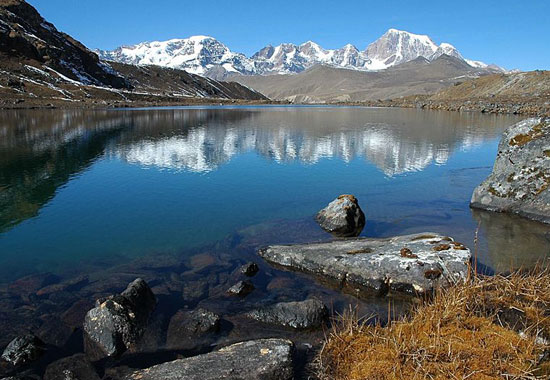
In the eastern Himalayas, Sikkim is a lovely state located in the unfathomable mountains and abrupt valleys. Sikkim is placed between latitudes of 27° 5' N to 20° 9' N and longitudes of 87° 59' E to 88° 56' E. Positioned in north-east, Sikkim is the second smallest state of India. Sikkim is sandwiched between Nepal in the west and Bhutan in the east, China in the north and West Bengal in the south. The Indian border of Sikkim is shared only with the state of West Bengal.
Sikkim is a popular tourist destination and due to its rich culture, scenic beauty, and landscapes, provides an endless list of things to do here. One may go sightseeing to the beautiful monasteries in the capital city, Gangtok. Visit the Changu Lake which mostly remains frozen throughout the year. Mt Kanchenjunga which is a delightful sight can be seen from endless viewpoints. One may also visit the various lakes, and villages for sightseeing.
Go shopping for some eye-catching artefacts and handicrafts, easily available at the main shopping centres of Gangtok. Outdoor activities in Sikkim include hang gliding, kayaking and canoeing, mountain biking, river rafting, trekking, and mountaineering. Visit Sikkim during its religious festivals well known for their mask dances. Some of the major festivals here are: Saga Dawa, Phang Lhabsol, and Dasain.
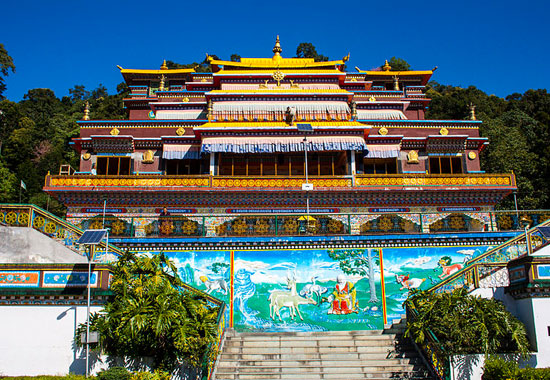
Nearby attractions: There are plenty of extraordinary places to see in Sikkim. Most of them are nature's marvels; some of them are remote and esoteric Tibeto-Buddhist Monasteries. Dzongri is the region for treks. Gangtok is the capital city that now retains very few of its traditional Sikkimese elements. It is a modern hill station with every amenity you may possibly want. Although people visit to savour the marvelous temperate weather, the Buddhist past of the city also has tremendous appeal.
Take a sightseeing tour to The Institute of Tibetology and the Enchey Monastery in Gangtok as well as the Rumtek Monastery 24km east of Gangtok, which are well-frequented tourist destinations. A couple of hundred metres from the Institute of Tibetology is the Do-Drul Chorten, one of the most important "gompas" (Tibeto-Buddhist temples) in Sikkim. It is capped by a golden tower, surrounded by numerous coloured scarves fluttering in the wind and has 108 prayer wheels. The devotees rotate the prayer wheels in a clockwise direction as they circulate the stupa.
For a truly unforgettable experience visit the sacred and serene Changu Lake (3780 m, 12400 ft), 40 km eastwards of Gangtok. The lake remains frozen for the greater part of the year and comes alive during May to August when rhododendrons, irises, primulas and poppies burst into bloom on its banks and on the adjoining hill slopes.
The main attraction in West Sikkim is the exciting treks on a variety of routes, including the Kanchenjunga trek that takes you to Dzongri at the base of the peak. Yoksum is the start to the Dzongri Trail. Unless you have a Dzongri trek permit, you cannot venture beyond Yoksum. The other major points of interest in West Sikkim are the monasteries at Pemayangtse and Tashiding and the interesting little hamlet of Pelling.
Another place to visit is the Khecheopalri Lake, which lies 33 Kms to the northwest of Pelling. It is also known as the Wishing Lake and is sacred to the tribal Lepchas. Jorethang is the most important town in west Sikkim, well connected by buses and 4WDs from the rest of the state. The town has decent accommodation should anyone want to make it their base. South Sikkim, at lower altitudes than Western Sikkim, has its own beauty and charm with a few interesting trekking destinations such as Tendong Hill, the Versey Rhododendron Sanctuary and Menam Hill.
With bleak and barren mountain peaks, North Sikkim is the land of the nomadic Yak herdsmen. All tourists require a Permit to visit North Sikkim; the permit can be obtained in Gangtok.
The traditional "Lepcha" village at Chungthang, the view of the magnificent Kanchenjunga peak at Singhik and the remote and flower-bedecked valley at Yumthang are the biggest attractions in this part of Sikkim. Several high altitude treks (6000-7000m) are now possible for the experienced mountaineer in North Sikkim. Green Lake is the base for climbing expeditions.
Best visit time: The best time to visit Sikkim is between March and May when the flowers are in bloom, or between October and mid-December when clear views of the Himalayan peaks are guaranteed. June to September brings heavy rains causing landslides that often disrupt communication. January and February means snow in the higher altitudes and visits to many of the tourist spots are not possible.
Tripura ( North-East )

Tripura is a state in Northeast India. The third-smallest state in the country, it covers 10,491 km2 (4,051 sq mi) and is bordered by Bangladesh (East Bengal) to the north, south, and west, and the Indian states of Assam and Mizoram to the east. In 2011 the state had 3,671,032 residents, constituting 0.3% of the country's population. The Bengali Hindu people form the ethno-linguistic majority in Tripura. Indigenous communities, known in India as scheduled tribes, form about 30 per cent of Tripura's population. The Kokborok speaking Tripuri people are the major group among 19 tribes and many subtribes.
Exploring old palaces, beautiful gardens and interesting temples is all included in the list of 'things to do' in Tripura. Visit the Ujjayanta Palace, Tripura Sundari temple or the unique Neermahal. Take an exciting boat ride on the arresting Rudrasagar Lake or try trekking to the highest peak of Tripura, Betalongchhip, the beautiful landscape and soothing climate will make your visit a memorable one.
Shop for lovely hand woven cotton fabrics or buy some decorative handicrafts and tribal jewellery for friends back home. Tripura's cultural diversity can be seen in its traditional cuisine. While in Tripura, don't forget to try the delicious and unique preparation of fish, the boiled 'Hilsa,' punched with mustard seed and green chilly. The inimitable tastes, tribal culture etc will surely make your trip to Tripura all the more enjoyable.
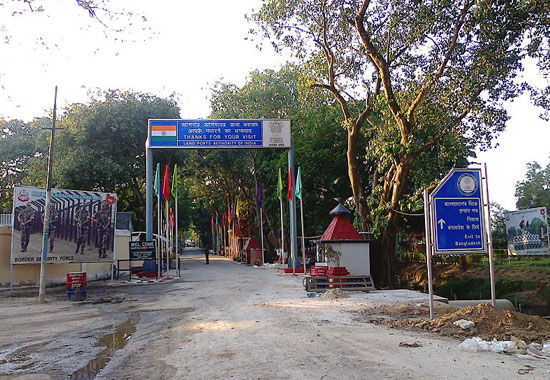
Nearby attractions: A traveller has a wide variety of sightseeing options in Tripura. Tripura is synonymous with palaces that were former residences of the opulence-loving Maharajas of the Manikya dynasty. The Ujjayanta Palace in Agartala stands on the banks of a small lake surrounded by huge Mughal gardens. Built in 1901, the architecture is an interesting mix of Mughal and European influences. Home to the legislative assembly now, it is not usually open to public. If you go to the front gate between 3pm and 4pm, you may get an entry pass. The temples of Ummaneshwar and Jagannath in the grounds of this palace are open to all.
The Tripura Sundari temple is 57km from Agartala in the ancient capital of the state, Udaipur. The temple was built on Dhanisagar hill in mid-16th century. It is dedicated to the Mother Goddess and served by red robed priests. The pond behind the temple has huge turtles that love to be fed.
The Governor of Tripura now lives in a palace that was built in 1917 and named the "Kunjaban Palace" by Birendra Krishna Manikya, a km away from the Ujjayanta Palace. The Maharaja himself designed the palace and Nobel Laureate Rabindranath Tagore was an occasional guest. Also worth seeing are the ethnological displays in the State Museum on HGB Road, Agartala.
Other places to visit include Sipahijala, located 33km from Agartala. It is a botanical garden with a beautifully kept small zoo. The lake here attracts migratory birds and the enclosures have animals like tigers, cheetahs, lions, bears, monkeys and a rhino. Elephant rides and boating in the lake are added attractions.
53km to the south of Agartala is the water-palace, Neermahal, built in 1930 in the middle of Rudrasagar Lake. Boatmen will row you across the lake to the palace, which is a fairy tale delight in striking white and red. The palace has towers, open pavilions, summerhouses and little bridges, making it a great place to explore. Presently being restored, this palace is particularly beautiful at night with the floodlights lit.
Best visit time: Tripura is best visited from October to May. Heavy seasonal rains from June to September often disrupt life and vital communications.
